Quick filters:
Han dynasty art Stock Photos and Images
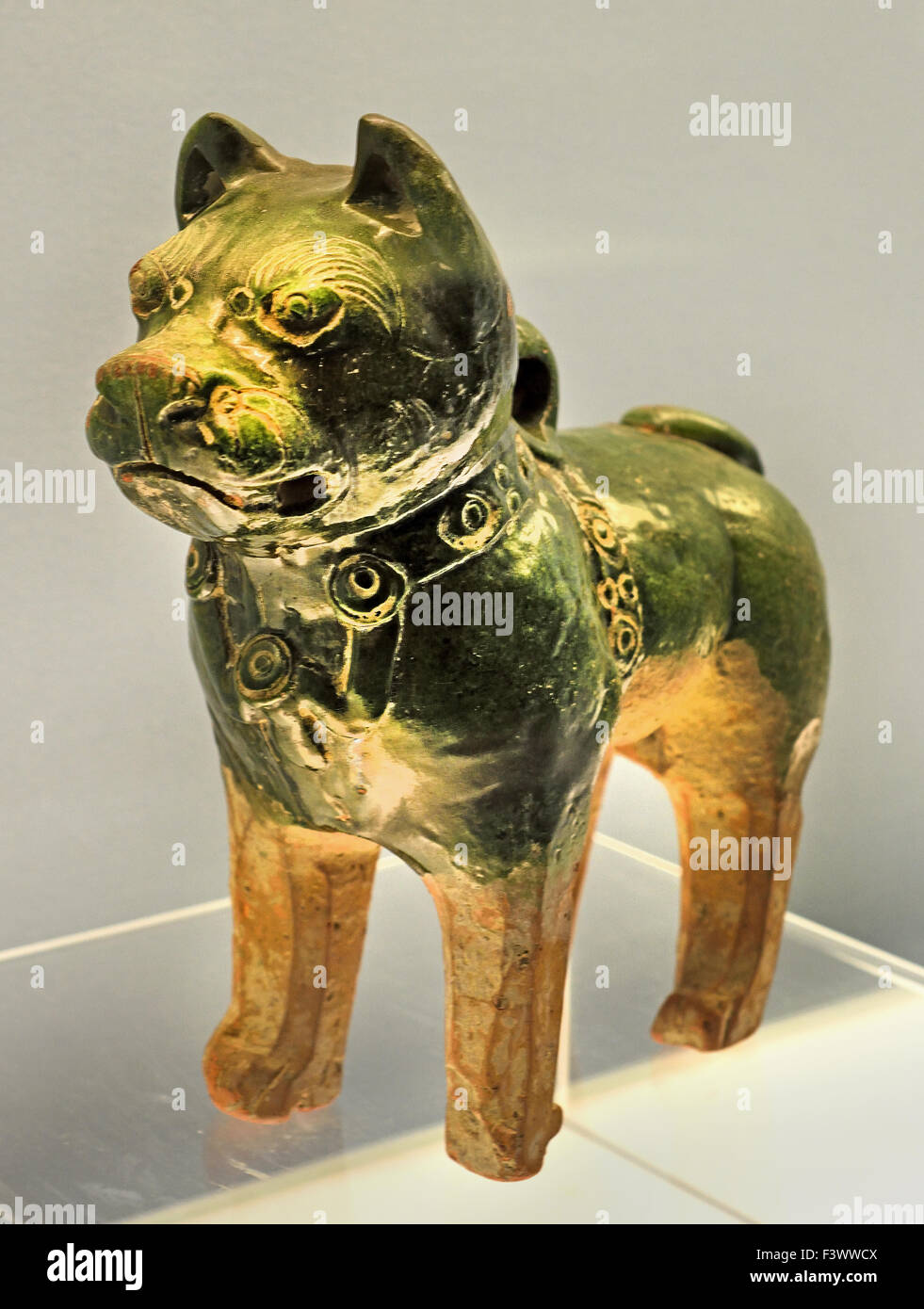 Green Glazed Pottery Dog 25 - 220 AD Eastern Han Dynasty ( Shanghai Museum of ancient Chinese art ) China Stock Photohttps://www.alamy.com/image-license-details/?v=1https://www.alamy.com/stock-photo-green-glazed-pottery-dog-25-220-ad-eastern-han-dynasty-shanghai-museum-88464570.html
Green Glazed Pottery Dog 25 - 220 AD Eastern Han Dynasty ( Shanghai Museum of ancient Chinese art ) China Stock Photohttps://www.alamy.com/image-license-details/?v=1https://www.alamy.com/stock-photo-green-glazed-pottery-dog-25-220-ad-eastern-han-dynasty-shanghai-museum-88464570.htmlRMF3WWCX–Green Glazed Pottery Dog 25 - 220 AD Eastern Han Dynasty ( Shanghai Museum of ancient Chinese art ) China
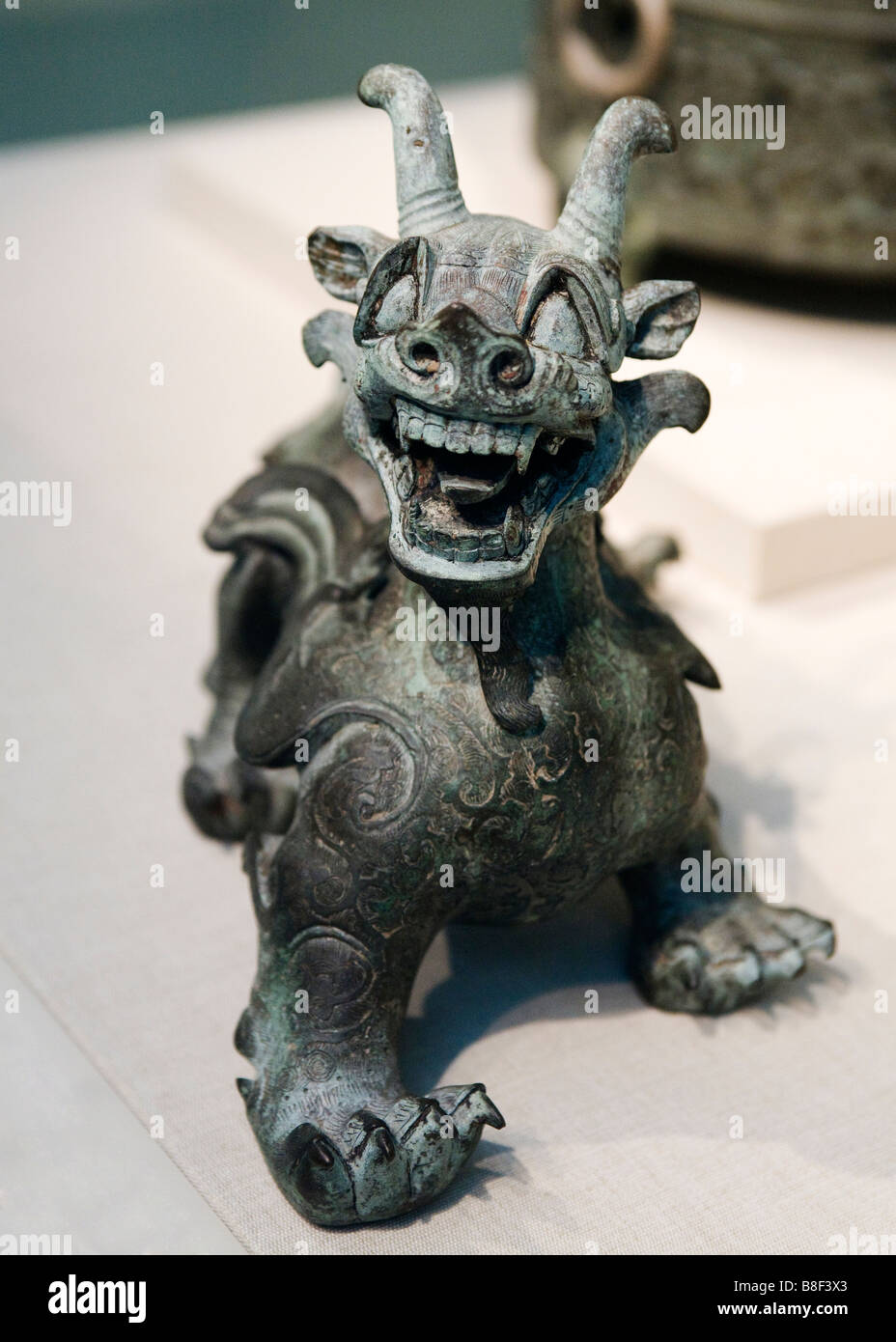 Chimera - China, Eastern Han dynasty ca. A.D. 100 Stock Photohttps://www.alamy.com/image-license-details/?v=1https://www.alamy.com/stock-photo-chimera-china-eastern-han-dynasty-ca-ad-100-22459979.html
Chimera - China, Eastern Han dynasty ca. A.D. 100 Stock Photohttps://www.alamy.com/image-license-details/?v=1https://www.alamy.com/stock-photo-chimera-china-eastern-han-dynasty-ca-ad-100-22459979.htmlRMB8F3X3–Chimera - China, Eastern Han dynasty ca. A.D. 100
 Lintel from a tomb, , Chinese, Western Han dynasty, 1st century BC Stock Photohttps://www.alamy.com/image-license-details/?v=1https://www.alamy.com/lintel-from-a-tomb-chinese-western-han-dynasty-1st-century-bc-image634319958.html
Lintel from a tomb, , Chinese, Western Han dynasty, 1st century BC Stock Photohttps://www.alamy.com/image-license-details/?v=1https://www.alamy.com/lintel-from-a-tomb-chinese-western-han-dynasty-1st-century-bc-image634319958.htmlRM2YRYNG6–Lintel from a tomb, , Chinese, Western Han dynasty, 1st century BC
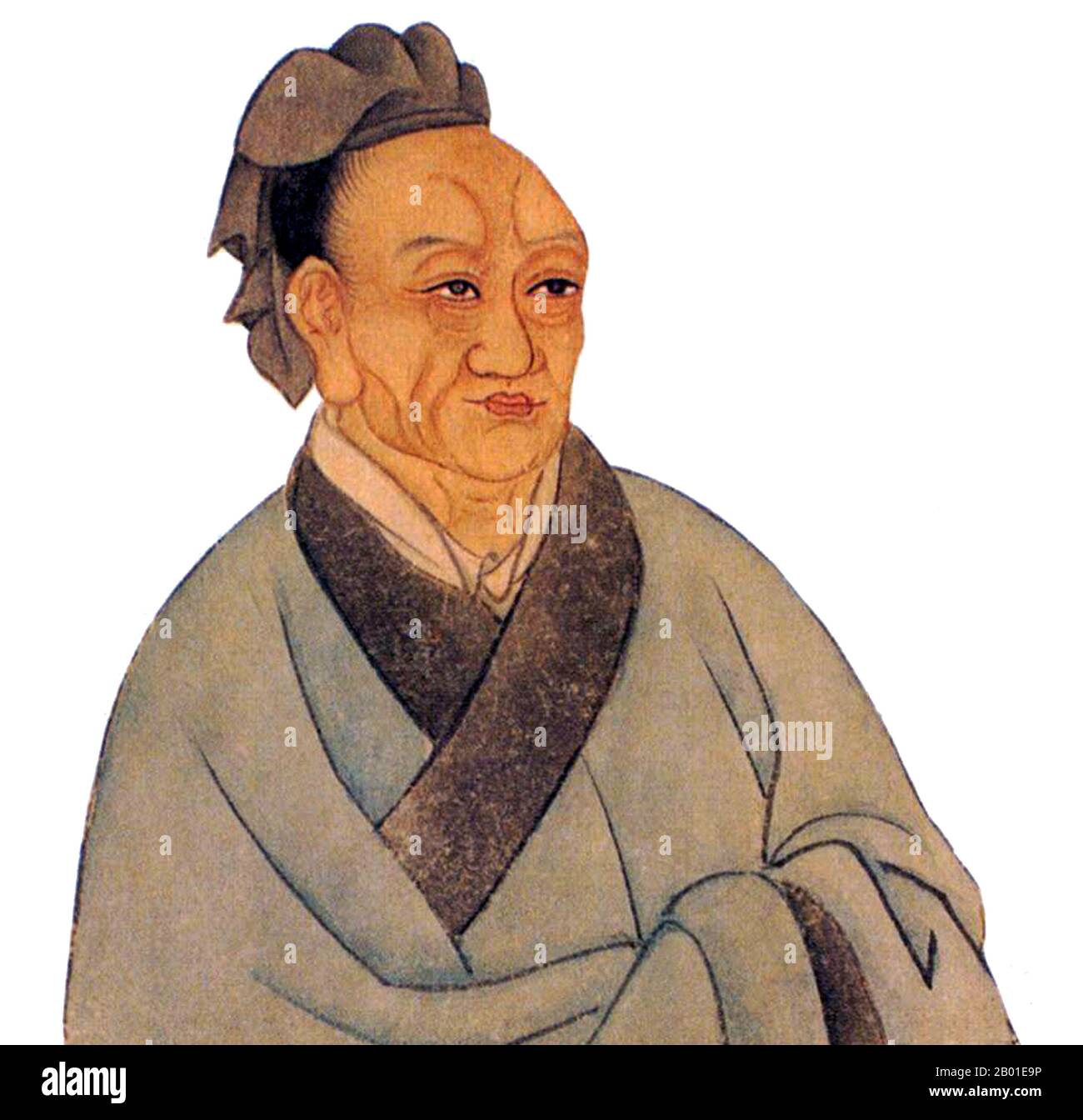 China: Sima Qian (c. 145-86 BCE), Father of Chinese historiography and 'Grand Historian' of China, early Han Dynasty (206 BCE - 220 CE). Sima Qian (Wade-Giles: Ssu-ma Ch'ien) was a Prefect of the Grand Scribes (太史公) of the Han Dynasty. He is regarded as the father of Chinese historiography for his highly praised work, Records of the Grand Historian, a 'Jizhuanti'-style general history of China, covering more than two thousand years from the Yellow Emperor to Emperor Wu of Han. His definitive work laid the foundation for later Chinese historiography. Stock Photohttps://www.alamy.com/image-license-details/?v=1https://www.alamy.com/china-sima-qian-c-145-86-bce-father-of-chinese-historiography-and-grand-historian-of-china-early-han-dynasty-206-bce-220-ce-sima-qian-wade-giles-ssu-ma-chien-was-a-prefect-of-the-grand-scribes-of-the-han-dynasty-he-is-regarded-as-the-father-of-chinese-historiography-for-his-highly-praised-work-records-of-the-grand-historian-a-jizhuanti-style-general-history-of-china-covering-more-than-two-thousand-years-from-the-yellow-emperor-to-emperor-wu-of-han-his-definitive-work-laid-the-foundation-for-later-chinese-historiography-image344240562.html
China: Sima Qian (c. 145-86 BCE), Father of Chinese historiography and 'Grand Historian' of China, early Han Dynasty (206 BCE - 220 CE). Sima Qian (Wade-Giles: Ssu-ma Ch'ien) was a Prefect of the Grand Scribes (太史公) of the Han Dynasty. He is regarded as the father of Chinese historiography for his highly praised work, Records of the Grand Historian, a 'Jizhuanti'-style general history of China, covering more than two thousand years from the Yellow Emperor to Emperor Wu of Han. His definitive work laid the foundation for later Chinese historiography. Stock Photohttps://www.alamy.com/image-license-details/?v=1https://www.alamy.com/china-sima-qian-c-145-86-bce-father-of-chinese-historiography-and-grand-historian-of-china-early-han-dynasty-206-bce-220-ce-sima-qian-wade-giles-ssu-ma-chien-was-a-prefect-of-the-grand-scribes-of-the-han-dynasty-he-is-regarded-as-the-father-of-chinese-historiography-for-his-highly-praised-work-records-of-the-grand-historian-a-jizhuanti-style-general-history-of-china-covering-more-than-two-thousand-years-from-the-yellow-emperor-to-emperor-wu-of-han-his-definitive-work-laid-the-foundation-for-later-chinese-historiography-image344240562.htmlRM2B01E9P–China: Sima Qian (c. 145-86 BCE), Father of Chinese historiography and 'Grand Historian' of China, early Han Dynasty (206 BCE - 220 CE). Sima Qian (Wade-Giles: Ssu-ma Ch'ien) was a Prefect of the Grand Scribes (太史公) of the Han Dynasty. He is regarded as the father of Chinese historiography for his highly praised work, Records of the Grand Historian, a 'Jizhuanti'-style general history of China, covering more than two thousand years from the Yellow Emperor to Emperor Wu of Han. His definitive work laid the foundation for later Chinese historiography.
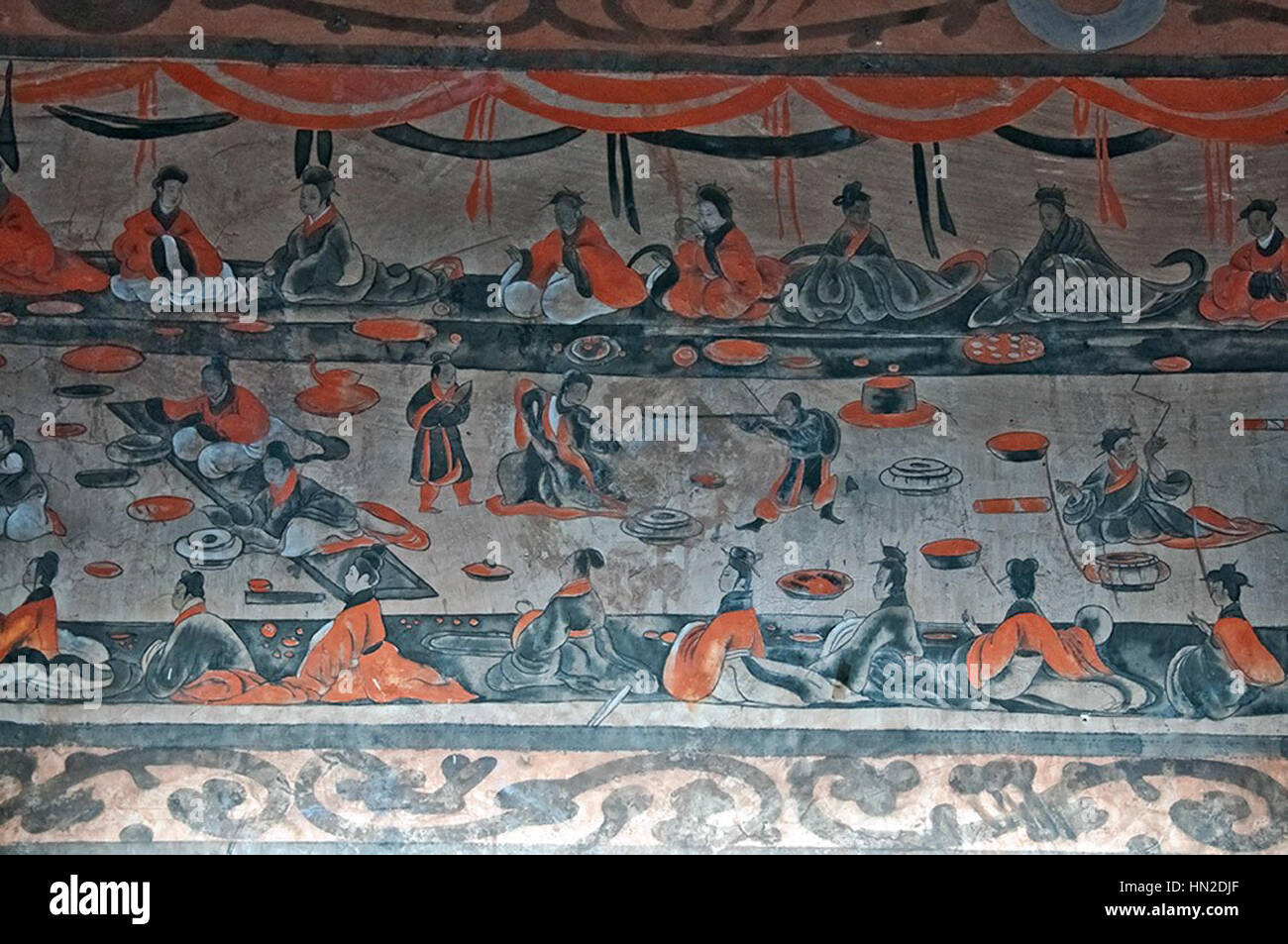 Mural Painting of a Banquet Scene from the Han Dynasty Tomb of Ta-hu-t'ing Stock Photohttps://www.alamy.com/image-license-details/?v=1https://www.alamy.com/stock-photo-mural-painting-of-a-banquet-scene-from-the-han-dynasty-tomb-of-ta-133434967.html
Mural Painting of a Banquet Scene from the Han Dynasty Tomb of Ta-hu-t'ing Stock Photohttps://www.alamy.com/image-license-details/?v=1https://www.alamy.com/stock-photo-mural-painting-of-a-banquet-scene-from-the-han-dynasty-tomb-of-ta-133434967.htmlRMHN2DJF–Mural Painting of a Banquet Scene from the Han Dynasty Tomb of Ta-hu-t'ing
 Pottery hu, Western Han dynasty, China, late 2nd century BC. Artist: Unknown Stock Photohttps://www.alamy.com/image-license-details/?v=1https://www.alamy.com/pottery-hu-western-han-dynasty-china-late-2nd-century-bc-artist-unknown-image60084609.html
Pottery hu, Western Han dynasty, China, late 2nd century BC. Artist: Unknown Stock Photohttps://www.alamy.com/image-license-details/?v=1https://www.alamy.com/pottery-hu-western-han-dynasty-china-late-2nd-century-bc-artist-unknown-image60084609.htmlRMDDN2EW–Pottery hu, Western Han dynasty, China, late 2nd century BC. Artist: Unknown
 disc with two animals in relief, Han dynasty, Han dynasty, jade, Diam: 6 in., Asian Art Stock Photohttps://www.alamy.com/image-license-details/?v=1https://www.alamy.com/disc-with-two-animals-in-relief-han-dynasty-han-dynasty-jade-diam-6-in-asian-art-image328773045.html
disc with two animals in relief, Han dynasty, Han dynasty, jade, Diam: 6 in., Asian Art Stock Photohttps://www.alamy.com/image-license-details/?v=1https://www.alamy.com/disc-with-two-animals-in-relief-han-dynasty-han-dynasty-jade-diam-6-in-asian-art-image328773045.htmlRM2A2TWAD–disc with two animals in relief, Han dynasty, Han dynasty, jade, Diam: 6 in., Asian Art
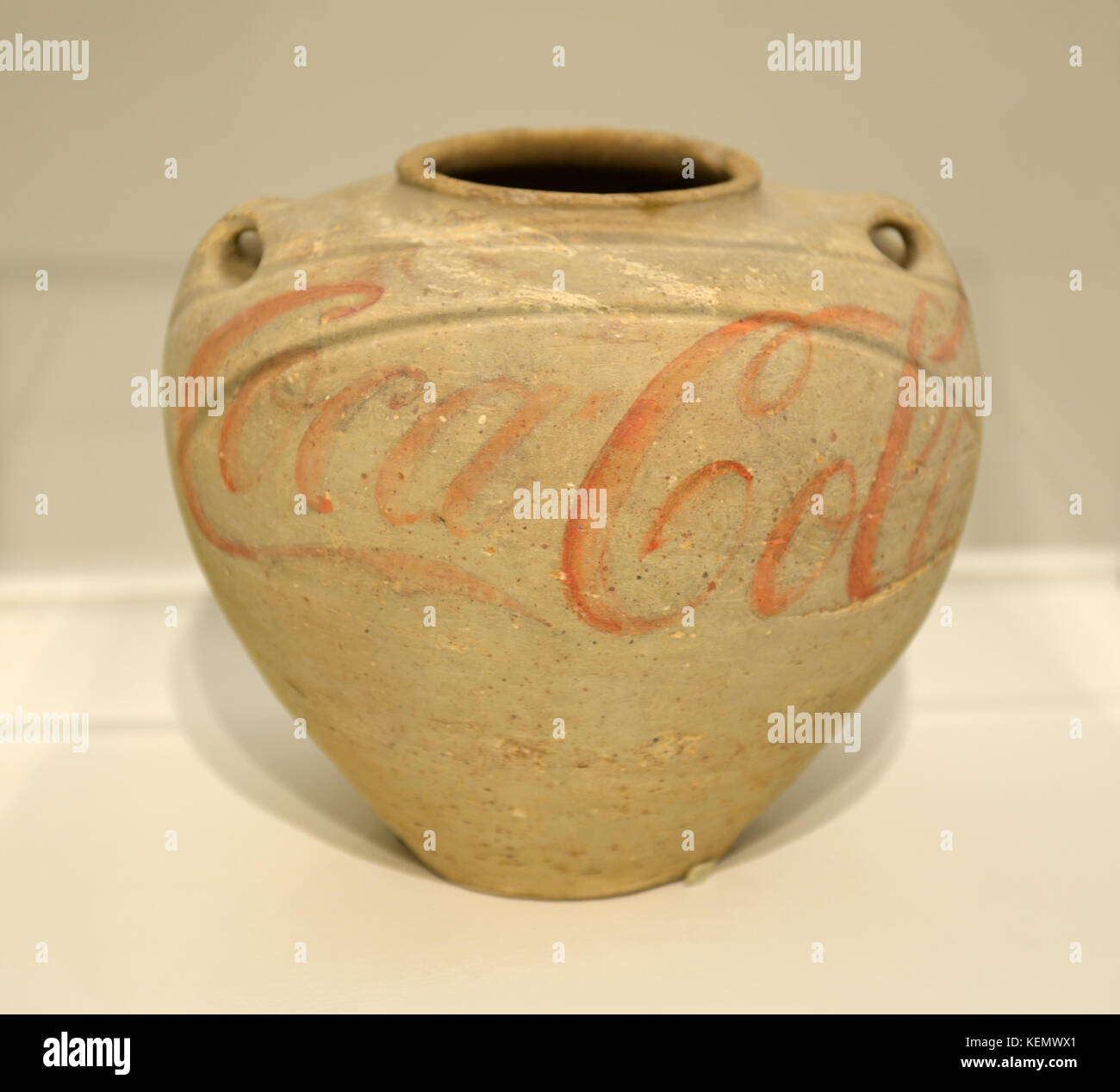 Han Dynasty Urn With Coca-Cola logo, 1993 by Chinese artist Ai Weiwei Stock Photohttps://www.alamy.com/image-license-details/?v=1https://www.alamy.com/stock-image-han-dynasty-urn-with-coca-cola-logo-1993-by-chinese-artist-ai-weiwei-163957865.html
Han Dynasty Urn With Coca-Cola logo, 1993 by Chinese artist Ai Weiwei Stock Photohttps://www.alamy.com/image-license-details/?v=1https://www.alamy.com/stock-image-han-dynasty-urn-with-coca-cola-logo-1993-by-chinese-artist-ai-weiwei-163957865.htmlRMKEMWX1–Han Dynasty Urn With Coca-Cola logo, 1993 by Chinese artist Ai Weiwei
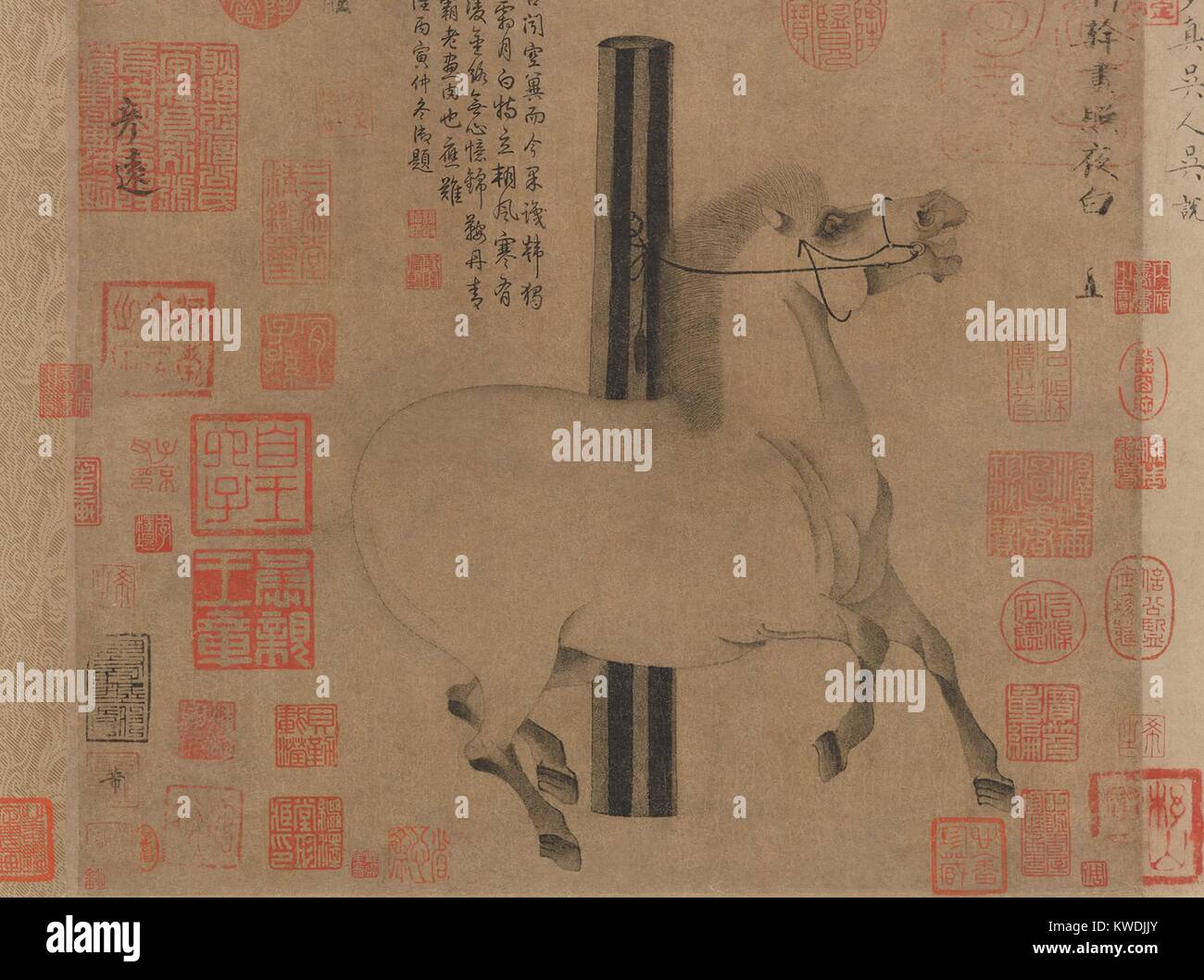 NIGHT SHINING WHITE, by Han Gan, 743-756, Chinese, Tang dynasty, painting, ink on paper. The animated horse of 8th century Emperor Xuanzong is portrayed with flaring nostrils and raised hoofs. This is the most famous work by Han Gan, the leading horse painter of his time. The seals and inscriptions added by later owners are a custom of Chinese connoisseurship (BSLOC 2017 16 6) Stock Photohttps://www.alamy.com/image-license-details/?v=1https://www.alamy.com/stock-photo-night-shining-white-by-han-gan-743-756-chinese-tang-dynasty-painting-170559731.html
NIGHT SHINING WHITE, by Han Gan, 743-756, Chinese, Tang dynasty, painting, ink on paper. The animated horse of 8th century Emperor Xuanzong is portrayed with flaring nostrils and raised hoofs. This is the most famous work by Han Gan, the leading horse painter of his time. The seals and inscriptions added by later owners are a custom of Chinese connoisseurship (BSLOC 2017 16 6) Stock Photohttps://www.alamy.com/image-license-details/?v=1https://www.alamy.com/stock-photo-night-shining-white-by-han-gan-743-756-chinese-tang-dynasty-painting-170559731.htmlRMKWDJJY–NIGHT SHINING WHITE, by Han Gan, 743-756, Chinese, Tang dynasty, painting, ink on paper. The animated horse of 8th century Emperor Xuanzong is portrayed with flaring nostrils and raised hoofs. This is the most famous work by Han Gan, the leading horse painter of his time. The seals and inscriptions added by later owners are a custom of Chinese connoisseurship (BSLOC 2017 16 6)
 Art inspired by Asian Art, Ornament, China, pre-Han dynasty (before 206 B.C.–A.D. 220), -300, 220, Jade, L. 1/2 in. (3.8 cm, Classic works modernized by Artotop with a splash of modernity. Shapes, color and value, eye-catching visual impact on art. Emotions through freedom of artworks in a contemporary way. A timeless message pursuing a wildly creative new direction. Artists turning to the digital medium and creating the Artotop NFT Stock Photohttps://www.alamy.com/image-license-details/?v=1https://www.alamy.com/art-inspired-by-asian-art-ornament-china-pre-han-dynasty-before-206-bcad-220-300-220-jade-l-12-in-38-cm-classic-works-modernized-by-artotop-with-a-splash-of-modernity-shapes-color-and-value-eye-catching-visual-impact-on-art-emotions-through-freedom-of-artworks-in-a-contemporary-way-a-timeless-message-pursuing-a-wildly-creative-new-direction-artists-turning-to-the-digital-medium-and-creating-the-artotop-nft-image463062539.html
Art inspired by Asian Art, Ornament, China, pre-Han dynasty (before 206 B.C.–A.D. 220), -300, 220, Jade, L. 1/2 in. (3.8 cm, Classic works modernized by Artotop with a splash of modernity. Shapes, color and value, eye-catching visual impact on art. Emotions through freedom of artworks in a contemporary way. A timeless message pursuing a wildly creative new direction. Artists turning to the digital medium and creating the Artotop NFT Stock Photohttps://www.alamy.com/image-license-details/?v=1https://www.alamy.com/art-inspired-by-asian-art-ornament-china-pre-han-dynasty-before-206-bcad-220-300-220-jade-l-12-in-38-cm-classic-works-modernized-by-artotop-with-a-splash-of-modernity-shapes-color-and-value-eye-catching-visual-impact-on-art-emotions-through-freedom-of-artworks-in-a-contemporary-way-a-timeless-message-pursuing-a-wildly-creative-new-direction-artists-turning-to-the-digital-medium-and-creating-the-artotop-nft-image463062539.htmlRF2HWA8YR–Art inspired by Asian Art, Ornament, China, pre-Han dynasty (before 206 B.C.–A.D. 220), -300, 220, Jade, L. 1/2 in. (3.8 cm, Classic works modernized by Artotop with a splash of modernity. Shapes, color and value, eye-catching visual impact on art. Emotions through freedom of artworks in a contemporary way. A timeless message pursuing a wildly creative new direction. Artists turning to the digital medium and creating the Artotop NFT
 Maoling Mausoleum near Xian, Shaanxi Province, China. Ancient recumbent stone horse dates from the Western Han Dynasty Stock Photohttps://www.alamy.com/image-license-details/?v=1https://www.alamy.com/stock-image-maoling-mausoleum-near-xian-shaanxi-province-china-ancient-recumbent-166642071.html
Maoling Mausoleum near Xian, Shaanxi Province, China. Ancient recumbent stone horse dates from the Western Han Dynasty Stock Photohttps://www.alamy.com/image-license-details/?v=1https://www.alamy.com/stock-image-maoling-mausoleum-near-xian-shaanxi-province-china-ancient-recumbent-166642071.htmlRMKK35JF–Maoling Mausoleum near Xian, Shaanxi Province, China. Ancient recumbent stone horse dates from the Western Han Dynasty
 Asia, China, Shanghai. Han Dynasty bronze 'Bixie' mythical beast. Believed to ward off evil spirits; Shanghai Museum Stock Photohttps://www.alamy.com/image-license-details/?v=1https://www.alamy.com/stock-photo-asia-china-shanghai-han-dynasty-bronze-bixie-mythical-beast-believed-11929342.html
Asia, China, Shanghai. Han Dynasty bronze 'Bixie' mythical beast. Believed to ward off evil spirits; Shanghai Museum Stock Photohttps://www.alamy.com/image-license-details/?v=1https://www.alamy.com/stock-photo-asia-china-shanghai-han-dynasty-bronze-bixie-mythical-beast-believed-11929342.htmlRMA7XJJR–Asia, China, Shanghai. Han Dynasty bronze 'Bixie' mythical beast. Believed to ward off evil spirits; Shanghai Museum
 Emperor Kang Shi, Tour of Kiang-Han, 1699 Stock Photohttps://www.alamy.com/image-license-details/?v=1https://www.alamy.com/emperor-kang-shi-tour-of-kiang-han-1699-image352807807.html
Emperor Kang Shi, Tour of Kiang-Han, 1699 Stock Photohttps://www.alamy.com/image-license-details/?v=1https://www.alamy.com/emperor-kang-shi-tour-of-kiang-han-1699-image352807807.htmlRM2BDYNXR–Emperor Kang Shi, Tour of Kiang-Han, 1699
 Two Chinese terra cotta terracotta statues about 1 meter tall dating from the han dynasty period China Stock Photohttps://www.alamy.com/image-license-details/?v=1https://www.alamy.com/stock-photo-two-chinese-terra-cotta-terracotta-statues-about-1-meter-tall-dating-13759573.html
Two Chinese terra cotta terracotta statues about 1 meter tall dating from the han dynasty period China Stock Photohttps://www.alamy.com/image-license-details/?v=1https://www.alamy.com/stock-photo-two-chinese-terra-cotta-terracotta-statues-about-1-meter-tall-dating-13759573.htmlRMAEW5NX–Two Chinese terra cotta terracotta statues about 1 meter tall dating from the han dynasty period China
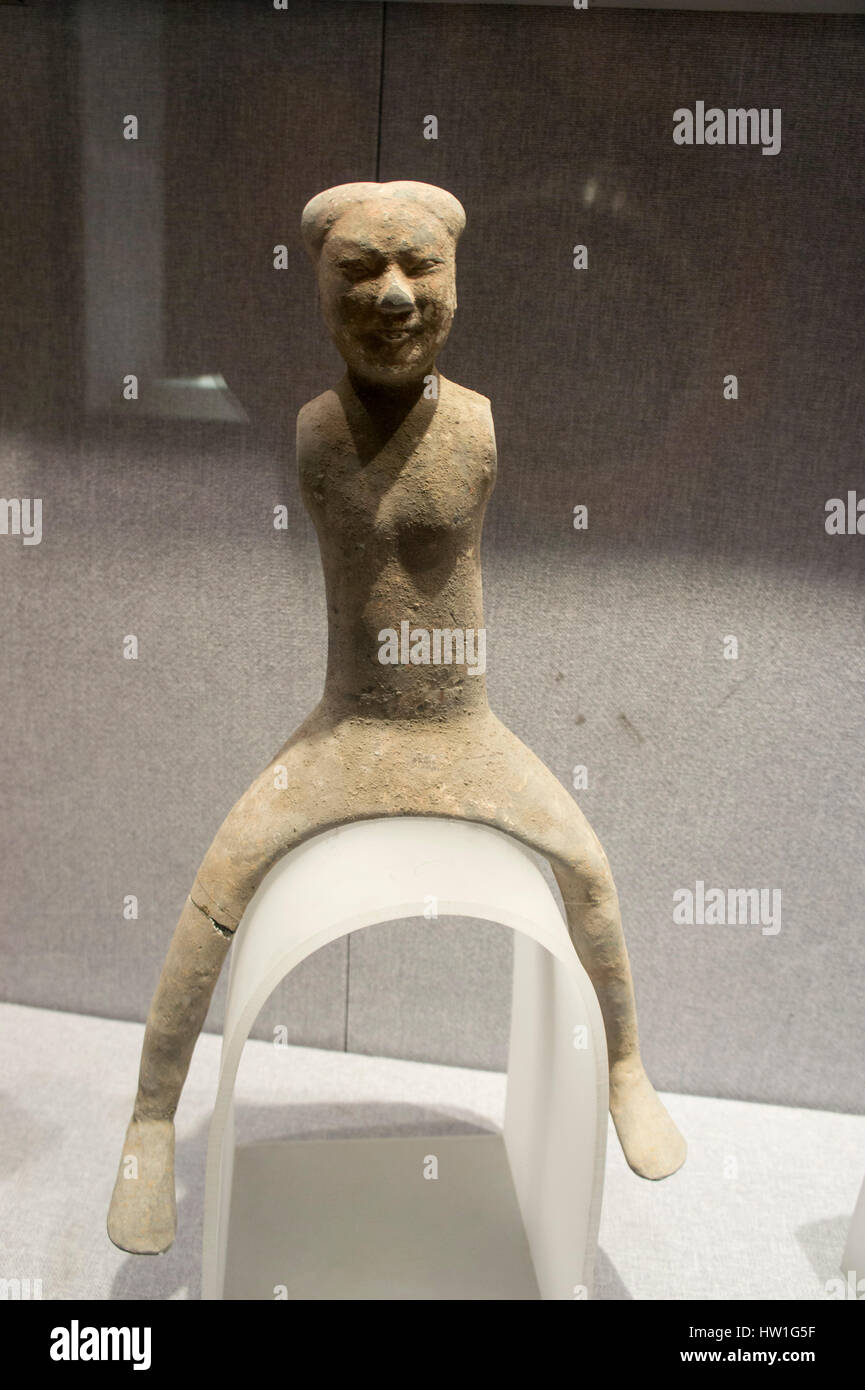 Pottery equestrisn figurines West Han Dynasty China Stock Photohttps://www.alamy.com/image-license-details/?v=1https://www.alamy.com/stock-photo-pottery-equestrisn-figurines-west-han-dynasty-china-135873627.html
Pottery equestrisn figurines West Han Dynasty China Stock Photohttps://www.alamy.com/image-license-details/?v=1https://www.alamy.com/stock-photo-pottery-equestrisn-figurines-west-han-dynasty-china-135873627.htmlRFHW1G5F–Pottery equestrisn figurines West Han Dynasty China
 Chinese calligraphy: Epigraph for Xia Cheng. Official script, Eastern Han Dynasty, Jianning Reign (year 170). Shanghai Museum, China Stock Photohttps://www.alamy.com/image-license-details/?v=1https://www.alamy.com/chinese-calligraphy-epigraph-for-xia-cheng-official-script-eastern-han-dynasty-jianning-reign-year-170-shanghai-museum-china-image359081745.html
Chinese calligraphy: Epigraph for Xia Cheng. Official script, Eastern Han Dynasty, Jianning Reign (year 170). Shanghai Museum, China Stock Photohttps://www.alamy.com/image-license-details/?v=1https://www.alamy.com/chinese-calligraphy-epigraph-for-xia-cheng-official-script-eastern-han-dynasty-jianning-reign-year-170-shanghai-museum-china-image359081745.htmlRF2BT5GC1–Chinese calligraphy: Epigraph for Xia Cheng. Official script, Eastern Han Dynasty, Jianning Reign (year 170). Shanghai Museum, China
 Han Dynasty Jade Clothes Sewn with Gold Wire, Aurora Art Museum, Shanghai, China Stock Photohttps://www.alamy.com/image-license-details/?v=1https://www.alamy.com/han-dynasty-jade-clothes-sewn-with-gold-wire-aurora-art-museum-shanghai-china-image351445946.html
Han Dynasty Jade Clothes Sewn with Gold Wire, Aurora Art Museum, Shanghai, China Stock Photohttps://www.alamy.com/image-license-details/?v=1https://www.alamy.com/han-dynasty-jade-clothes-sewn-with-gold-wire-aurora-art-museum-shanghai-china-image351445946.htmlRM2BBNMTX–Han Dynasty Jade Clothes Sewn with Gold Wire, Aurora Art Museum, Shanghai, China
 Han pottery model of a pigsty with privy above (Han dynasty 206BC-AD220) early Chou (c.1100-256BC) Stock Photohttps://www.alamy.com/image-license-details/?v=1https://www.alamy.com/han-pottery-model-of-a-pigsty-with-privy-above-han-dynasty-206bc-ad220-early-chou-c1100-256bc-image268800866.html
Han pottery model of a pigsty with privy above (Han dynasty 206BC-AD220) early Chou (c.1100-256BC) Stock Photohttps://www.alamy.com/image-license-details/?v=1https://www.alamy.com/han-pottery-model-of-a-pigsty-with-privy-above-han-dynasty-206bc-ad220-early-chou-c1100-256bc-image268800866.htmlRMWH8X6X–Han pottery model of a pigsty with privy above (Han dynasty 206BC-AD220) early Chou (c.1100-256BC)
 Ai Weiwei, Han Dynasty Vases with industrial paint at the Royal Academy of Arts Exhibition Stock Photohttps://www.alamy.com/image-license-details/?v=1https://www.alamy.com/stock-photo-ai-weiwei-han-dynasty-vases-with-industrial-paint-at-the-royal-academy-87589013.html
Ai Weiwei, Han Dynasty Vases with industrial paint at the Royal Academy of Arts Exhibition Stock Photohttps://www.alamy.com/image-license-details/?v=1https://www.alamy.com/stock-photo-ai-weiwei-han-dynasty-vases-with-industrial-paint-at-the-royal-academy-87589013.htmlRMF2E0K1–Ai Weiwei, Han Dynasty Vases with industrial paint at the Royal Academy of Arts Exhibition
 Polychrome Glazed Pottery Ewer with a Phoenix Head 618 - 907 AD Tang Han Dynasty ( Shanghai Museum of ancient Chinese art ) China Stock Photohttps://www.alamy.com/image-license-details/?v=1https://www.alamy.com/stock-photo-polychrome-glazed-pottery-ewer-with-a-phoenix-head-618-907-ad-tang-88425077.html
Polychrome Glazed Pottery Ewer with a Phoenix Head 618 - 907 AD Tang Han Dynasty ( Shanghai Museum of ancient Chinese art ) China Stock Photohttps://www.alamy.com/image-license-details/?v=1https://www.alamy.com/stock-photo-polychrome-glazed-pottery-ewer-with-a-phoenix-head-618-907-ad-tang-88425077.htmlRMF3T32D–Polychrome Glazed Pottery Ewer with a Phoenix Head 618 - 907 AD Tang Han Dynasty ( Shanghai Museum of ancient Chinese art ) China
 Tiny color painted Terracotta Army Soldiers from the Western Han dynasty that had been excavated from the Cahngling Tomb displayed at Xianyang museum in Xianyang City of Shaanxi Province China Stock Photohttps://www.alamy.com/image-license-details/?v=1https://www.alamy.com/stock-photo-tiny-color-painted-terracotta-army-soldiers-from-the-western-han-dynasty-58030935.html
Tiny color painted Terracotta Army Soldiers from the Western Han dynasty that had been excavated from the Cahngling Tomb displayed at Xianyang museum in Xianyang City of Shaanxi Province China Stock Photohttps://www.alamy.com/image-license-details/?v=1https://www.alamy.com/stock-photo-tiny-color-painted-terracotta-army-soldiers-from-the-western-han-dynasty-58030935.htmlRMDABF1B–Tiny color painted Terracotta Army Soldiers from the Western Han dynasty that had been excavated from the Cahngling Tomb displayed at Xianyang museum in Xianyang City of Shaanxi Province China
 Lintel from a tomb, , Chinese, Western Han dynasty, 1st century BC Stock Photohttps://www.alamy.com/image-license-details/?v=1https://www.alamy.com/lintel-from-a-tomb-chinese-western-han-dynasty-1st-century-bc-image634319290.html
Lintel from a tomb, , Chinese, Western Han dynasty, 1st century BC Stock Photohttps://www.alamy.com/image-license-details/?v=1https://www.alamy.com/lintel-from-a-tomb-chinese-western-han-dynasty-1st-century-bc-image634319290.htmlRM2YRYMMA–Lintel from a tomb, , Chinese, Western Han dynasty, 1st century BC
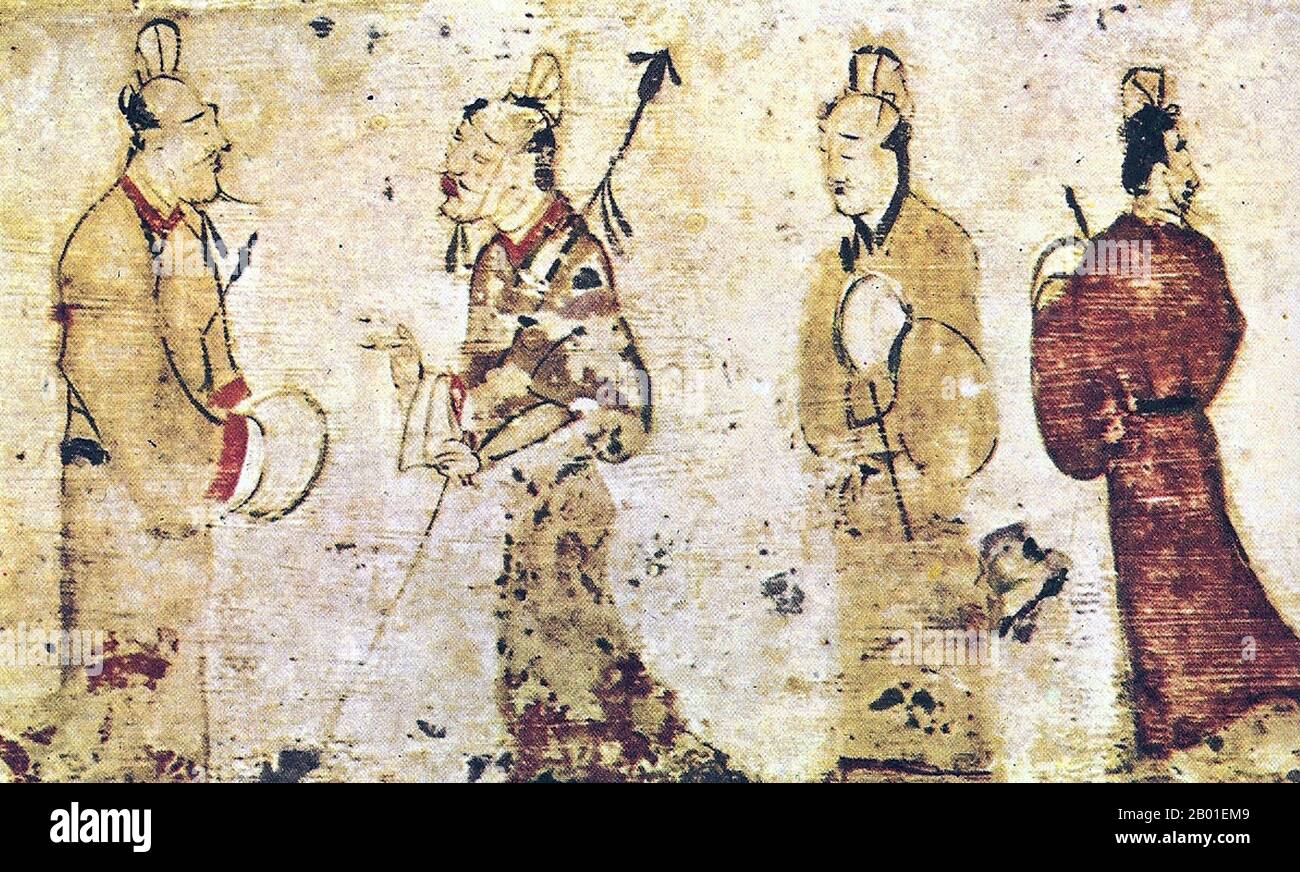 China: Two gentlemen engrossed in conversation while two others look on. Handscroll painting from a tomb near Luoyang, Henan province, dated to the Eastern Han Dynasty (25-220 CE). The Han Dynasty (206 BCE - 220 CE) was the second imperial dynasty of China, preceded by the Qin Dynasty (221-207 BCE) and succeeded by the Three Kingdoms (220-280 CE). It was founded by the peasant rebel leader Liu Bang, known posthumously as Emperor Gaozu of Han. It was briefly interrupted by the Xin Dynasty (9-23 CE) of the former regent Wang Mang. This interregnum separates the Han into two periods. Stock Photohttps://www.alamy.com/image-license-details/?v=1https://www.alamy.com/china-two-gentlemen-engrossed-in-conversation-while-two-others-look-on-handscroll-painting-from-a-tomb-near-luoyang-henan-province-dated-to-the-eastern-han-dynasty-25-220-ce-the-han-dynasty-206-bce-220-ce-was-the-second-imperial-dynasty-of-china-preceded-by-the-qin-dynasty-221-207-bce-and-succeeded-by-the-three-kingdoms-220-280-ce-it-was-founded-by-the-peasant-rebel-leader-liu-bang-known-posthumously-as-emperor-gaozu-of-han-it-was-briefly-interrupted-by-the-xin-dynasty-9-23-ce-of-the-former-regent-wang-mang-this-interregnum-separates-the-han-into-two-periods-image344240857.html
China: Two gentlemen engrossed in conversation while two others look on. Handscroll painting from a tomb near Luoyang, Henan province, dated to the Eastern Han Dynasty (25-220 CE). The Han Dynasty (206 BCE - 220 CE) was the second imperial dynasty of China, preceded by the Qin Dynasty (221-207 BCE) and succeeded by the Three Kingdoms (220-280 CE). It was founded by the peasant rebel leader Liu Bang, known posthumously as Emperor Gaozu of Han. It was briefly interrupted by the Xin Dynasty (9-23 CE) of the former regent Wang Mang. This interregnum separates the Han into two periods. Stock Photohttps://www.alamy.com/image-license-details/?v=1https://www.alamy.com/china-two-gentlemen-engrossed-in-conversation-while-two-others-look-on-handscroll-painting-from-a-tomb-near-luoyang-henan-province-dated-to-the-eastern-han-dynasty-25-220-ce-the-han-dynasty-206-bce-220-ce-was-the-second-imperial-dynasty-of-china-preceded-by-the-qin-dynasty-221-207-bce-and-succeeded-by-the-three-kingdoms-220-280-ce-it-was-founded-by-the-peasant-rebel-leader-liu-bang-known-posthumously-as-emperor-gaozu-of-han-it-was-briefly-interrupted-by-the-xin-dynasty-9-23-ce-of-the-former-regent-wang-mang-this-interregnum-separates-the-han-into-two-periods-image344240857.htmlRM2B01EM9–China: Two gentlemen engrossed in conversation while two others look on. Handscroll painting from a tomb near Luoyang, Henan province, dated to the Eastern Han Dynasty (25-220 CE). The Han Dynasty (206 BCE - 220 CE) was the second imperial dynasty of China, preceded by the Qin Dynasty (221-207 BCE) and succeeded by the Three Kingdoms (220-280 CE). It was founded by the peasant rebel leader Liu Bang, known posthumously as Emperor Gaozu of Han. It was briefly interrupted by the Xin Dynasty (9-23 CE) of the former regent Wang Mang. This interregnum separates the Han into two periods.
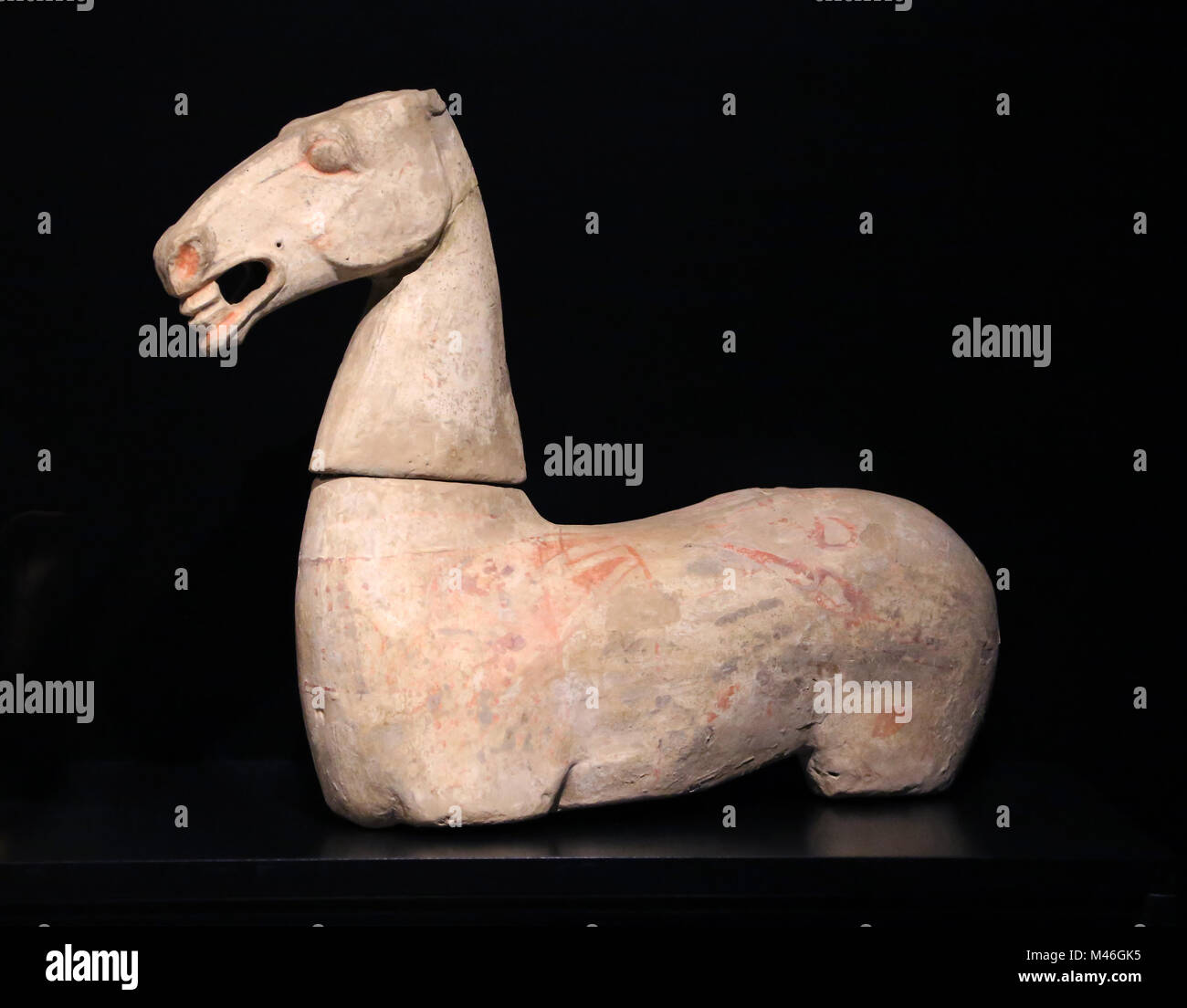 Horse statue in painted terracotta. Han Dynasty (206BC-220AD). Museu do Oriente, Lisbon, Portugal Stock Photohttps://www.alamy.com/image-license-details/?v=1https://www.alamy.com/stock-photo-horse-statue-in-painted-terracotta-han-dynasty-206bc-220ad-museu-do-174707097.html
Horse statue in painted terracotta. Han Dynasty (206BC-220AD). Museu do Oriente, Lisbon, Portugal Stock Photohttps://www.alamy.com/image-license-details/?v=1https://www.alamy.com/stock-photo-horse-statue-in-painted-terracotta-han-dynasty-206bc-220ad-museu-do-174707097.htmlRMM46GK5–Horse statue in painted terracotta. Han Dynasty (206BC-220AD). Museu do Oriente, Lisbon, Portugal
 Parcel gilt bronze fitting with fabulous animals design, Western Han dynasty, China, 2nd century BC. Artist: Unknown Stock Photohttps://www.alamy.com/image-license-details/?v=1https://www.alamy.com/stock-photo-parcel-gilt-bronze-fitting-with-fabulous-animals-design-western-han-28252261.html
Parcel gilt bronze fitting with fabulous animals design, Western Han dynasty, China, 2nd century BC. Artist: Unknown Stock Photohttps://www.alamy.com/image-license-details/?v=1https://www.alamy.com/stock-photo-parcel-gilt-bronze-fitting-with-fabulous-animals-design-western-han-28252261.htmlRMBHY019–Parcel gilt bronze fitting with fabulous animals design, Western Han dynasty, China, 2nd century BC. Artist: Unknown
 disc with two animals in relief, Han dynasty, Han dynasty, jade, Diam: 6 in., Asian Art Stock Photohttps://www.alamy.com/image-license-details/?v=1https://www.alamy.com/disc-with-two-animals-in-relief-han-dynasty-han-dynasty-jade-diam-6-in-asian-art-image328773046.html
disc with two animals in relief, Han dynasty, Han dynasty, jade, Diam: 6 in., Asian Art Stock Photohttps://www.alamy.com/image-license-details/?v=1https://www.alamy.com/disc-with-two-animals-in-relief-han-dynasty-han-dynasty-jade-diam-6-in-asian-art-image328773046.htmlRM2A2TWAE–disc with two animals in relief, Han dynasty, Han dynasty, jade, Diam: 6 in., Asian Art
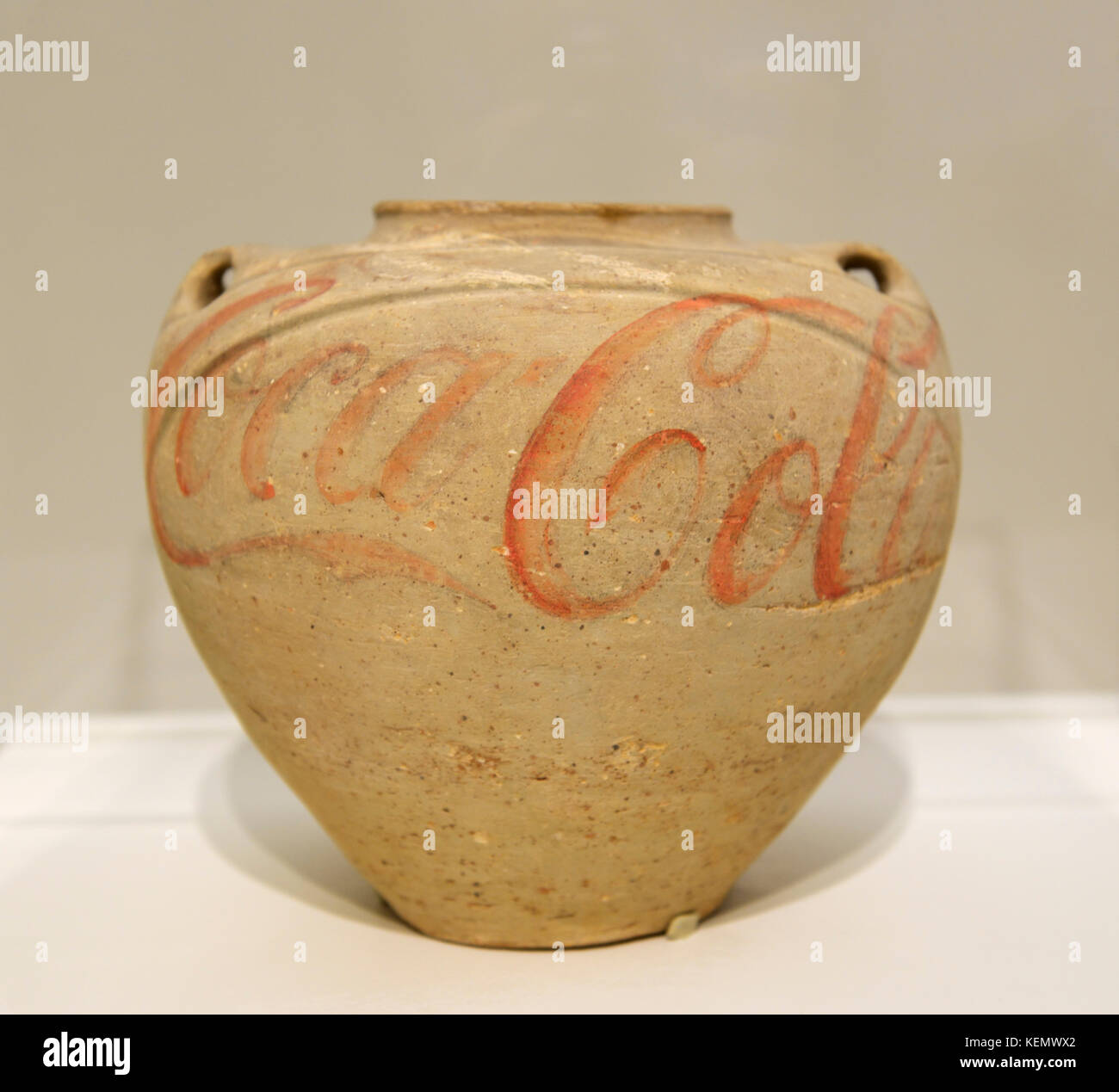 Han Dynasty Urn With Coca-Cola logo, 1993 by Chinese artist Ai Weiwei Stock Photohttps://www.alamy.com/image-license-details/?v=1https://www.alamy.com/stock-image-han-dynasty-urn-with-coca-cola-logo-1993-by-chinese-artist-ai-weiwei-163957866.html
Han Dynasty Urn With Coca-Cola logo, 1993 by Chinese artist Ai Weiwei Stock Photohttps://www.alamy.com/image-license-details/?v=1https://www.alamy.com/stock-image-han-dynasty-urn-with-coca-cola-logo-1993-by-chinese-artist-ai-weiwei-163957866.htmlRMKEMWX2–Han Dynasty Urn With Coca-Cola logo, 1993 by Chinese artist Ai Weiwei
 Jar from the Han Dynasty, China, stoneware, Museum of Arts and Sciences, Daytona Beach, Florida. Gift of Susie and Francois Lori Stock Photohttps://www.alamy.com/image-license-details/?v=1https://www.alamy.com/stock-photo-jar-from-the-han-dynasty-china-stoneware-museum-of-arts-and-sciences-86020606.html
Jar from the Han Dynasty, China, stoneware, Museum of Arts and Sciences, Daytona Beach, Florida. Gift of Susie and Francois Lori Stock Photohttps://www.alamy.com/image-license-details/?v=1https://www.alamy.com/stock-photo-jar-from-the-han-dynasty-china-stoneware-museum-of-arts-and-sciences-86020606.htmlRFEYXG4E–Jar from the Han Dynasty, China, stoneware, Museum of Arts and Sciences, Daytona Beach, Florida. Gift of Susie and Francois Lori
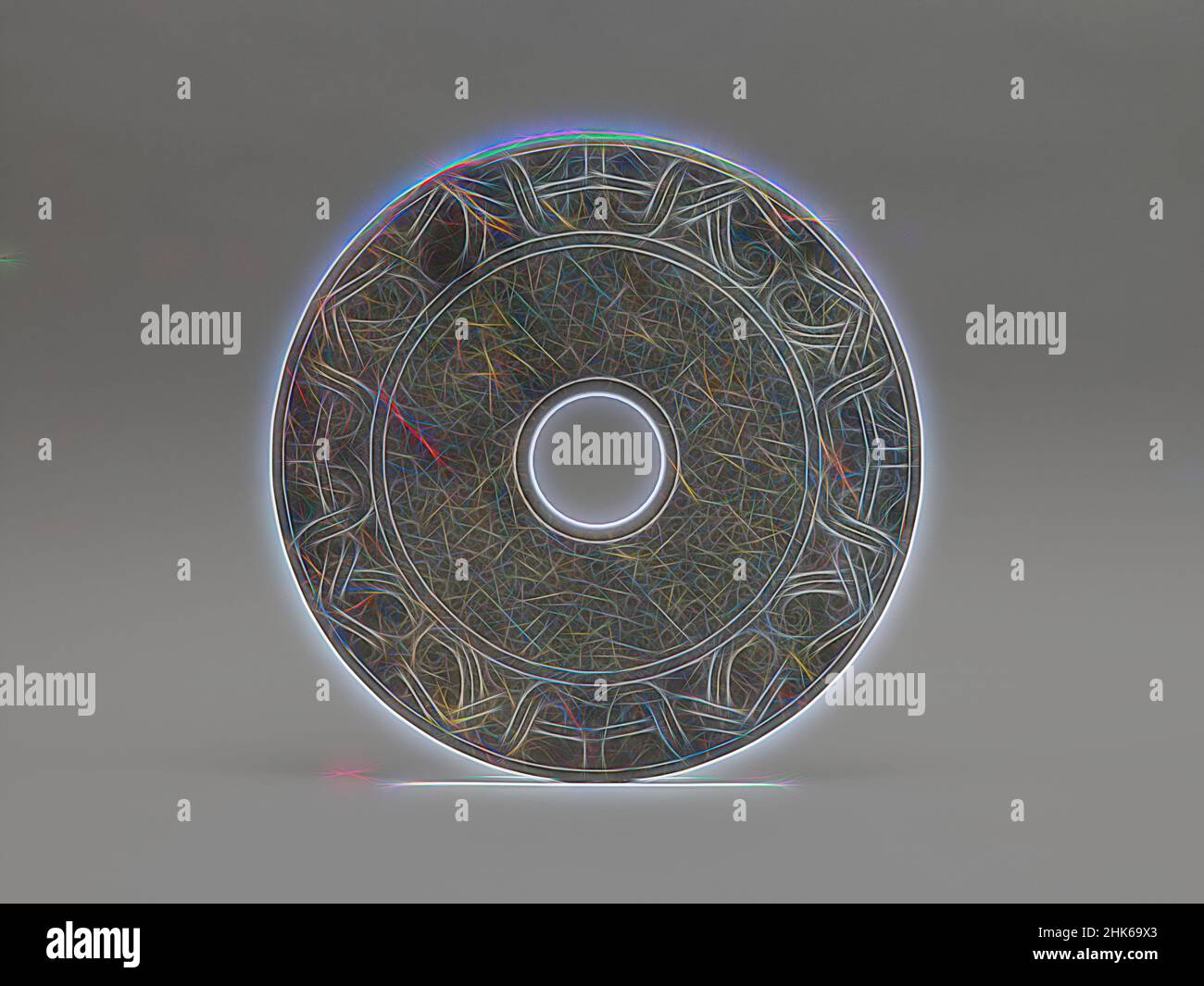 Inspired by Ritual Object in the Form of an Annular Disk (bi), Chinese, Western Han dynasty, 206 BC–AD 9, 2nd–1st century BC, Jade (nephrite), China, Asia, Jades, diameter: 9 1/4 in. (23.5 cm, Reimagined by Artotop. Classic art reinvented with a modern twist. Design of warm cheerful glowing of brightness and light ray radiance. Photography inspired by surrealism and futurism, embracing dynamic energy of modern technology, movement, speed and revolutionize culture Stock Photohttps://www.alamy.com/image-license-details/?v=1https://www.alamy.com/inspired-by-ritual-object-in-the-form-of-an-annular-disk-bi-chinese-western-han-dynasty-206-bcad-9-2nd1st-century-bc-jade-nephrite-china-asia-jades-diameter-9-14-in-235-cm-reimagined-by-artotop-classic-art-reinvented-with-a-modern-twist-design-of-warm-cheerful-glowing-of-brightness-and-light-ray-radiance-photography-inspired-by-surrealism-and-futurism-embracing-dynamic-energy-of-modern-technology-movement-speed-and-revolutionize-culture-image459287531.html
Inspired by Ritual Object in the Form of an Annular Disk (bi), Chinese, Western Han dynasty, 206 BC–AD 9, 2nd–1st century BC, Jade (nephrite), China, Asia, Jades, diameter: 9 1/4 in. (23.5 cm, Reimagined by Artotop. Classic art reinvented with a modern twist. Design of warm cheerful glowing of brightness and light ray radiance. Photography inspired by surrealism and futurism, embracing dynamic energy of modern technology, movement, speed and revolutionize culture Stock Photohttps://www.alamy.com/image-license-details/?v=1https://www.alamy.com/inspired-by-ritual-object-in-the-form-of-an-annular-disk-bi-chinese-western-han-dynasty-206-bcad-9-2nd1st-century-bc-jade-nephrite-china-asia-jades-diameter-9-14-in-235-cm-reimagined-by-artotop-classic-art-reinvented-with-a-modern-twist-design-of-warm-cheerful-glowing-of-brightness-and-light-ray-radiance-photography-inspired-by-surrealism-and-futurism-embracing-dynamic-energy-of-modern-technology-movement-speed-and-revolutionize-culture-image459287531.htmlRF2HK69X3–Inspired by Ritual Object in the Form of an Annular Disk (bi), Chinese, Western Han dynasty, 206 BC–AD 9, 2nd–1st century BC, Jade (nephrite), China, Asia, Jades, diameter: 9 1/4 in. (23.5 cm, Reimagined by Artotop. Classic art reinvented with a modern twist. Design of warm cheerful glowing of brightness and light ray radiance. Photography inspired by surrealism and futurism, embracing dynamic energy of modern technology, movement, speed and revolutionize culture
 Maoling Mausoleum near Xian, Shaanxi Province, China. Ancient stone carving of galloping horse dates from Western Han Dynasty Stock Photohttps://www.alamy.com/image-license-details/?v=1https://www.alamy.com/maoling-mausoleum-near-xian-shaanxi-province-china-ancient-stone-carving-of-galloping-horse-dates-from-western-han-dynasty-image612912221.html
Maoling Mausoleum near Xian, Shaanxi Province, China. Ancient stone carving of galloping horse dates from Western Han Dynasty Stock Photohttps://www.alamy.com/image-license-details/?v=1https://www.alamy.com/maoling-mausoleum-near-xian-shaanxi-province-china-ancient-stone-carving-of-galloping-horse-dates-from-western-han-dynasty-image612912221.htmlRM2XH4FP5–Maoling Mausoleum near Xian, Shaanxi Province, China. Ancient stone carving of galloping horse dates from Western Han Dynasty
 A RARE ELEGANTLY MODELLED POTTERY DANCING LADY FROM THE WESTERN HAN DYNASTY ON VIEW AT SOTHEBYS AS PART OF THEIR 'ASIAN ART' AUCTION WHICH WILL BE HELD ON 14th NOVEMBER. THE FIGURE'S ESTIMATED VALUE IS BETWEEN 50,000-70,000 AND WERE MADE, ALONG WITH OTHER PORCELAIN OBJECTS, TO ACCOMPANY THE WEALTHY DECEASED IN THEIR BURIAL AS ENTERTAINMENT Stock Photohttps://www.alamy.com/image-license-details/?v=1https://www.alamy.com/a-rare-elegantly-modelled-pottery-dancing-lady-from-the-western-han-dynasty-on-view-at-sothebys-as-part-of-their-asian-art-auction-which-will-be-held-on-14th-november-the-figures-estimated-value-is-between-50000-70000-and-were-made-along-with-other-porcelain-objects-to-accompany-the-wealthy-deceased-in-their-burial-as-entertainment-image424598655.html
A RARE ELEGANTLY MODELLED POTTERY DANCING LADY FROM THE WESTERN HAN DYNASTY ON VIEW AT SOTHEBYS AS PART OF THEIR 'ASIAN ART' AUCTION WHICH WILL BE HELD ON 14th NOVEMBER. THE FIGURE'S ESTIMATED VALUE IS BETWEEN 50,000-70,000 AND WERE MADE, ALONG WITH OTHER PORCELAIN OBJECTS, TO ACCOMPANY THE WEALTHY DECEASED IN THEIR BURIAL AS ENTERTAINMENT Stock Photohttps://www.alamy.com/image-license-details/?v=1https://www.alamy.com/a-rare-elegantly-modelled-pottery-dancing-lady-from-the-western-han-dynasty-on-view-at-sothebys-as-part-of-their-asian-art-auction-which-will-be-held-on-14th-november-the-figures-estimated-value-is-between-50000-70000-and-were-made-along-with-other-porcelain-objects-to-accompany-the-wealthy-deceased-in-their-burial-as-entertainment-image424598655.htmlRM2FJP3WK–A RARE ELEGANTLY MODELLED POTTERY DANCING LADY FROM THE WESTERN HAN DYNASTY ON VIEW AT SOTHEBYS AS PART OF THEIR 'ASIAN ART' AUCTION WHICH WILL BE HELD ON 14th NOVEMBER. THE FIGURE'S ESTIMATED VALUE IS BETWEEN 50,000-70,000 AND WERE MADE, ALONG WITH OTHER PORCELAIN OBJECTS, TO ACCOMPANY THE WEALTHY DECEASED IN THEIR BURIAL AS ENTERTAINMENT
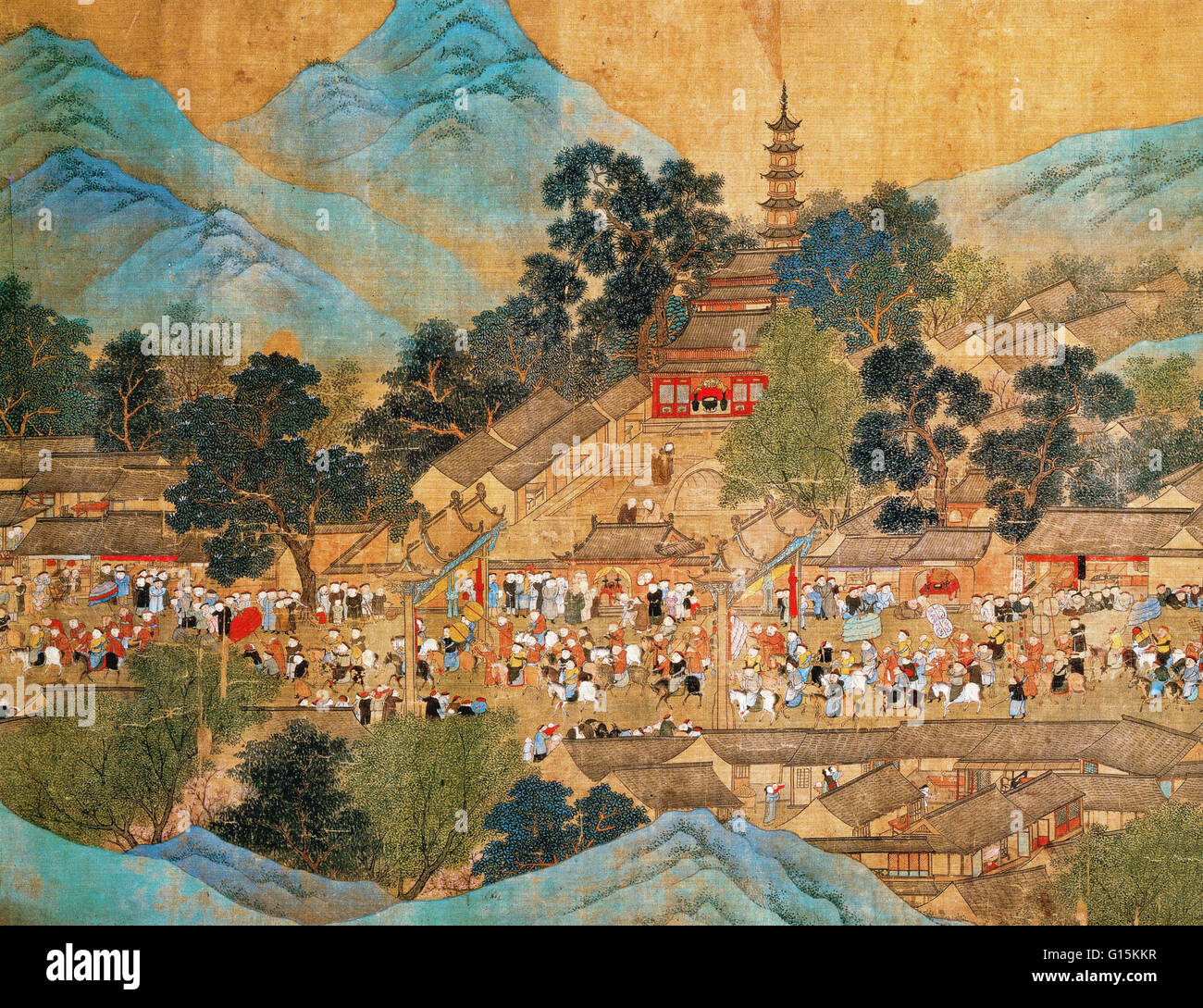 Emperor Kang Shi's (Kangxi) tour of Kiang-Han in 1699, after Chaio Ping Chen (1661-1722) (ink & color on silk backed paper) by Qing Dynasty Chinese School. The Kangxi Emperor (1654-1722) was the fourth emperor of the Qing Dynasty. Kangxi's reign of 61 yea Stock Photohttps://www.alamy.com/image-license-details/?v=1https://www.alamy.com/stock-photo-emperor-kang-shis-kangxi-tour-of-kiang-han-in-1699-after-chaio-ping-104002075.html
Emperor Kang Shi's (Kangxi) tour of Kiang-Han in 1699, after Chaio Ping Chen (1661-1722) (ink & color on silk backed paper) by Qing Dynasty Chinese School. The Kangxi Emperor (1654-1722) was the fourth emperor of the Qing Dynasty. Kangxi's reign of 61 yea Stock Photohttps://www.alamy.com/image-license-details/?v=1https://www.alamy.com/stock-photo-emperor-kang-shis-kangxi-tour-of-kiang-han-in-1699-after-chaio-ping-104002075.htmlRMG15KKR–Emperor Kang Shi's (Kangxi) tour of Kiang-Han in 1699, after Chaio Ping Chen (1661-1722) (ink & color on silk backed paper) by Qing Dynasty Chinese School. The Kangxi Emperor (1654-1722) was the fourth emperor of the Qing Dynasty. Kangxi's reign of 61 yea
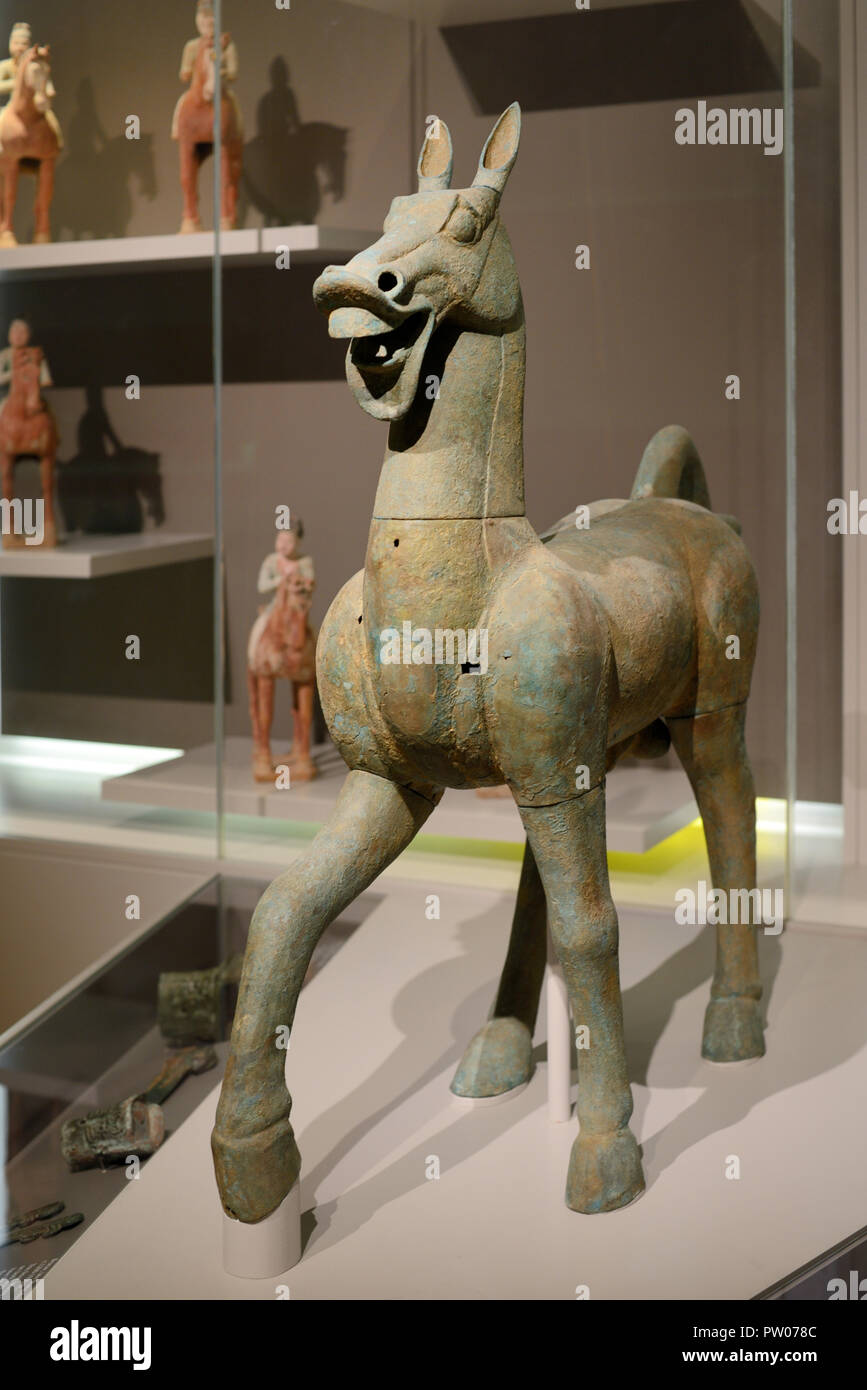 Chinese Heavenly Horse Bronze Sculpture Han Dynasty 206BC-AD220 China Stock Photohttps://www.alamy.com/image-license-details/?v=1https://www.alamy.com/chinese-heavenly-horse-bronze-sculpture-han-dynasty-206bc-ad220-china-image221896540.html
Chinese Heavenly Horse Bronze Sculpture Han Dynasty 206BC-AD220 China Stock Photohttps://www.alamy.com/image-license-details/?v=1https://www.alamy.com/chinese-heavenly-horse-bronze-sculpture-han-dynasty-206bc-ad220-china-image221896540.htmlRMPW078C–Chinese Heavenly Horse Bronze Sculpture Han Dynasty 206BC-AD220 China
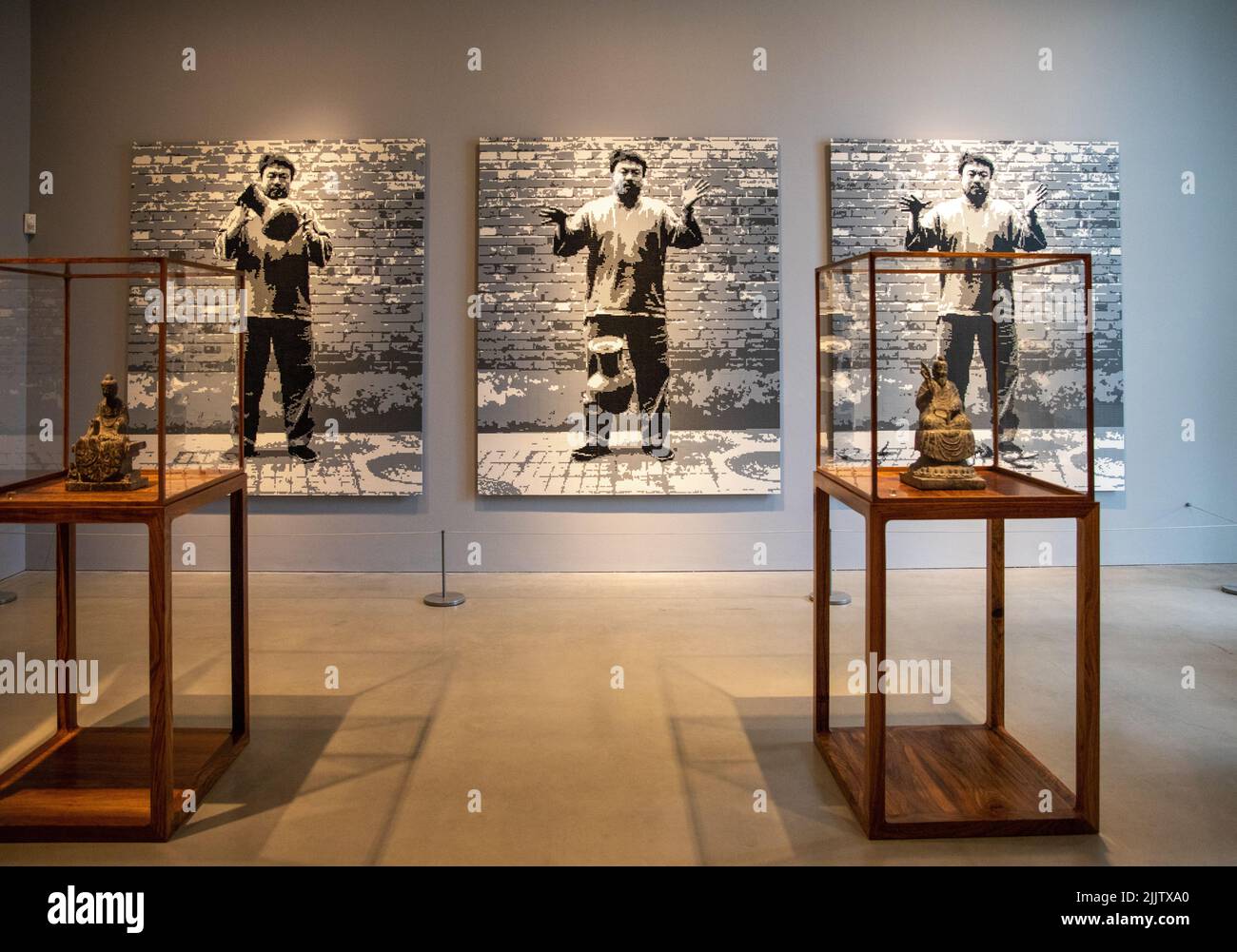 Ai Weiwei most famous piece, Dropping a Han Dynasty Urn shown in Lego bricks. Part of The Liberty of Doubt exhibition in Kettle Yard Stock Photohttps://www.alamy.com/image-license-details/?v=1https://www.alamy.com/ai-weiwei-most-famous-piece-dropping-a-han-dynasty-urn-shown-in-lego-bricks-part-of-the-liberty-of-doubt-exhibition-in-kettle-yard-image476291256.html
Ai Weiwei most famous piece, Dropping a Han Dynasty Urn shown in Lego bricks. Part of The Liberty of Doubt exhibition in Kettle Yard Stock Photohttps://www.alamy.com/image-license-details/?v=1https://www.alamy.com/ai-weiwei-most-famous-piece-dropping-a-han-dynasty-urn-shown-in-lego-bricks-part-of-the-liberty-of-doubt-exhibition-in-kettle-yard-image476291256.htmlRF2JJTXA0–Ai Weiwei most famous piece, Dropping a Han Dynasty Urn shown in Lego bricks. Part of The Liberty of Doubt exhibition in Kettle Yard
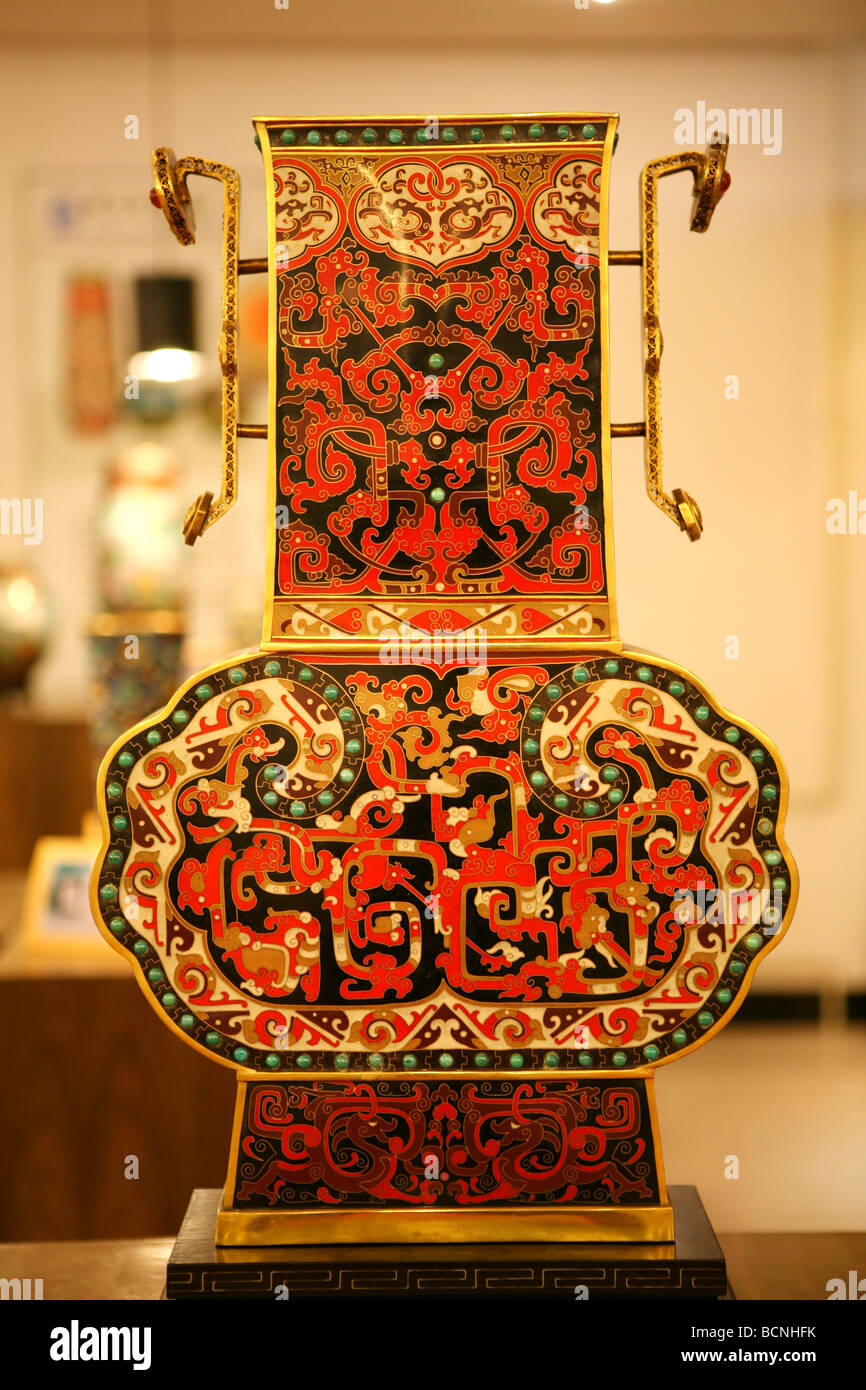 Cloisonné vase with Han Dynasty pattern, Beijing, China Stock Photohttps://www.alamy.com/image-license-details/?v=1https://www.alamy.com/stock-photo-cloisonn-vase-with-han-dynasty-pattern-beijing-china-25060999.html
Cloisonné vase with Han Dynasty pattern, Beijing, China Stock Photohttps://www.alamy.com/image-license-details/?v=1https://www.alamy.com/stock-photo-cloisonn-vase-with-han-dynasty-pattern-beijing-china-25060999.htmlRMBCNHFK–Cloisonné vase with Han Dynasty pattern, Beijing, China
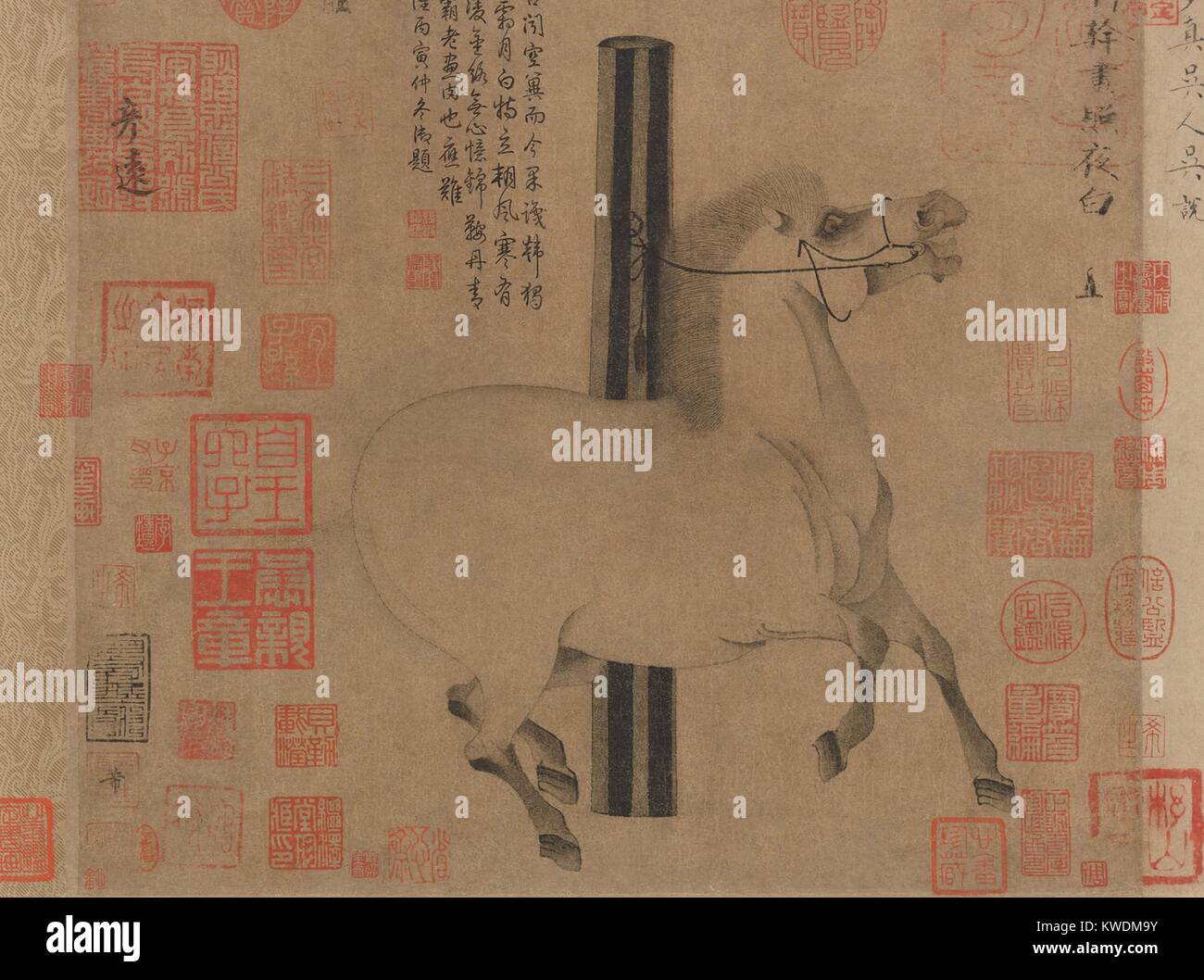 NIGHT SHINING WHITE, by Han Gan, 743-756, Chinese, Tang dynasty, painting, ink on paper. The animated horse of 8th century Emperor Xuanzong is portrayed with flaring nostrils and raised hoofs. This is the most famous work by Han Gan, the leading horse painter of his time. The seals and inscriptions added by later owners are a custom of Chinese connoisseurship (BSLOC 2017 16 6) Stock Photohttps://www.alamy.com/image-license-details/?v=1https://www.alamy.com/stock-photo-night-shining-white-by-han-gan-743-756-chinese-tang-dynasty-painting-170561047.html
NIGHT SHINING WHITE, by Han Gan, 743-756, Chinese, Tang dynasty, painting, ink on paper. The animated horse of 8th century Emperor Xuanzong is portrayed with flaring nostrils and raised hoofs. This is the most famous work by Han Gan, the leading horse painter of his time. The seals and inscriptions added by later owners are a custom of Chinese connoisseurship (BSLOC 2017 16 6) Stock Photohttps://www.alamy.com/image-license-details/?v=1https://www.alamy.com/stock-photo-night-shining-white-by-han-gan-743-756-chinese-tang-dynasty-painting-170561047.htmlRMKWDM9Y–NIGHT SHINING WHITE, by Han Gan, 743-756, Chinese, Tang dynasty, painting, ink on paper. The animated horse of 8th century Emperor Xuanzong is portrayed with flaring nostrils and raised hoofs. This is the most famous work by Han Gan, the leading horse painter of his time. The seals and inscriptions added by later owners are a custom of Chinese connoisseurship (BSLOC 2017 16 6)
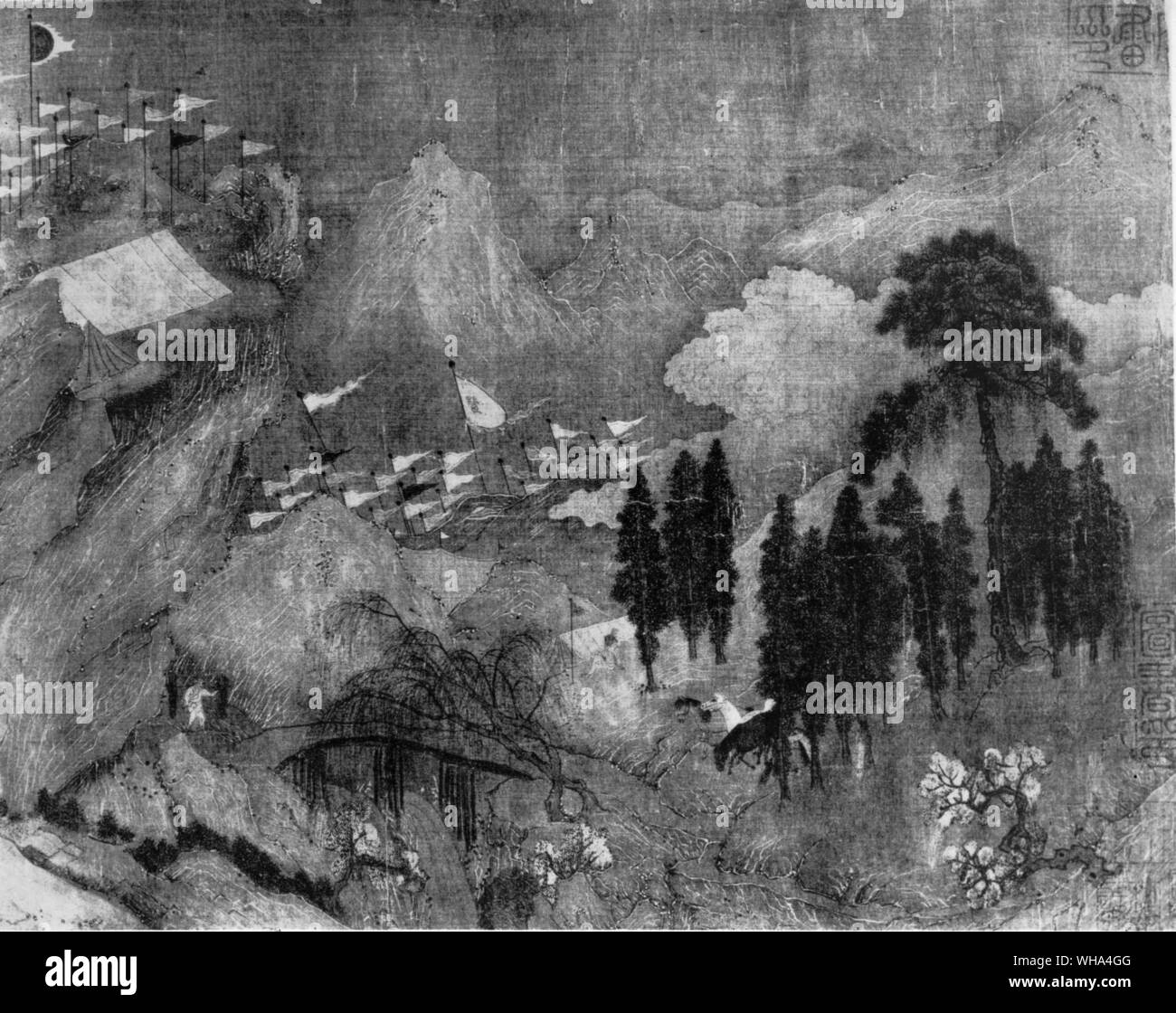 Entry of the Founder of the Han Dynasty into Huan Chung by Chao Pu-chu. 12th century Stock Photohttps://www.alamy.com/image-license-details/?v=1https://www.alamy.com/entry-of-the-founder-of-the-han-dynasty-into-huan-chung-by-chao-pu-chu-12th-century-image268827792.html
Entry of the Founder of the Han Dynasty into Huan Chung by Chao Pu-chu. 12th century Stock Photohttps://www.alamy.com/image-license-details/?v=1https://www.alamy.com/entry-of-the-founder-of-the-han-dynasty-into-huan-chung-by-chao-pu-chu-12th-century-image268827792.htmlRMWHA4GG–Entry of the Founder of the Han Dynasty into Huan Chung by Chao Pu-chu. 12th century
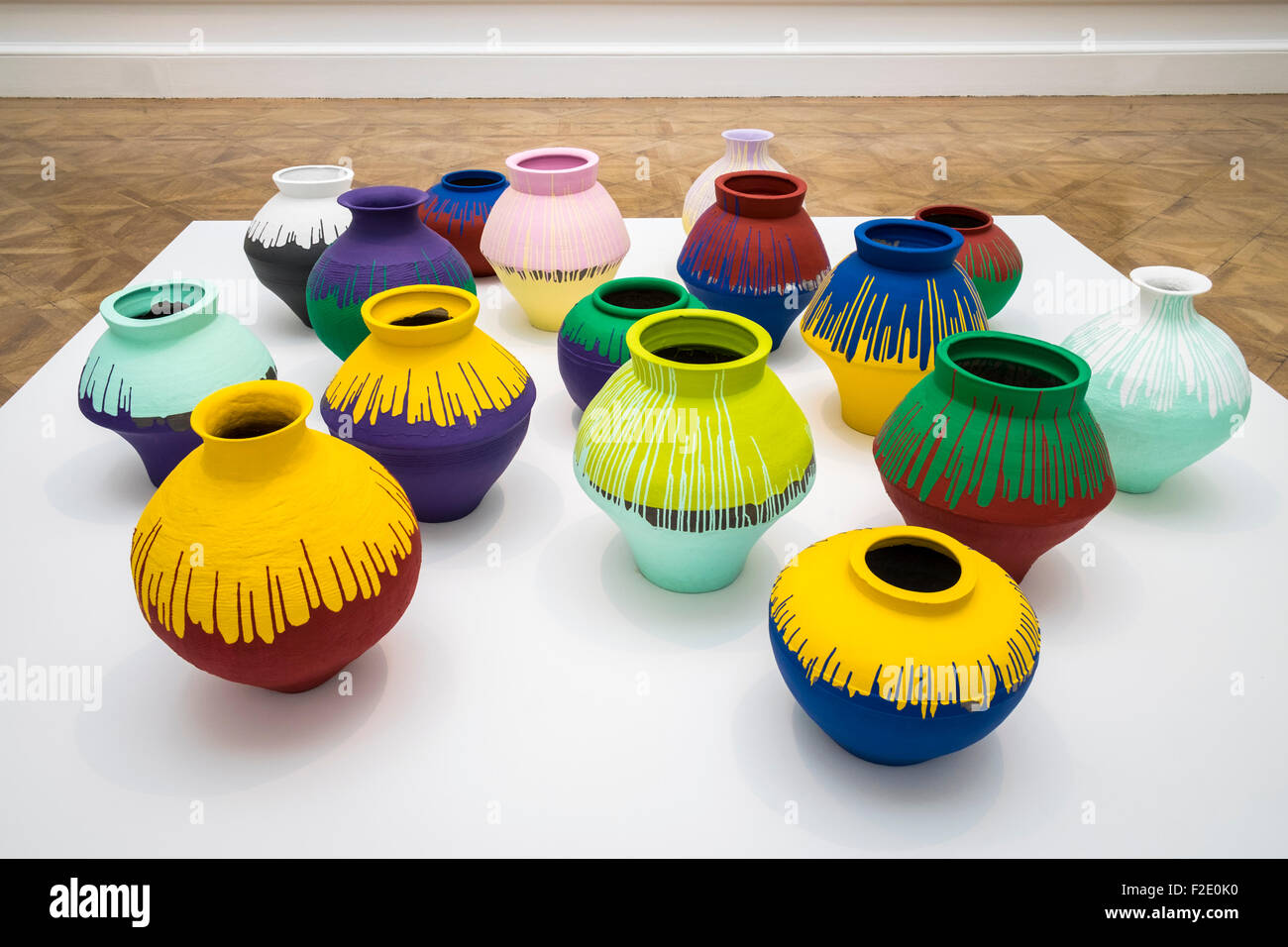 Ai Weiwei, twelve Han Dynasty and four neolithic vases with industrial paint at the Royal Academy of Arts Exhibition Stock Photohttps://www.alamy.com/image-license-details/?v=1https://www.alamy.com/stock-photo-ai-weiwei-twelve-han-dynasty-and-four-neolithic-vases-with-industrial-87589012.html
Ai Weiwei, twelve Han Dynasty and four neolithic vases with industrial paint at the Royal Academy of Arts Exhibition Stock Photohttps://www.alamy.com/image-license-details/?v=1https://www.alamy.com/stock-photo-ai-weiwei-twelve-han-dynasty-and-four-neolithic-vases-with-industrial-87589012.htmlRMF2E0K0–Ai Weiwei, twelve Han Dynasty and four neolithic vases with industrial paint at the Royal Academy of Arts Exhibition
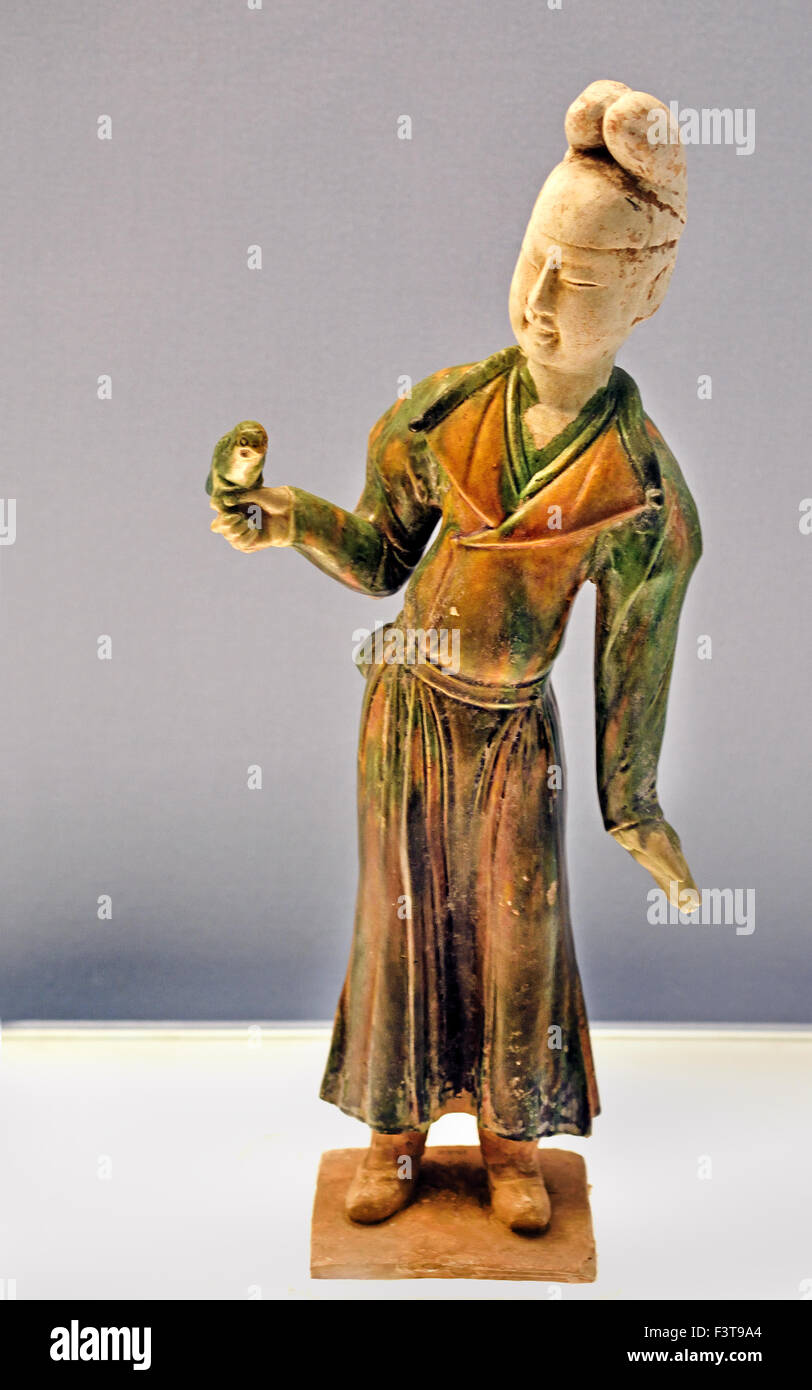 Colored Female Figurine 618 - 907 AD Tang Han Dynasty ( Shanghai Museum of ancient Chinese art ) China Stock Photohttps://www.alamy.com/image-license-details/?v=1https://www.alamy.com/stock-photo-colored-female-figurine-618-907-ad-tang-han-dynasty-shanghai-museum-88429996.html
Colored Female Figurine 618 - 907 AD Tang Han Dynasty ( Shanghai Museum of ancient Chinese art ) China Stock Photohttps://www.alamy.com/image-license-details/?v=1https://www.alamy.com/stock-photo-colored-female-figurine-618-907-ad-tang-han-dynasty-shanghai-museum-88429996.htmlRMF3T9A4–Colored Female Figurine 618 - 907 AD Tang Han Dynasty ( Shanghai Museum of ancient Chinese art ) China
 Tiny color painted Terracotta Army Soldiers from the Western Han dynasty that had been excavated from the Cahngling Tomb displayed at Xianyang museum in Xianyang City of Shaanxi Province China Stock Photohttps://www.alamy.com/image-license-details/?v=1https://www.alamy.com/stock-photo-tiny-color-painted-terracotta-army-soldiers-from-the-western-han-dynasty-58030918.html
Tiny color painted Terracotta Army Soldiers from the Western Han dynasty that had been excavated from the Cahngling Tomb displayed at Xianyang museum in Xianyang City of Shaanxi Province China Stock Photohttps://www.alamy.com/image-license-details/?v=1https://www.alamy.com/stock-photo-tiny-color-painted-terracotta-army-soldiers-from-the-western-han-dynasty-58030918.htmlRMDABF0P–Tiny color painted Terracotta Army Soldiers from the Western Han dynasty that had been excavated from the Cahngling Tomb displayed at Xianyang museum in Xianyang City of Shaanxi Province China
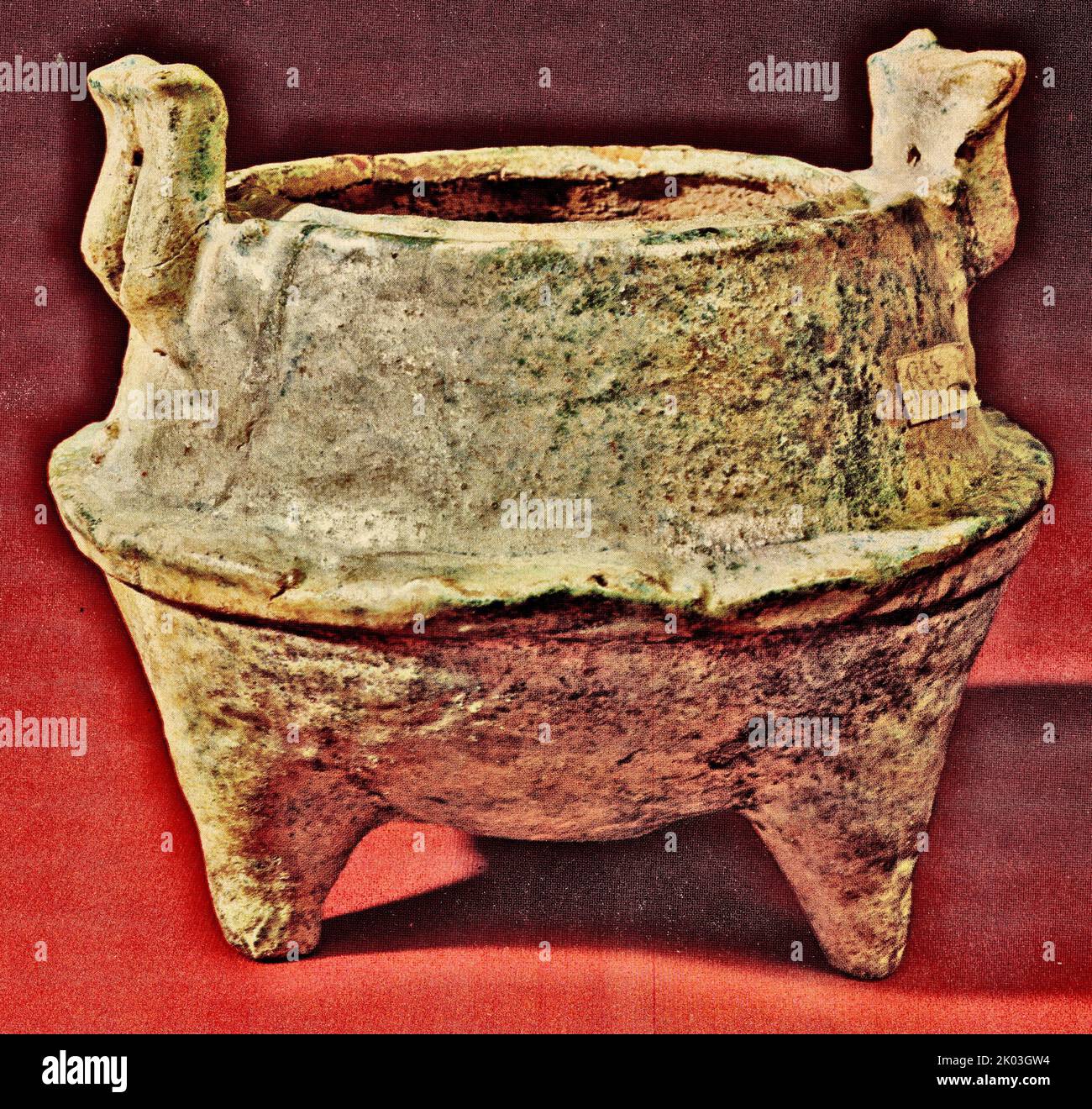 Han Dynasty pot, Chinese, Circa 200 BC Stock Photohttps://www.alamy.com/image-license-details/?v=1https://www.alamy.com/han-dynasty-pot-chinese-circa-200-bc-image481969408.html
Han Dynasty pot, Chinese, Circa 200 BC Stock Photohttps://www.alamy.com/image-license-details/?v=1https://www.alamy.com/han-dynasty-pot-chinese-circa-200-bc-image481969408.htmlRM2K03GW4–Han Dynasty pot, Chinese, Circa 200 BC
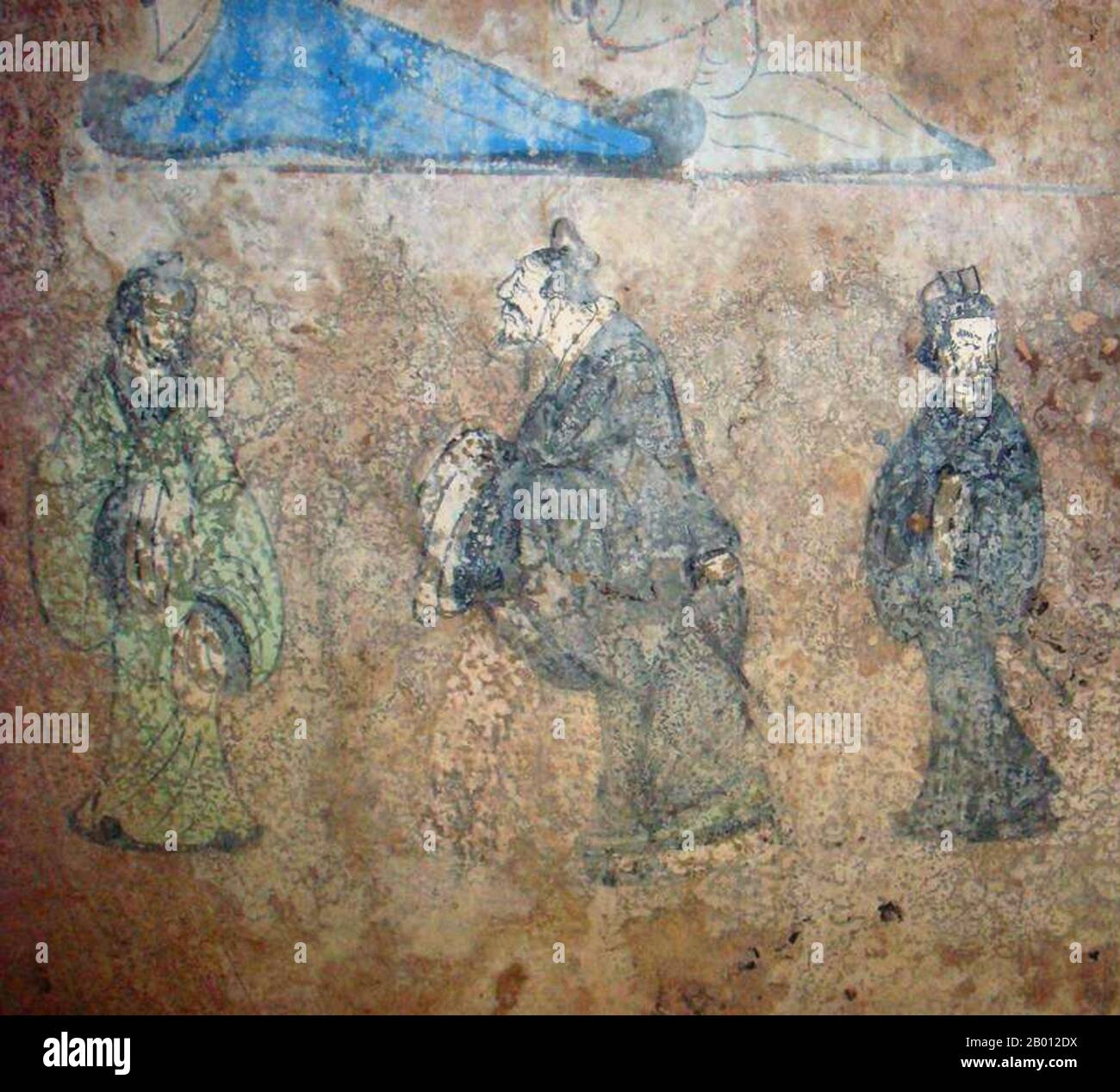 China: Laozi (Lao Tzu, c. 6th century BCE, left), meeting with Confucius (Kong Zi, K'ung-tzu, K'ung-fu-tzu, 551– 479 BCE) in a Han Dynasty (206 BCE– 220 CE) fresco from Dongping County, Shandong Province. The fresco, painted with blue, green, black and red colours is found on the walls of a tomb at an old residential yard in Dongping county, southwestern Shandong, and is estimated to be about 2,000 years old. Stock Photohttps://www.alamy.com/image-license-details/?v=1https://www.alamy.com/china-laozi-lao-tzu-c-6th-century-bce-left-meeting-with-confucius-kong-zi-kung-tzu-kung-fu-tzu-551-479-bce-in-a-han-dynasty-206-bce-220-ce-fresco-from-dongping-county-shandong-province-the-fresco-painted-with-blue-green-black-and-red-colours-is-found-on-the-walls-of-a-tomb-at-an-old-residential-yard-in-dongping-county-southwestern-shandong-and-is-estimated-to-be-about-2000-years-old-image344231270.html
China: Laozi (Lao Tzu, c. 6th century BCE, left), meeting with Confucius (Kong Zi, K'ung-tzu, K'ung-fu-tzu, 551– 479 BCE) in a Han Dynasty (206 BCE– 220 CE) fresco from Dongping County, Shandong Province. The fresco, painted with blue, green, black and red colours is found on the walls of a tomb at an old residential yard in Dongping county, southwestern Shandong, and is estimated to be about 2,000 years old. Stock Photohttps://www.alamy.com/image-license-details/?v=1https://www.alamy.com/china-laozi-lao-tzu-c-6th-century-bce-left-meeting-with-confucius-kong-zi-kung-tzu-kung-fu-tzu-551-479-bce-in-a-han-dynasty-206-bce-220-ce-fresco-from-dongping-county-shandong-province-the-fresco-painted-with-blue-green-black-and-red-colours-is-found-on-the-walls-of-a-tomb-at-an-old-residential-yard-in-dongping-county-southwestern-shandong-and-is-estimated-to-be-about-2000-years-old-image344231270.htmlRM2B012DX–China: Laozi (Lao Tzu, c. 6th century BCE, left), meeting with Confucius (Kong Zi, K'ung-tzu, K'ung-fu-tzu, 551– 479 BCE) in a Han Dynasty (206 BCE– 220 CE) fresco from Dongping County, Shandong Province. The fresco, painted with blue, green, black and red colours is found on the walls of a tomb at an old residential yard in Dongping county, southwestern Shandong, and is estimated to be about 2,000 years old.
 Pottery equestrisn figurines West Han Dynasty China Stock Photohttps://www.alamy.com/image-license-details/?v=1https://www.alamy.com/stock-photo-pottery-equestrisn-figurines-west-han-dynasty-china-135873632.html
Pottery equestrisn figurines West Han Dynasty China Stock Photohttps://www.alamy.com/image-license-details/?v=1https://www.alamy.com/stock-photo-pottery-equestrisn-figurines-west-han-dynasty-china-135873632.htmlRFHW1G5M–Pottery equestrisn figurines West Han Dynasty China
 A seated maid figurine. Han Period (25-220 AD). Terracotta. Sichuan style. Sichuan. Sichuan Museum, Chengdu Shi, China. Stock Photohttps://www.alamy.com/image-license-details/?v=1https://www.alamy.com/a-seated-maid-figurine-han-period-25-220-ad-terracotta-sichuan-style-sichuan-sichuan-museum-chengdu-shi-china-image384116680.html
A seated maid figurine. Han Period (25-220 AD). Terracotta. Sichuan style. Sichuan. Sichuan Museum, Chengdu Shi, China. Stock Photohttps://www.alamy.com/image-license-details/?v=1https://www.alamy.com/a-seated-maid-figurine-han-period-25-220-ad-terracotta-sichuan-style-sichuan-sichuan-museum-chengdu-shi-china-image384116680.htmlRM2D8X0MT–A seated maid figurine. Han Period (25-220 AD). Terracotta. Sichuan style. Sichuan. Sichuan Museum, Chengdu Shi, China.
 model of a stove, Unknown, Eastern Han dynasty, 25-220, stoneware with brown glaze, H: 8 11-3/4, Asian Art Stock Photohttps://www.alamy.com/image-license-details/?v=1https://www.alamy.com/model-of-a-stove-unknown-eastern-han-dynasty-25-220-stoneware-with-brown-glaze-h-8-11-34-asian-art-image328773102.html
model of a stove, Unknown, Eastern Han dynasty, 25-220, stoneware with brown glaze, H: 8 11-3/4, Asian Art Stock Photohttps://www.alamy.com/image-license-details/?v=1https://www.alamy.com/model-of-a-stove-unknown-eastern-han-dynasty-25-220-stoneware-with-brown-glaze-h-8-11-34-asian-art-image328773102.htmlRM2A2TWCE–model of a stove, Unknown, Eastern Han dynasty, 25-220, stoneware with brown glaze, H: 8 11-3/4, Asian Art
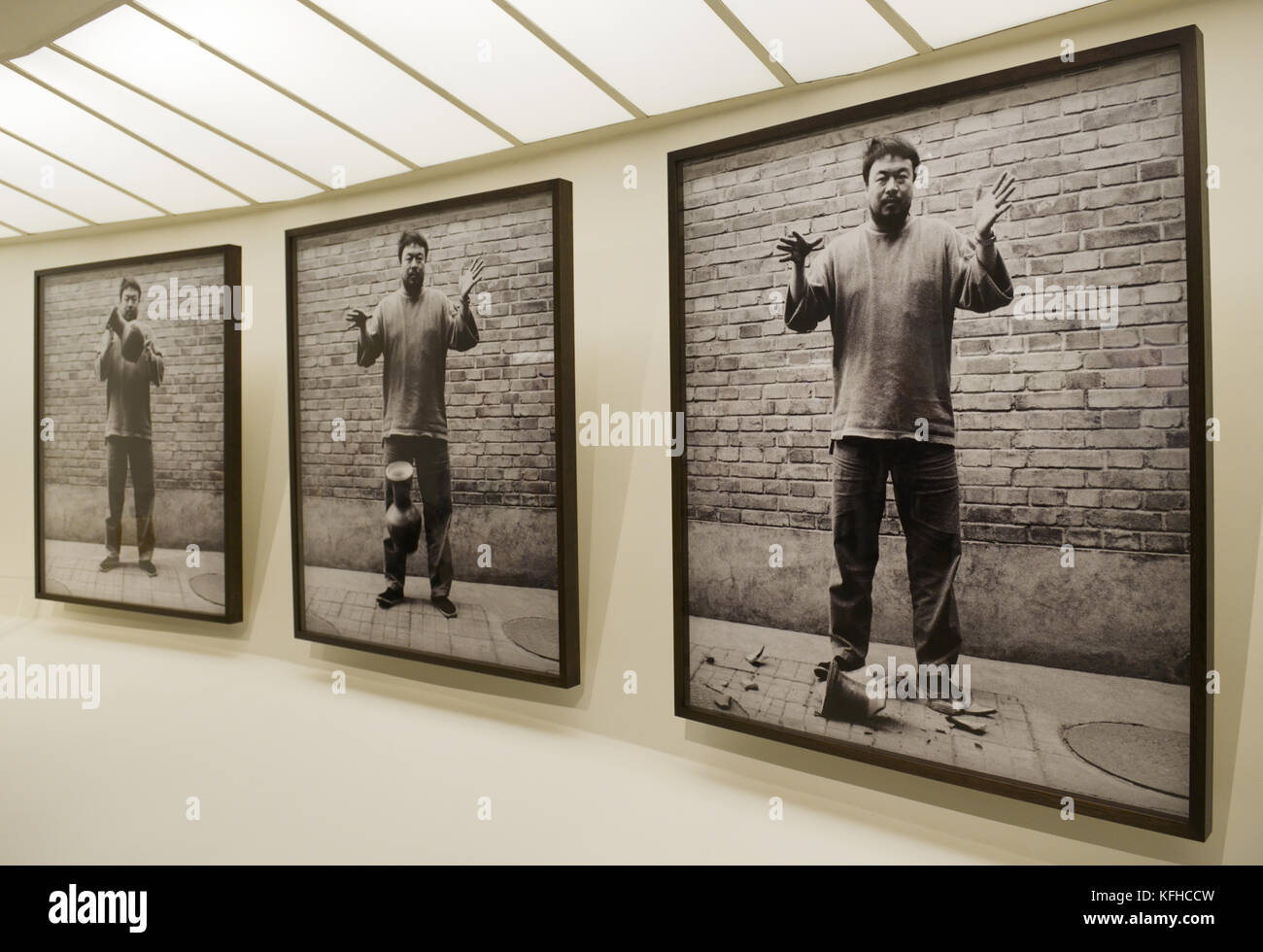 Ai Weiwei, Chinese artist, dropping a Han Dynasty urn Stock Photohttps://www.alamy.com/image-license-details/?v=1https://www.alamy.com/stock-image-ai-weiwei-chinese-artist-dropping-a-han-dynasty-urn-164496105.html
Ai Weiwei, Chinese artist, dropping a Han Dynasty urn Stock Photohttps://www.alamy.com/image-license-details/?v=1https://www.alamy.com/stock-image-ai-weiwei-chinese-artist-dropping-a-han-dynasty-urn-164496105.htmlRMKFHCCW–Ai Weiwei, Chinese artist, dropping a Han Dynasty urn
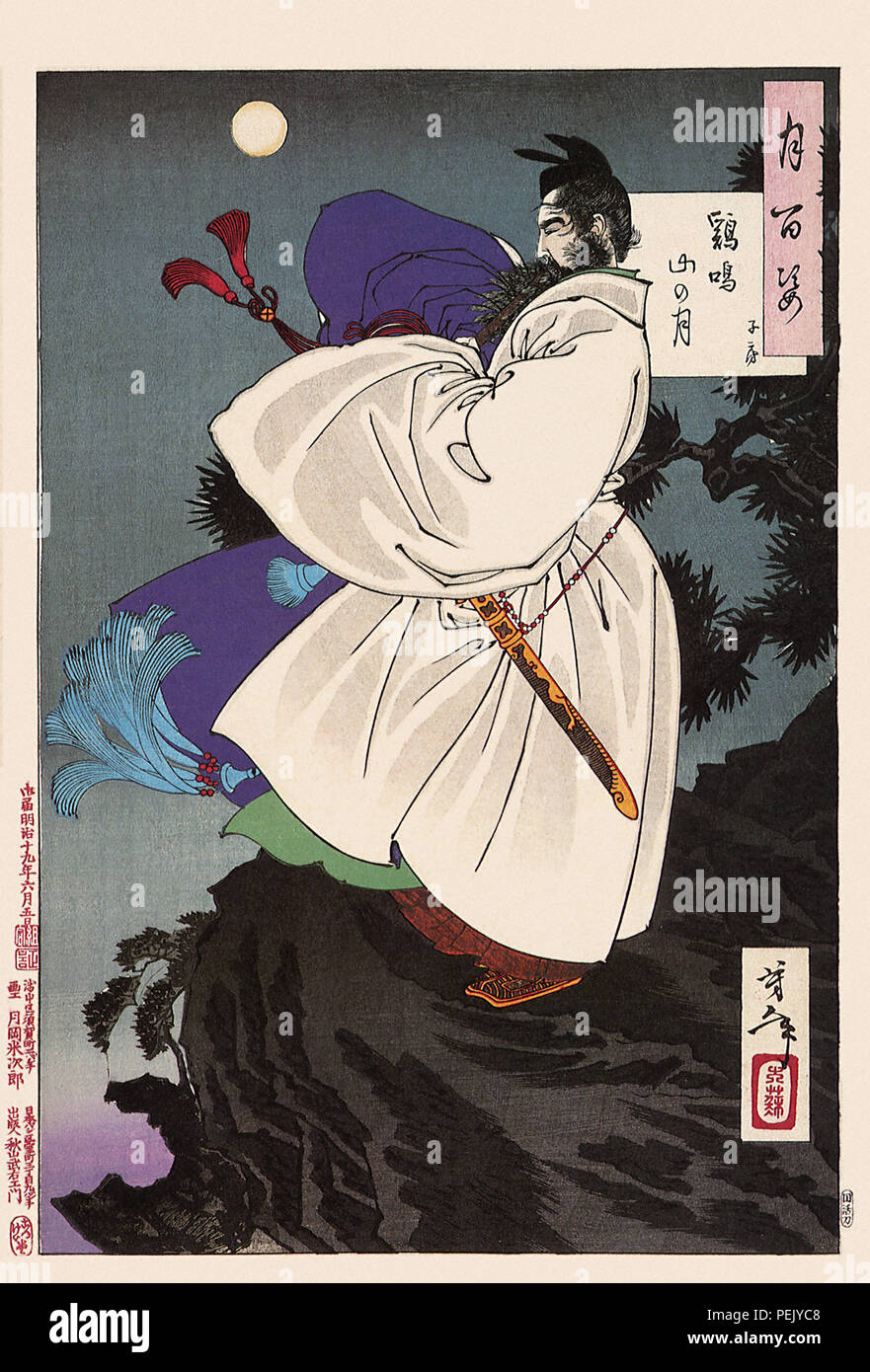 Mount Ji Ming Moon - Zi Fang, Yoshitoshi, Tsukioka Stock Photohttps://www.alamy.com/image-license-details/?v=1https://www.alamy.com/mount-ji-ming-moon-zi-fang-yoshitoshi-tsukioka-image215546248.html
Mount Ji Ming Moon - Zi Fang, Yoshitoshi, Tsukioka Stock Photohttps://www.alamy.com/image-license-details/?v=1https://www.alamy.com/mount-ji-ming-moon-zi-fang-yoshitoshi-tsukioka-image215546248.htmlRMPEJYC8–Mount Ji Ming Moon - Zi Fang, Yoshitoshi, Tsukioka
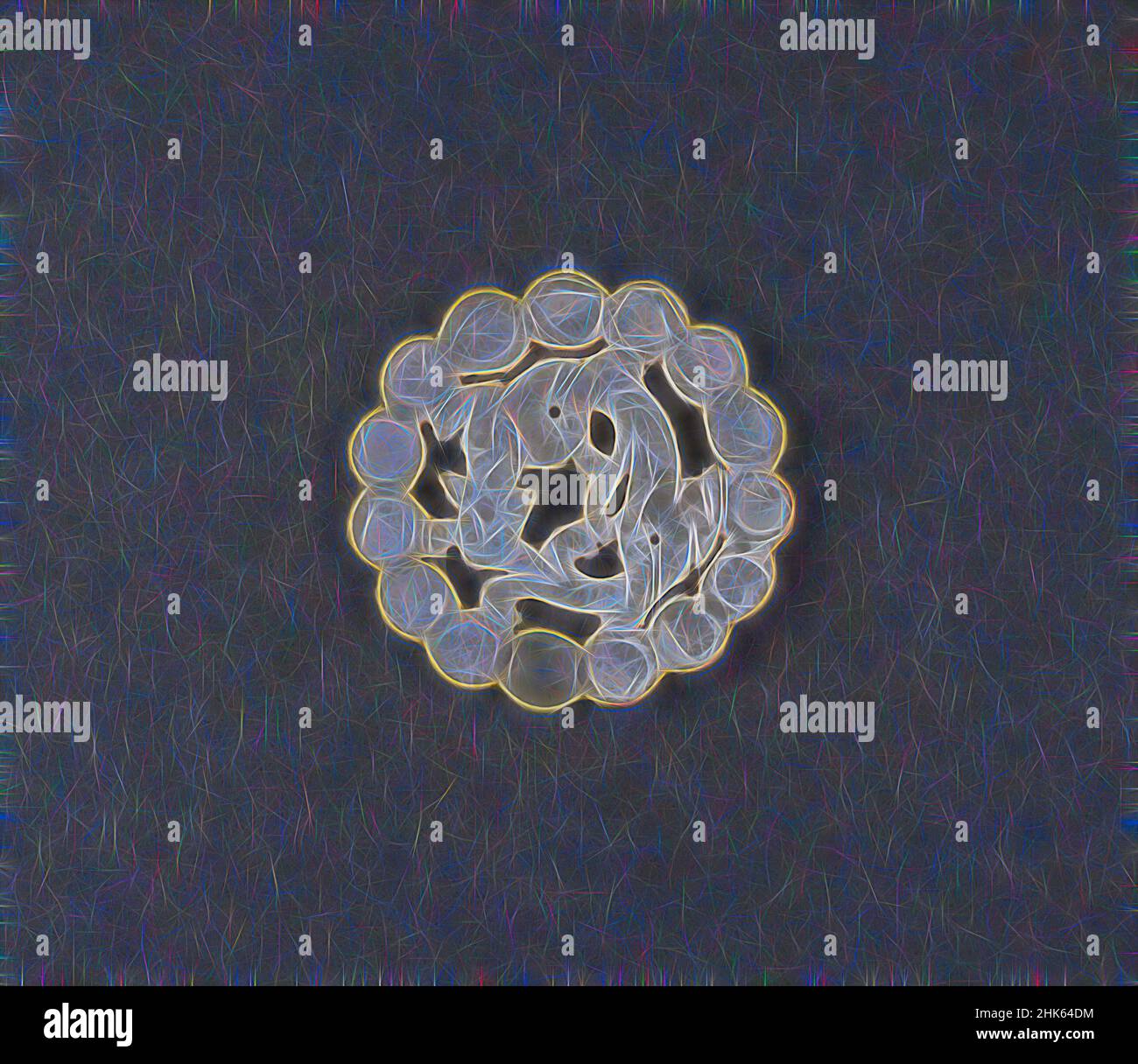 Inspired by Ornament with Design of Dragon Surrounded by Circular Border of Roundels, Chinese, Western Han dynasty, 206 BC–AD 9, c.3rd century BC, Glass, China, Asia, Glassware, sculpture, diameter: 2 3/16 in. (5.5 cm, Reimagined by Artotop. Classic art reinvented with a modern twist. Design of warm cheerful glowing of brightness and light ray radiance. Photography inspired by surrealism and futurism, embracing dynamic energy of modern technology, movement, speed and revolutionize culture Stock Photohttps://www.alamy.com/image-license-details/?v=1https://www.alamy.com/inspired-by-ornament-with-design-of-dragon-surrounded-by-circular-border-of-roundels-chinese-western-han-dynasty-206-bcad-9-c3rd-century-bc-glass-china-asia-glassware-sculpture-diameter-2-316-in-55-cm-reimagined-by-artotop-classic-art-reinvented-with-a-modern-twist-design-of-warm-cheerful-glowing-of-brightness-and-light-ray-radiance-photography-inspired-by-surrealism-and-futurism-embracing-dynamic-energy-of-modern-technology-movement-speed-and-revolutionize-culture-image459283264.html
Inspired by Ornament with Design of Dragon Surrounded by Circular Border of Roundels, Chinese, Western Han dynasty, 206 BC–AD 9, c.3rd century BC, Glass, China, Asia, Glassware, sculpture, diameter: 2 3/16 in. (5.5 cm, Reimagined by Artotop. Classic art reinvented with a modern twist. Design of warm cheerful glowing of brightness and light ray radiance. Photography inspired by surrealism and futurism, embracing dynamic energy of modern technology, movement, speed and revolutionize culture Stock Photohttps://www.alamy.com/image-license-details/?v=1https://www.alamy.com/inspired-by-ornament-with-design-of-dragon-surrounded-by-circular-border-of-roundels-chinese-western-han-dynasty-206-bcad-9-c3rd-century-bc-glass-china-asia-glassware-sculpture-diameter-2-316-in-55-cm-reimagined-by-artotop-classic-art-reinvented-with-a-modern-twist-design-of-warm-cheerful-glowing-of-brightness-and-light-ray-radiance-photography-inspired-by-surrealism-and-futurism-embracing-dynamic-energy-of-modern-technology-movement-speed-and-revolutionize-culture-image459283264.htmlRF2HK64DM–Inspired by Ornament with Design of Dragon Surrounded by Circular Border of Roundels, Chinese, Western Han dynasty, 206 BC–AD 9, c.3rd century BC, Glass, China, Asia, Glassware, sculpture, diameter: 2 3/16 in. (5.5 cm, Reimagined by Artotop. Classic art reinvented with a modern twist. Design of warm cheerful glowing of brightness and light ray radiance. Photography inspired by surrealism and futurism, embracing dynamic energy of modern technology, movement, speed and revolutionize culture
 WASHINGTON DC, United States — The Late Eastern Zhou and Han Dynasties Gallery at the Arthur M. Sackler Gallery in Washington DC. This exhibit showcases artifacts from two pivotal periods in ancient Chinese history, spanning from approximately 500 BCE to 220 CE, offering visitors insights into the artistic, cultural, and technological developments of early imperial China. Stock Photohttps://www.alamy.com/image-license-details/?v=1https://www.alamy.com/washington-dc-united-states-the-late-eastern-zhou-and-han-dynasties-gallery-at-the-arthur-m-sackler-gallery-in-washington-dc-this-exhibit-showcases-artifacts-from-two-pivotal-periods-in-ancient-chinese-history-spanning-from-approximately-500-bce-to-220-ce-offering-visitors-insights-into-the-artistic-cultural-and-technological-developments-of-early-imperial-china-image622400418.html
WASHINGTON DC, United States — The Late Eastern Zhou and Han Dynasties Gallery at the Arthur M. Sackler Gallery in Washington DC. This exhibit showcases artifacts from two pivotal periods in ancient Chinese history, spanning from approximately 500 BCE to 220 CE, offering visitors insights into the artistic, cultural, and technological developments of early imperial China. Stock Photohttps://www.alamy.com/image-license-details/?v=1https://www.alamy.com/washington-dc-united-states-the-late-eastern-zhou-and-han-dynasties-gallery-at-the-arthur-m-sackler-gallery-in-washington-dc-this-exhibit-showcases-artifacts-from-two-pivotal-periods-in-ancient-chinese-history-spanning-from-approximately-500-bce-to-220-ce-offering-visitors-insights-into-the-artistic-cultural-and-technological-developments-of-early-imperial-china-image622400418.htmlRM2Y4GP2A–WASHINGTON DC, United States — The Late Eastern Zhou and Han Dynasties Gallery at the Arthur M. Sackler Gallery in Washington DC. This exhibit showcases artifacts from two pivotal periods in ancient Chinese history, spanning from approximately 500 BCE to 220 CE, offering visitors insights into the artistic, cultural, and technological developments of early imperial China.
 A RARE ELEGANTLY MODELLED POTTERY DANCING LADY FROM THE WESTERN HAN DYNASTY ON VIEW AT SOTHEBYS AS PART OF THEIR ASIAN ART AUCTION WHICH WILL BE HELD ON 14th NOVEMBER. THE FIGURE'S ESTIMATED VALUE IS BETWEEN 50,000-70,000 AND WERE MADE, ALONG WITH OTHER PORCELAIN OBJECTS, TO ACCOMPANY THE WEALTHY DECEASED IN THEIR BURIAL AS ENTERTAINMENT Stock Photohttps://www.alamy.com/image-license-details/?v=1https://www.alamy.com/a-rare-elegantly-modelled-pottery-dancing-lady-from-the-western-han-dynasty-on-view-at-sothebys-as-part-of-their-asian-art-auction-which-will-be-held-on-14th-november-the-figures-estimated-value-is-between-50000-70000-and-were-made-along-with-other-porcelain-objects-to-accompany-the-wealthy-deceased-in-their-burial-as-entertainment-image415359900.html
A RARE ELEGANTLY MODELLED POTTERY DANCING LADY FROM THE WESTERN HAN DYNASTY ON VIEW AT SOTHEBYS AS PART OF THEIR ASIAN ART AUCTION WHICH WILL BE HELD ON 14th NOVEMBER. THE FIGURE'S ESTIMATED VALUE IS BETWEEN 50,000-70,000 AND WERE MADE, ALONG WITH OTHER PORCELAIN OBJECTS, TO ACCOMPANY THE WEALTHY DECEASED IN THEIR BURIAL AS ENTERTAINMENT Stock Photohttps://www.alamy.com/image-license-details/?v=1https://www.alamy.com/a-rare-elegantly-modelled-pottery-dancing-lady-from-the-western-han-dynasty-on-view-at-sothebys-as-part-of-their-asian-art-auction-which-will-be-held-on-14th-november-the-figures-estimated-value-is-between-50000-70000-and-were-made-along-with-other-porcelain-objects-to-accompany-the-wealthy-deceased-in-their-burial-as-entertainment-image415359900.htmlRM2F3N7P4–A RARE ELEGANTLY MODELLED POTTERY DANCING LADY FROM THE WESTERN HAN DYNASTY ON VIEW AT SOTHEBYS AS PART OF THEIR ASIAN ART AUCTION WHICH WILL BE HELD ON 14th NOVEMBER. THE FIGURE'S ESTIMATED VALUE IS BETWEEN 50,000-70,000 AND WERE MADE, ALONG WITH OTHER PORCELAIN OBJECTS, TO ACCOMPANY THE WEALTHY DECEASED IN THEIR BURIAL AS ENTERTAINMENT
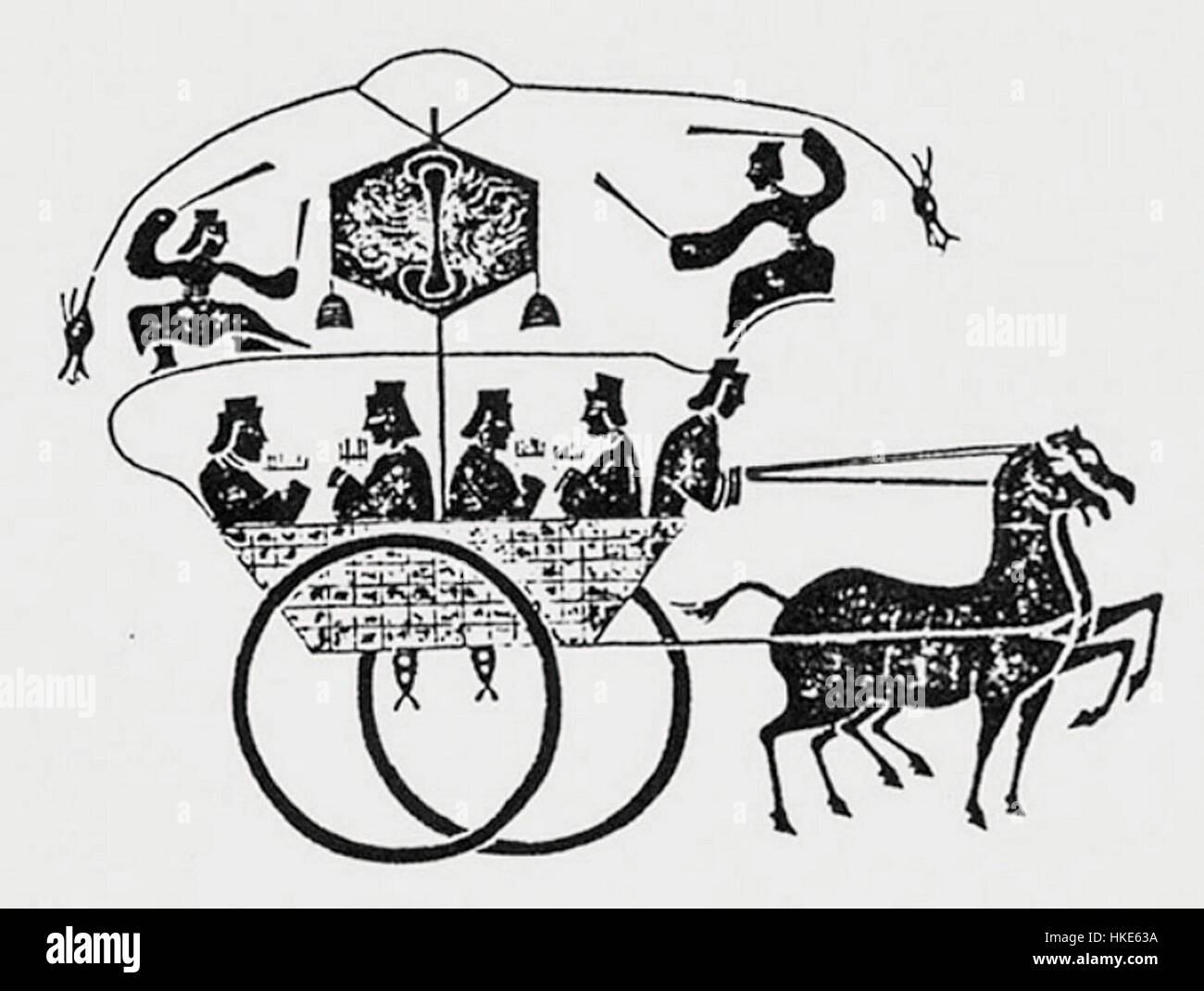 Han dynasty odometer cart Stock Photohttps://www.alamy.com/image-license-details/?v=1https://www.alamy.com/stock-photo-han-dynasty-odometer-cart-132463166.html
Han dynasty odometer cart Stock Photohttps://www.alamy.com/image-license-details/?v=1https://www.alamy.com/stock-photo-han-dynasty-odometer-cart-132463166.htmlRMHKE63A–Han dynasty odometer cart
 Maoling Mausoleum near Xian, Shaanxi Province, China. Ancient stone carving of galloping horse dates from Western Han Dynasty Stock Photohttps://www.alamy.com/image-license-details/?v=1https://www.alamy.com/stock-photo-maoling-mausoleum-near-xian-shaanxi-province-china-ancient-stone-carving-11423450.html
Maoling Mausoleum near Xian, Shaanxi Province, China. Ancient stone carving of galloping horse dates from Western Han Dynasty Stock Photohttps://www.alamy.com/image-license-details/?v=1https://www.alamy.com/stock-photo-maoling-mausoleum-near-xian-shaanxi-province-china-ancient-stone-carving-11423450.htmlRMA60W0Y–Maoling Mausoleum near Xian, Shaanxi Province, China. Ancient stone carving of galloping horse dates from Western Han Dynasty
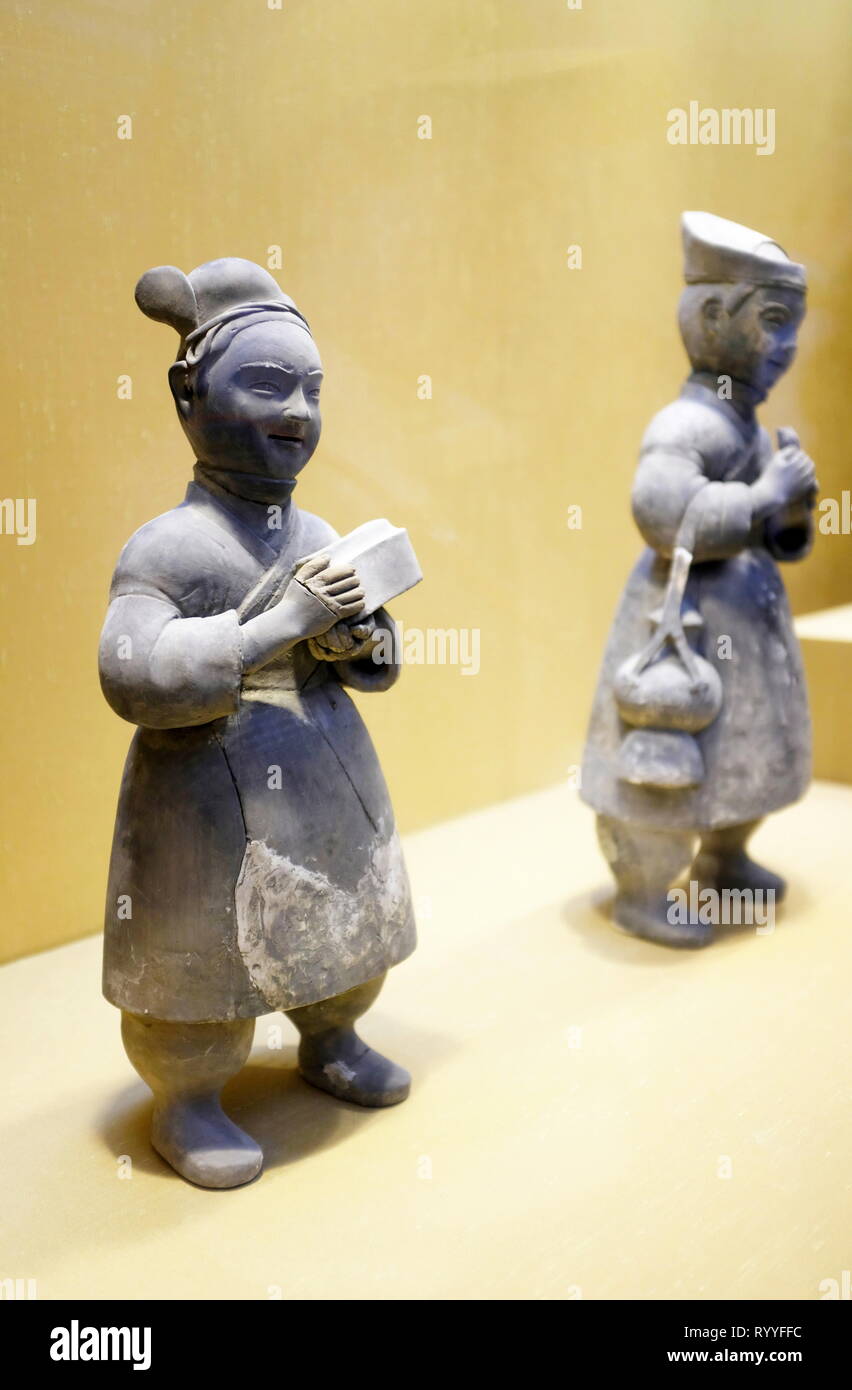 Ceramic figures of Servants with box in hands from Han Dynasty display in Suzhou Museum designed by I.M.Pei. Suzhou.Jiangsu province.China Stock Photohttps://www.alamy.com/image-license-details/?v=1https://www.alamy.com/ceramic-figures-of-servants-with-box-in-hands-from-han-dynasty-display-in-suzhou-museum-designed-by-impei-suzhoujiangsu-provincechina-image240935392.html
Ceramic figures of Servants with box in hands from Han Dynasty display in Suzhou Museum designed by I.M.Pei. Suzhou.Jiangsu province.China Stock Photohttps://www.alamy.com/image-license-details/?v=1https://www.alamy.com/ceramic-figures-of-servants-with-box-in-hands-from-han-dynasty-display-in-suzhou-museum-designed-by-impei-suzhoujiangsu-provincechina-image240935392.htmlRMRYYFFC–Ceramic figures of Servants with box in hands from Han Dynasty display in Suzhou Museum designed by I.M.Pei. Suzhou.Jiangsu province.China
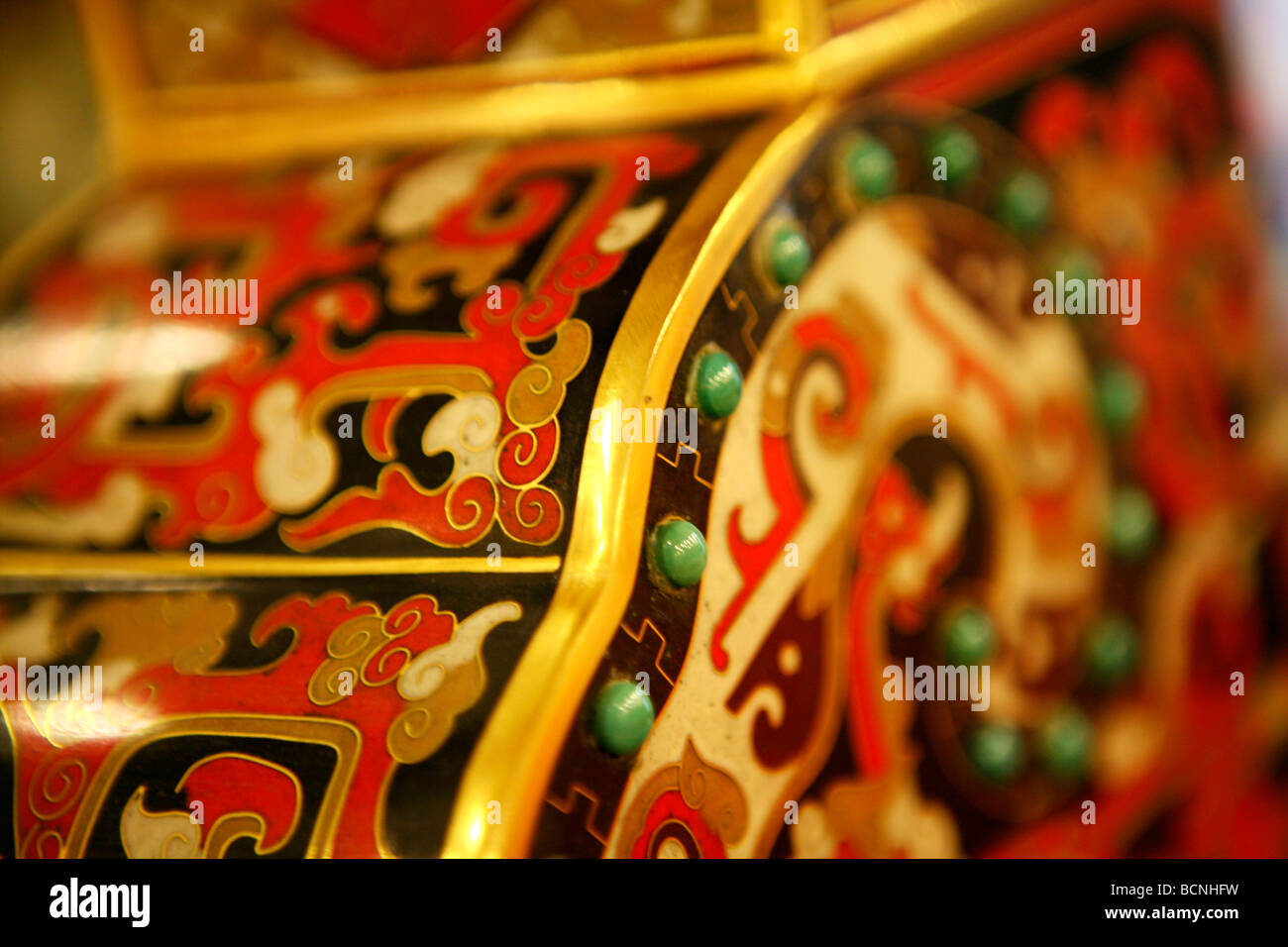 Detail of Cloisonné vase with Han Dynasty pattern, Beijing, China Stock Photohttps://www.alamy.com/image-license-details/?v=1https://www.alamy.com/stock-photo-detail-of-cloisonn-vase-with-han-dynasty-pattern-beijing-china-25061005.html
Detail of Cloisonné vase with Han Dynasty pattern, Beijing, China Stock Photohttps://www.alamy.com/image-license-details/?v=1https://www.alamy.com/stock-photo-detail-of-cloisonn-vase-with-han-dynasty-pattern-beijing-china-25061005.htmlRMBCNHFW–Detail of Cloisonné vase with Han Dynasty pattern, Beijing, China
 Rhino in BRONCE. Han Dynasty Chinese Art (206 a. C. - 220 d. C.). Stock Photohttps://www.alamy.com/image-license-details/?v=1https://www.alamy.com/rhino-in-bronce-han-dynasty-chinese-art-206-a-c-220-d-c-image210461307.html
Rhino in BRONCE. Han Dynasty Chinese Art (206 a. C. - 220 d. C.). Stock Photohttps://www.alamy.com/image-license-details/?v=1https://www.alamy.com/rhino-in-bronce-han-dynasty-chinese-art-206-a-c-220-d-c-image210461307.htmlRMP6B9F7–Rhino in BRONCE. Han Dynasty Chinese Art (206 a. C. - 220 d. C.).
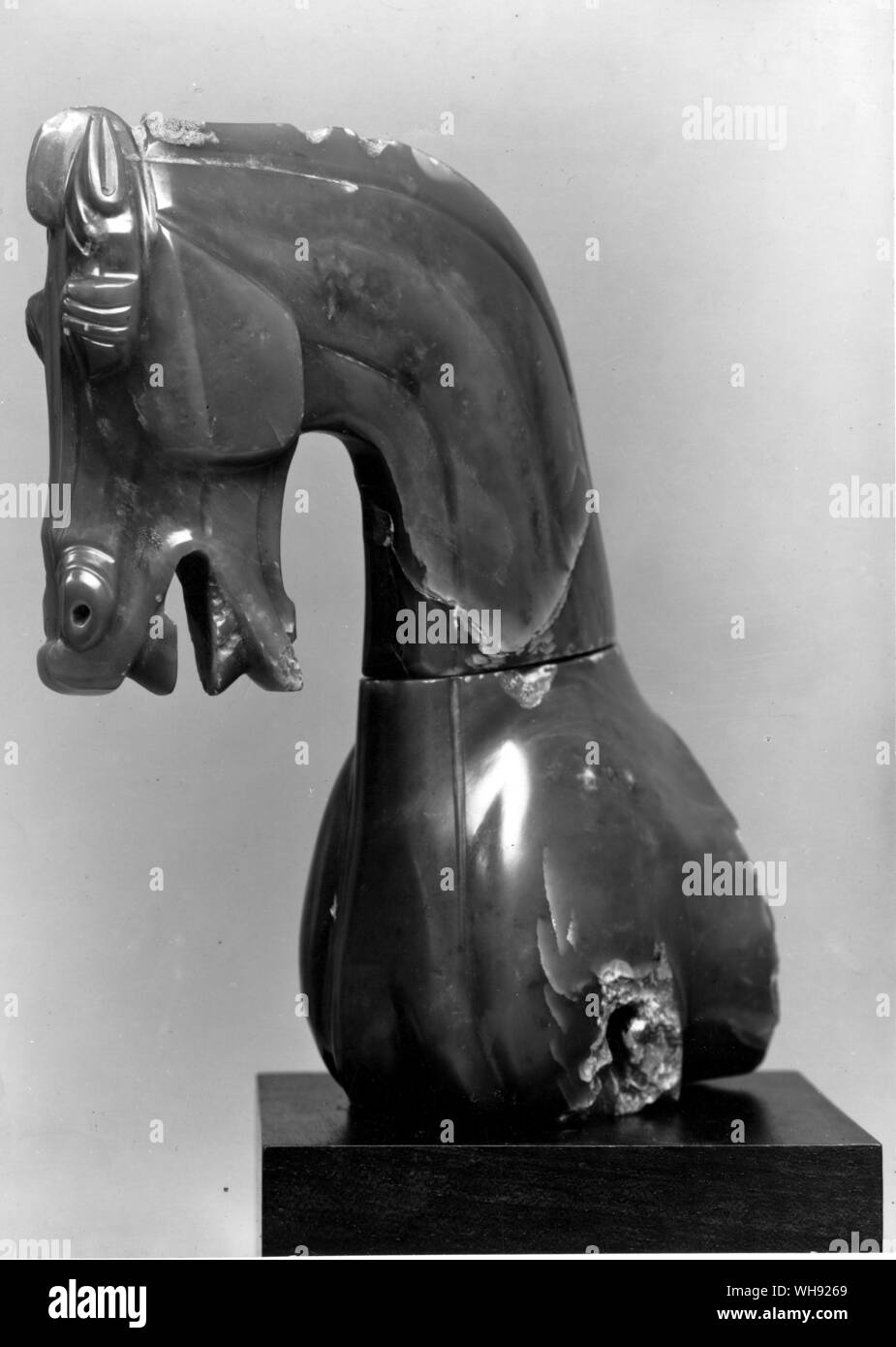 Chinese, Head of a Horse, Han Dynasty 206-220 AD. Jade, height is 5.5 inches (13.7 cm). Stock Photohttps://www.alamy.com/image-license-details/?v=1https://www.alamy.com/chinese-head-of-a-horse-han-dynasty-206-220-ad-jade-height-is-55-inches-137-cm-image268803985.html
Chinese, Head of a Horse, Han Dynasty 206-220 AD. Jade, height is 5.5 inches (13.7 cm). Stock Photohttps://www.alamy.com/image-license-details/?v=1https://www.alamy.com/chinese-head-of-a-horse-han-dynasty-206-220-ad-jade-height-is-55-inches-137-cm-image268803985.htmlRMWH9269–Chinese, Head of a Horse, Han Dynasty 206-220 AD. Jade, height is 5.5 inches (13.7 cm).
 Circular jade pitch pipe, Western Han dynasty, China, 122 BC. Stock Photohttps://www.alamy.com/image-license-details/?v=1https://www.alamy.com/stock-photo-circular-jade-pitch-pipe-western-han-dynasty-china-122-bc-28254471.html
Circular jade pitch pipe, Western Han dynasty, China, 122 BC. Stock Photohttps://www.alamy.com/image-license-details/?v=1https://www.alamy.com/stock-photo-circular-jade-pitch-pipe-western-han-dynasty-china-122-bc-28254471.htmlRMBHY2T7–Circular jade pitch pipe, Western Han dynasty, China, 122 BC.
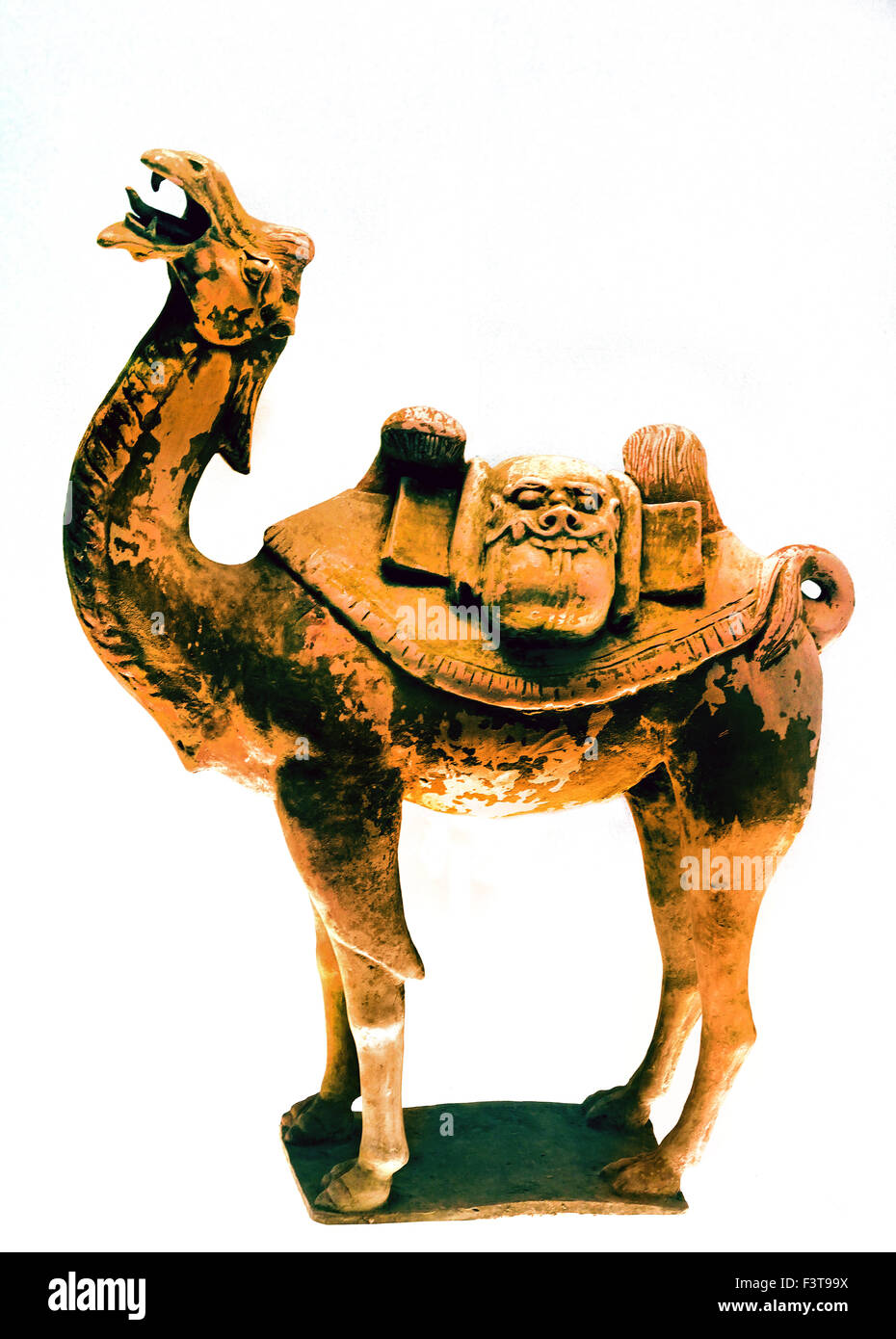 Colored Pottery Camel 618 - 907 AD Tang Han Dynasty ( Shanghai Museum of ancient Chinese art ) China Stock Photohttps://www.alamy.com/image-license-details/?v=1https://www.alamy.com/stock-photo-colored-pottery-camel-618-907-ad-tang-han-dynasty-shanghai-museum-88429990.html
Colored Pottery Camel 618 - 907 AD Tang Han Dynasty ( Shanghai Museum of ancient Chinese art ) China Stock Photohttps://www.alamy.com/image-license-details/?v=1https://www.alamy.com/stock-photo-colored-pottery-camel-618-907-ad-tang-han-dynasty-shanghai-museum-88429990.htmlRMF3T99X–Colored Pottery Camel 618 - 907 AD Tang Han Dynasty ( Shanghai Museum of ancient Chinese art ) China
 Tiny color painted Terracotta Army Soldiers from the Western Han dynasty that had been excavated from the Cahngling Tomb displayed at Xianyang museum in Xianyang City of Shaanxi Province China Stock Photohttps://www.alamy.com/image-license-details/?v=1https://www.alamy.com/stock-photo-tiny-color-painted-terracotta-army-soldiers-from-the-western-han-dynasty-58030956.html
Tiny color painted Terracotta Army Soldiers from the Western Han dynasty that had been excavated from the Cahngling Tomb displayed at Xianyang museum in Xianyang City of Shaanxi Province China Stock Photohttps://www.alamy.com/image-license-details/?v=1https://www.alamy.com/stock-photo-tiny-color-painted-terracotta-army-soldiers-from-the-western-han-dynasty-58030956.htmlRMDABF24–Tiny color painted Terracotta Army Soldiers from the Western Han dynasty that had been excavated from the Cahngling Tomb displayed at Xianyang museum in Xianyang City of Shaanxi Province China
 Eastern Han Dynasty, figurines of gods, Wu and Wei. Wu is a god with the head of a horse and a human body, Wei is a god with the head of a sheep and a human body. Stock Photohttps://www.alamy.com/image-license-details/?v=1https://www.alamy.com/eastern-han-dynasty-figurines-of-gods-wu-and-wei-wu-is-a-god-with-the-head-of-a-horse-and-a-human-body-wei-is-a-god-with-the-head-of-a-sheep-and-a-human-body-image481969440.html
Eastern Han Dynasty, figurines of gods, Wu and Wei. Wu is a god with the head of a horse and a human body, Wei is a god with the head of a sheep and a human body. Stock Photohttps://www.alamy.com/image-license-details/?v=1https://www.alamy.com/eastern-han-dynasty-figurines-of-gods-wu-and-wei-wu-is-a-god-with-the-head-of-a-horse-and-a-human-body-wei-is-a-god-with-the-head-of-a-sheep-and-a-human-body-image481969440.htmlRM2K03GX8–Eastern Han Dynasty, figurines of gods, Wu and Wei. Wu is a god with the head of a horse and a human body, Wei is a god with the head of a sheep and a human body.
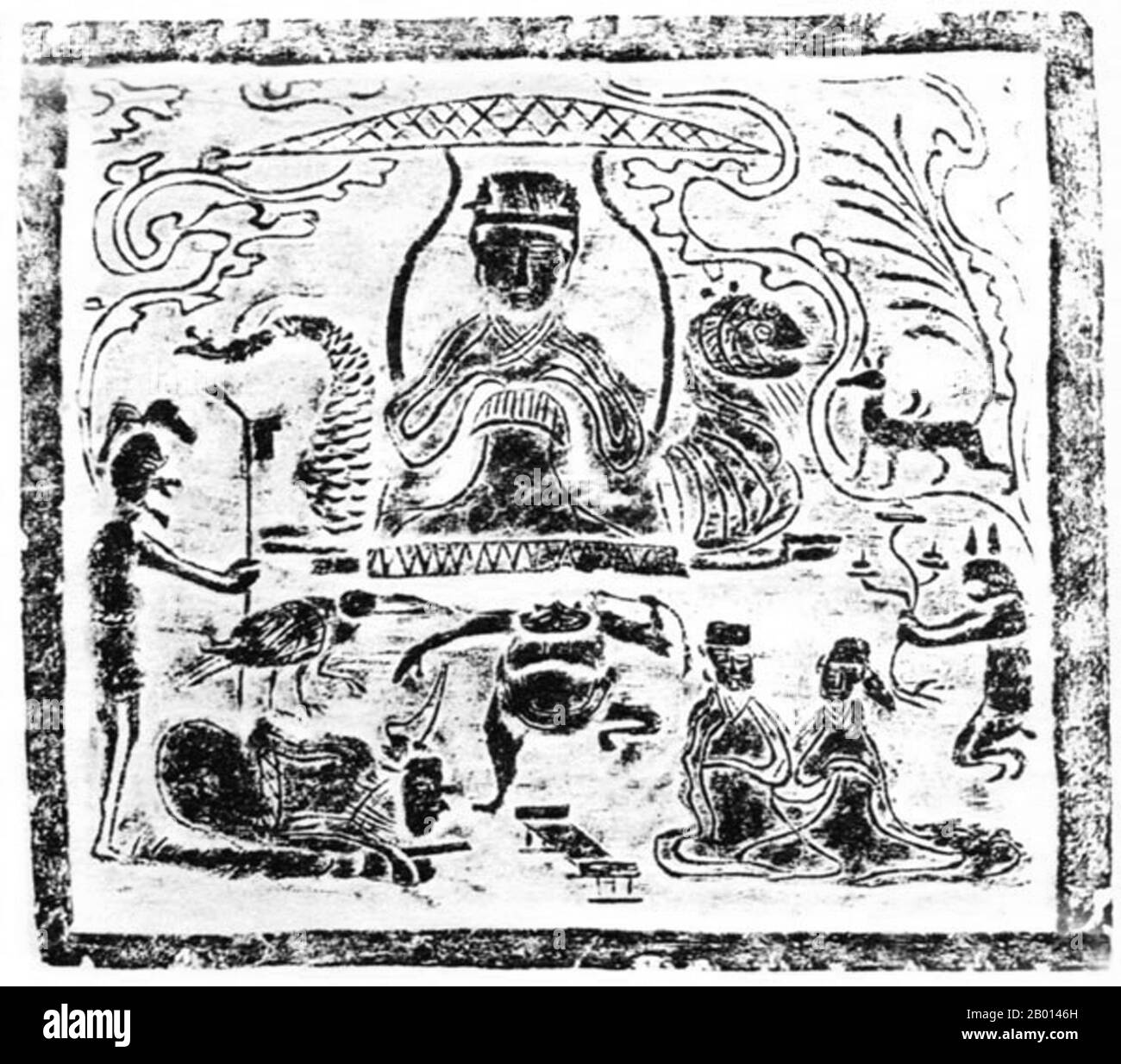 China: Xiwangmu, The Queen Mother of the West. Han Dynasty (202 BCE - 220 CE) mural. Xiwangmu, the Queen Mother of the West, is a goddess in Chinese religion. Though she is most often connected to Daoism, her existence and worship predates organised Daoism, with information tracing back to oracle bone inscriptions form the 15th century BCE. She is believed to be the dispenser of longevity, prosperity and eternal bliss. As the ancestor of Female Immortals, Xiwangmu lives in the Kunlun Mountains. All women who have attained immortality are under her rule. Stock Photohttps://www.alamy.com/image-license-details/?v=1https://www.alamy.com/china-xiwangmu-the-queen-mother-of-the-west-han-dynasty-202-bce-220-ce-mural-xiwangmu-the-queen-mother-of-the-west-is-a-goddess-in-chinese-religion-though-she-is-most-often-connected-to-daoism-her-existence-and-worship-predates-organised-daoism-with-information-tracing-back-to-oracle-bone-inscriptions-form-the-15th-century-bce-she-is-believed-to-be-the-dispenser-of-longevity-prosperity-and-eternal-bliss-as-the-ancestor-of-female-immortals-xiwangmu-lives-in-the-kunlun-mountains-all-women-who-have-attained-immortality-are-under-her-rule-image344232633.html
China: Xiwangmu, The Queen Mother of the West. Han Dynasty (202 BCE - 220 CE) mural. Xiwangmu, the Queen Mother of the West, is a goddess in Chinese religion. Though she is most often connected to Daoism, her existence and worship predates organised Daoism, with information tracing back to oracle bone inscriptions form the 15th century BCE. She is believed to be the dispenser of longevity, prosperity and eternal bliss. As the ancestor of Female Immortals, Xiwangmu lives in the Kunlun Mountains. All women who have attained immortality are under her rule. Stock Photohttps://www.alamy.com/image-license-details/?v=1https://www.alamy.com/china-xiwangmu-the-queen-mother-of-the-west-han-dynasty-202-bce-220-ce-mural-xiwangmu-the-queen-mother-of-the-west-is-a-goddess-in-chinese-religion-though-she-is-most-often-connected-to-daoism-her-existence-and-worship-predates-organised-daoism-with-information-tracing-back-to-oracle-bone-inscriptions-form-the-15th-century-bce-she-is-believed-to-be-the-dispenser-of-longevity-prosperity-and-eternal-bliss-as-the-ancestor-of-female-immortals-xiwangmu-lives-in-the-kunlun-mountains-all-women-who-have-attained-immortality-are-under-her-rule-image344232633.htmlRM2B0146H–China: Xiwangmu, The Queen Mother of the West. Han Dynasty (202 BCE - 220 CE) mural. Xiwangmu, the Queen Mother of the West, is a goddess in Chinese religion. Though she is most often connected to Daoism, her existence and worship predates organised Daoism, with information tracing back to oracle bone inscriptions form the 15th century BCE. She is believed to be the dispenser of longevity, prosperity and eternal bliss. As the ancestor of Female Immortals, Xiwangmu lives in the Kunlun Mountains. All women who have attained immortality are under her rule.
 Pottery equestrisn figurines West Han Dynasty China Stock Photohttps://www.alamy.com/image-license-details/?v=1https://www.alamy.com/stock-photo-pottery-equestrisn-figurines-west-han-dynasty-china-135873630.html
Pottery equestrisn figurines West Han Dynasty China Stock Photohttps://www.alamy.com/image-license-details/?v=1https://www.alamy.com/stock-photo-pottery-equestrisn-figurines-west-han-dynasty-china-135873630.htmlRFHW1G5J–Pottery equestrisn figurines West Han Dynasty China
 Chinese earthenware funerary models playing Liubo from the Han Dynasty at the British Museum, London, UK Stock Photohttps://www.alamy.com/image-license-details/?v=1https://www.alamy.com/chinese-earthenware-funerary-models-playing-liubo-from-the-han-dynasty-at-the-british-museum-london-uk-image569618875.html
Chinese earthenware funerary models playing Liubo from the Han Dynasty at the British Museum, London, UK Stock Photohttps://www.alamy.com/image-license-details/?v=1https://www.alamy.com/chinese-earthenware-funerary-models-playing-liubo-from-the-han-dynasty-at-the-british-museum-london-uk-image569618875.htmlRM2T2MAK7–Chinese earthenware funerary models playing Liubo from the Han Dynasty at the British Museum, London, UK
 model of wellhead, Unknown, Eastern Han dynasty, 25-220, earthenware with green glaze, H: 8-1/4 in., Chinese, Asian Art Stock Photohttps://www.alamy.com/image-license-details/?v=1https://www.alamy.com/model-of-wellhead-unknown-eastern-han-dynasty-25-220-earthenware-with-green-glaze-h-8-14-in-chinese-asian-art-image328773089.html
model of wellhead, Unknown, Eastern Han dynasty, 25-220, earthenware with green glaze, H: 8-1/4 in., Chinese, Asian Art Stock Photohttps://www.alamy.com/image-license-details/?v=1https://www.alamy.com/model-of-wellhead-unknown-eastern-han-dynasty-25-220-earthenware-with-green-glaze-h-8-14-in-chinese-asian-art-image328773089.htmlRM2A2TWC1–model of wellhead, Unknown, Eastern Han dynasty, 25-220, earthenware with green glaze, H: 8-1/4 in., Chinese, Asian Art
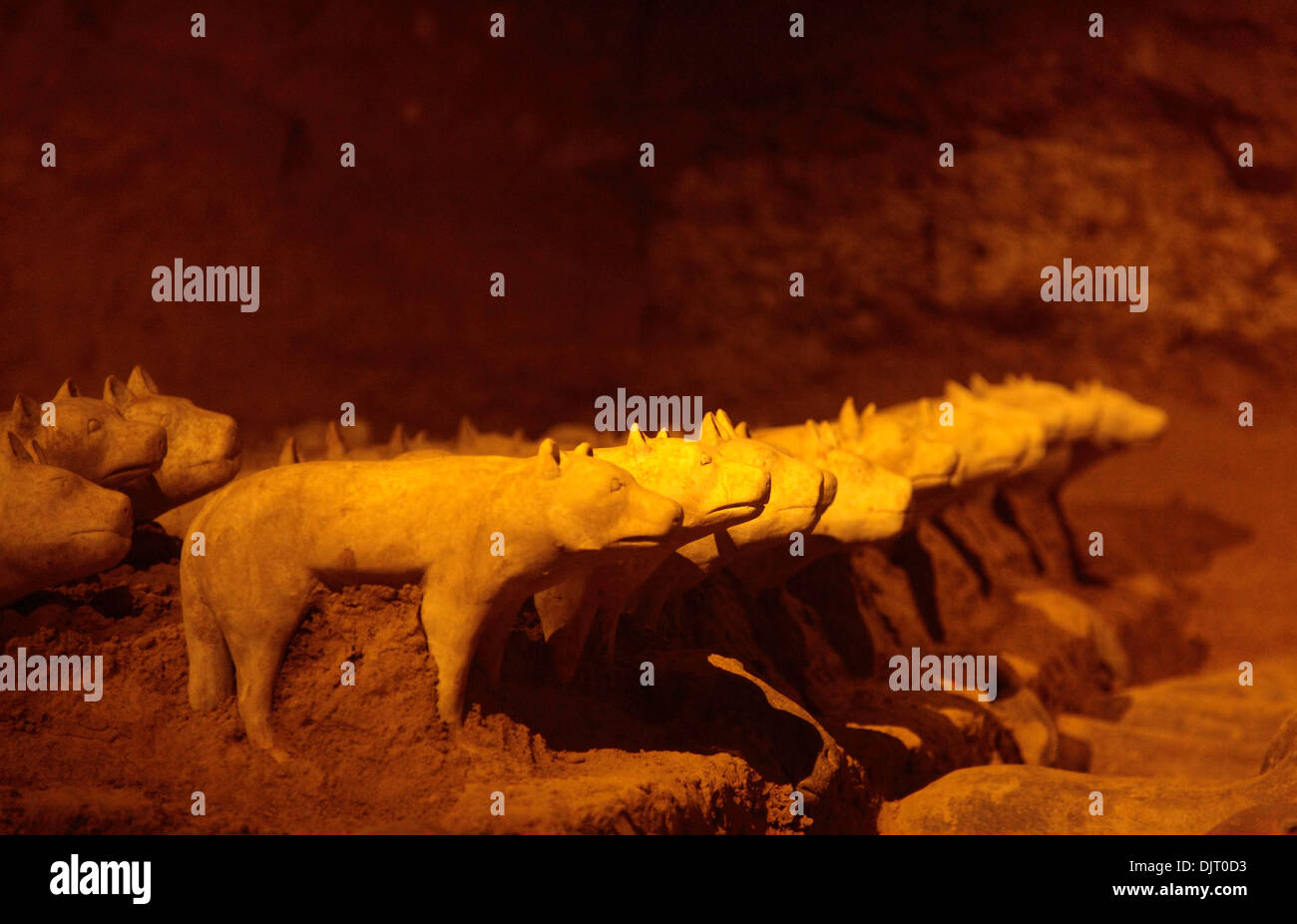 Yangling Mausoleum of Han Dynasty (Hanyangling), near Xian, Shaanxi, China Stock Photohttps://www.alamy.com/image-license-details/?v=1https://www.alamy.com/yangling-mausoleum-of-han-dynasty-hanyangling-near-xian-shaanxi-china-image63222127.html
Yangling Mausoleum of Han Dynasty (Hanyangling), near Xian, Shaanxi, China Stock Photohttps://www.alamy.com/image-license-details/?v=1https://www.alamy.com/yangling-mausoleum-of-han-dynasty-hanyangling-near-xian-shaanxi-china-image63222127.htmlRMDJT0D3–Yangling Mausoleum of Han Dynasty (Hanyangling), near Xian, Shaanxi, China
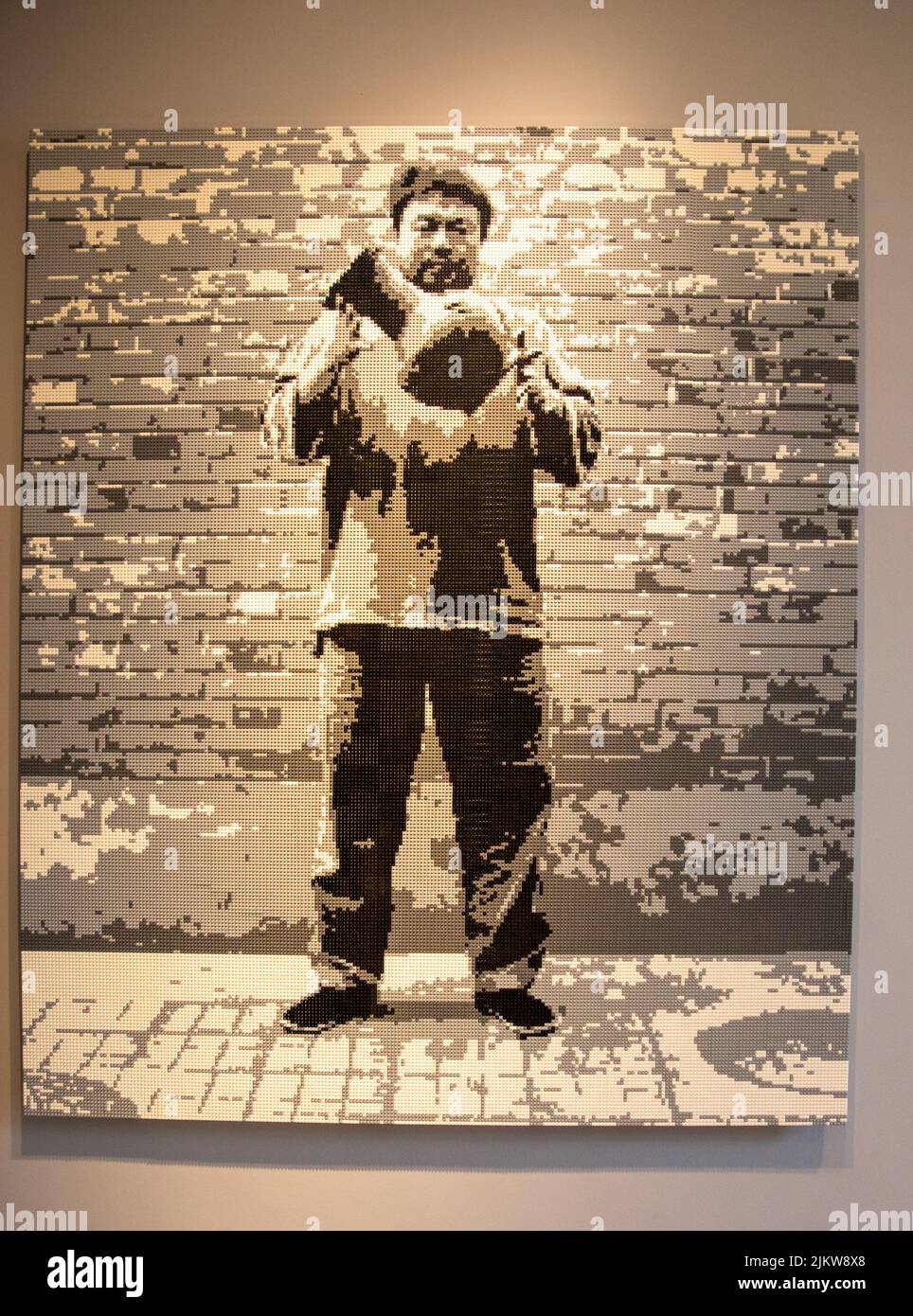 A vertical shot of Ai Weiwei dropping a Han Dynasty Urn as represented in lego bricks Stock Photohttps://www.alamy.com/image-license-details/?v=1https://www.alamy.com/a-vertical-shot-of-ai-weiwei-dropping-a-han-dynasty-urn-as-represented-in-lego-bricks-image476914208.html
A vertical shot of Ai Weiwei dropping a Han Dynasty Urn as represented in lego bricks Stock Photohttps://www.alamy.com/image-license-details/?v=1https://www.alamy.com/a-vertical-shot-of-ai-weiwei-dropping-a-han-dynasty-urn-as-represented-in-lego-bricks-image476914208.htmlRF2JKW8X8–A vertical shot of Ai Weiwei dropping a Han Dynasty Urn as represented in lego bricks
 Inspired by Tongue Amulet (han) in the Form of a Cicada, Chinese, Eastern Han dynasty, 25–220 AD, AD 1st century, Jade (nephrite), China, Asia, Jades, jewelry & personal accessories, height: 1 7/8 in. (4.8 cm, Reimagined by Artotop. Classic art reinvented with a modern twist. Design of warm cheerful glowing of brightness and light ray radiance. Photography inspired by surrealism and futurism, embracing dynamic energy of modern technology, movement, speed and revolutionize culture Stock Photohttps://www.alamy.com/image-license-details/?v=1https://www.alamy.com/inspired-by-tongue-amulet-han-in-the-form-of-a-cicada-chinese-eastern-han-dynasty-25220-ad-ad-1st-century-jade-nephrite-china-asia-jades-jewelry-personal-accessories-height-1-78-in-48-cm-reimagined-by-artotop-classic-art-reinvented-with-a-modern-twist-design-of-warm-cheerful-glowing-of-brightness-and-light-ray-radiance-photography-inspired-by-surrealism-and-futurism-embracing-dynamic-energy-of-modern-technology-movement-speed-and-revolutionize-culture-image459280765.html
Inspired by Tongue Amulet (han) in the Form of a Cicada, Chinese, Eastern Han dynasty, 25–220 AD, AD 1st century, Jade (nephrite), China, Asia, Jades, jewelry & personal accessories, height: 1 7/8 in. (4.8 cm, Reimagined by Artotop. Classic art reinvented with a modern twist. Design of warm cheerful glowing of brightness and light ray radiance. Photography inspired by surrealism and futurism, embracing dynamic energy of modern technology, movement, speed and revolutionize culture Stock Photohttps://www.alamy.com/image-license-details/?v=1https://www.alamy.com/inspired-by-tongue-amulet-han-in-the-form-of-a-cicada-chinese-eastern-han-dynasty-25220-ad-ad-1st-century-jade-nephrite-china-asia-jades-jewelry-personal-accessories-height-1-78-in-48-cm-reimagined-by-artotop-classic-art-reinvented-with-a-modern-twist-design-of-warm-cheerful-glowing-of-brightness-and-light-ray-radiance-photography-inspired-by-surrealism-and-futurism-embracing-dynamic-energy-of-modern-technology-movement-speed-and-revolutionize-culture-image459280765.htmlRF2HK618D–Inspired by Tongue Amulet (han) in the Form of a Cicada, Chinese, Eastern Han dynasty, 25–220 AD, AD 1st century, Jade (nephrite), China, Asia, Jades, jewelry & personal accessories, height: 1 7/8 in. (4.8 cm, Reimagined by Artotop. Classic art reinvented with a modern twist. Design of warm cheerful glowing of brightness and light ray radiance. Photography inspired by surrealism and futurism, embracing dynamic energy of modern technology, movement, speed and revolutionize culture
 WASHINGTON DC, United States — The Late Eastern Zhou and Han Dynasties Gallery at the Arthur M. Sackler Gallery in Washington DC. This exhibit showcases artifacts from two pivotal periods in ancient Chinese history, spanning from approximately 500 BCE to 220 CE, offering visitors insights into the artistic, cultural, and technological developments of early imperial China. Stock Photohttps://www.alamy.com/image-license-details/?v=1https://www.alamy.com/washington-dc-united-states-the-late-eastern-zhou-and-han-dynasties-gallery-at-the-arthur-m-sackler-gallery-in-washington-dc-this-exhibit-showcases-artifacts-from-two-pivotal-periods-in-ancient-chinese-history-spanning-from-approximately-500-bce-to-220-ce-offering-visitors-insights-into-the-artistic-cultural-and-technological-developments-of-early-imperial-china-image622400527.html
WASHINGTON DC, United States — The Late Eastern Zhou and Han Dynasties Gallery at the Arthur M. Sackler Gallery in Washington DC. This exhibit showcases artifacts from two pivotal periods in ancient Chinese history, spanning from approximately 500 BCE to 220 CE, offering visitors insights into the artistic, cultural, and technological developments of early imperial China. Stock Photohttps://www.alamy.com/image-license-details/?v=1https://www.alamy.com/washington-dc-united-states-the-late-eastern-zhou-and-han-dynasties-gallery-at-the-arthur-m-sackler-gallery-in-washington-dc-this-exhibit-showcases-artifacts-from-two-pivotal-periods-in-ancient-chinese-history-spanning-from-approximately-500-bce-to-220-ce-offering-visitors-insights-into-the-artistic-cultural-and-technological-developments-of-early-imperial-china-image622400527.htmlRM2Y4GP67–WASHINGTON DC, United States — The Late Eastern Zhou and Han Dynasties Gallery at the Arthur M. Sackler Gallery in Washington DC. This exhibit showcases artifacts from two pivotal periods in ancient Chinese history, spanning from approximately 500 BCE to 220 CE, offering visitors insights into the artistic, cultural, and technological developments of early imperial China.
 A RARE ELEGANTLY MODELLED POTTERY DANCING LADY FROM THE WESTERN HAN DYNASTY ON VIEW AT SOTHEBYS AS PART OF THEIR ASIAN ART AUCTION WHICH WILL BE HELD ON 14th NOVEMBER. THE FIGURE'S ESTIMATED VALUE IS BETWEEN 50,000-70,000 AND WERE MADE, ALONG WITH OTHER PORCELAIN OBJECTS, TO ACCOMPANY THE WEALTHY DECEASED IN THEIR BURIAL AS ENTERTAINMENT Stock Photohttps://www.alamy.com/image-license-details/?v=1https://www.alamy.com/a-rare-elegantly-modelled-pottery-dancing-lady-from-the-western-han-dynasty-on-view-at-sothebys-as-part-of-their-asian-art-auction-which-will-be-held-on-14th-november-the-figures-estimated-value-is-between-50000-70000-and-were-made-along-with-other-porcelain-objects-to-accompany-the-wealthy-deceased-in-their-burial-as-entertainment-image413533970.html
A RARE ELEGANTLY MODELLED POTTERY DANCING LADY FROM THE WESTERN HAN DYNASTY ON VIEW AT SOTHEBYS AS PART OF THEIR ASIAN ART AUCTION WHICH WILL BE HELD ON 14th NOVEMBER. THE FIGURE'S ESTIMATED VALUE IS BETWEEN 50,000-70,000 AND WERE MADE, ALONG WITH OTHER PORCELAIN OBJECTS, TO ACCOMPANY THE WEALTHY DECEASED IN THEIR BURIAL AS ENTERTAINMENT Stock Photohttps://www.alamy.com/image-license-details/?v=1https://www.alamy.com/a-rare-elegantly-modelled-pottery-dancing-lady-from-the-western-han-dynasty-on-view-at-sothebys-as-part-of-their-asian-art-auction-which-will-be-held-on-14th-november-the-figures-estimated-value-is-between-50000-70000-and-were-made-along-with-other-porcelain-objects-to-accompany-the-wealthy-deceased-in-their-burial-as-entertainment-image413533970.htmlRM2F0P2PA–A RARE ELEGANTLY MODELLED POTTERY DANCING LADY FROM THE WESTERN HAN DYNASTY ON VIEW AT SOTHEBYS AS PART OF THEIR ASIAN ART AUCTION WHICH WILL BE HELD ON 14th NOVEMBER. THE FIGURE'S ESTIMATED VALUE IS BETWEEN 50,000-70,000 AND WERE MADE, ALONG WITH OTHER PORCELAIN OBJECTS, TO ACCOMPANY THE WEALTHY DECEASED IN THEIR BURIAL AS ENTERTAINMENT
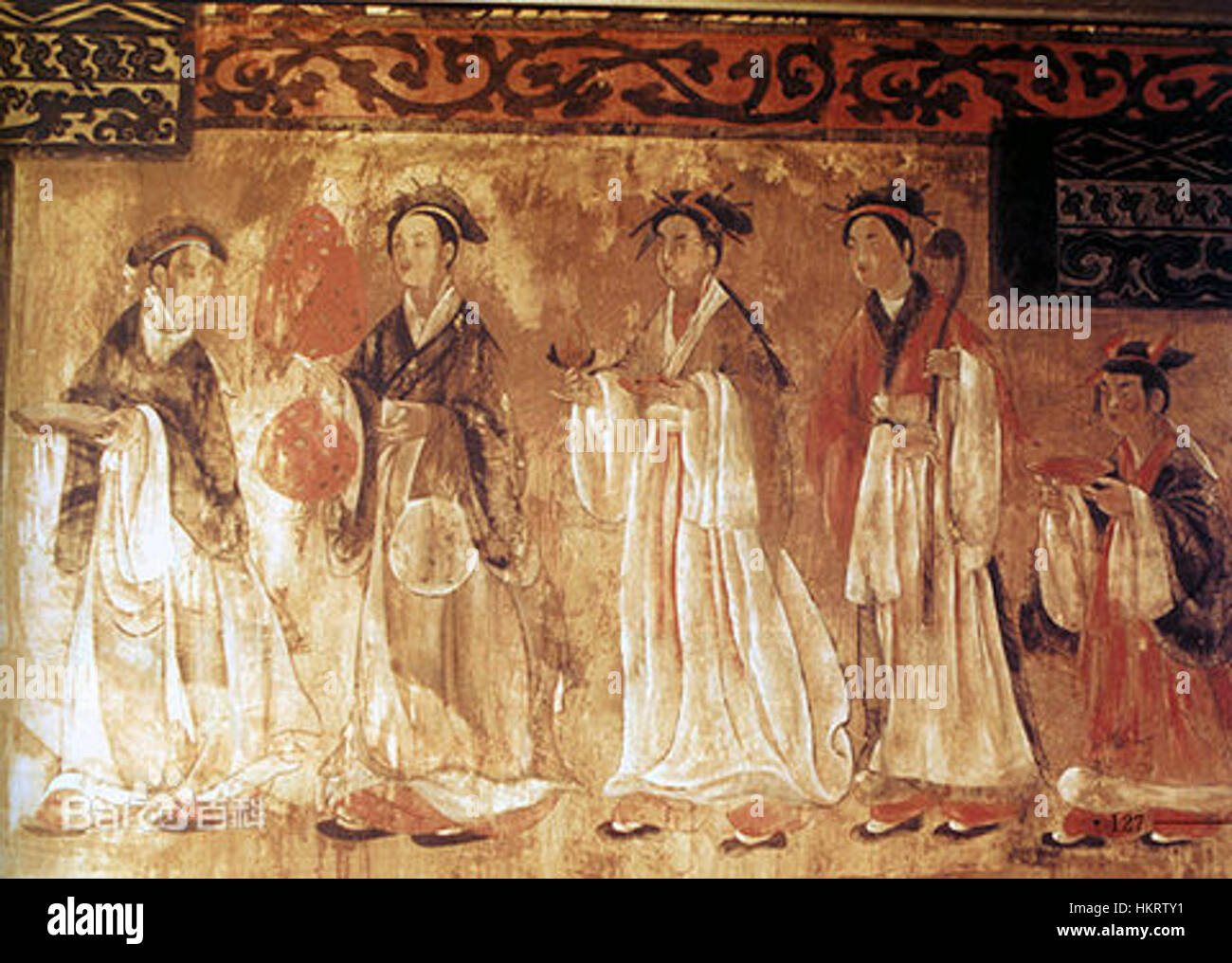 Dahuting mural, Eastern Han Dynasty Stock Photohttps://www.alamy.com/image-license-details/?v=1https://www.alamy.com/stock-photo-dahuting-mural-eastern-han-dynasty-132675509.html
Dahuting mural, Eastern Han Dynasty Stock Photohttps://www.alamy.com/image-license-details/?v=1https://www.alamy.com/stock-photo-dahuting-mural-eastern-han-dynasty-132675509.htmlRMHKRTY1–Dahuting mural, Eastern Han Dynasty
 Maoling Mausoleum near Xian, Shaanxi Province, China. Ancient old stone carving of ox dates from Western Han Dynasty Stock Photohttps://www.alamy.com/image-license-details/?v=1https://www.alamy.com/stock-photo-maoling-mausoleum-near-xian-shaanxi-province-china-ancient-old-stone-11423369.html
Maoling Mausoleum near Xian, Shaanxi Province, China. Ancient old stone carving of ox dates from Western Han Dynasty Stock Photohttps://www.alamy.com/image-license-details/?v=1https://www.alamy.com/stock-photo-maoling-mausoleum-near-xian-shaanxi-province-china-ancient-old-stone-11423369.htmlRFA60TPJ–Maoling Mausoleum near Xian, Shaanxi Province, China. Ancient old stone carving of ox dates from Western Han Dynasty
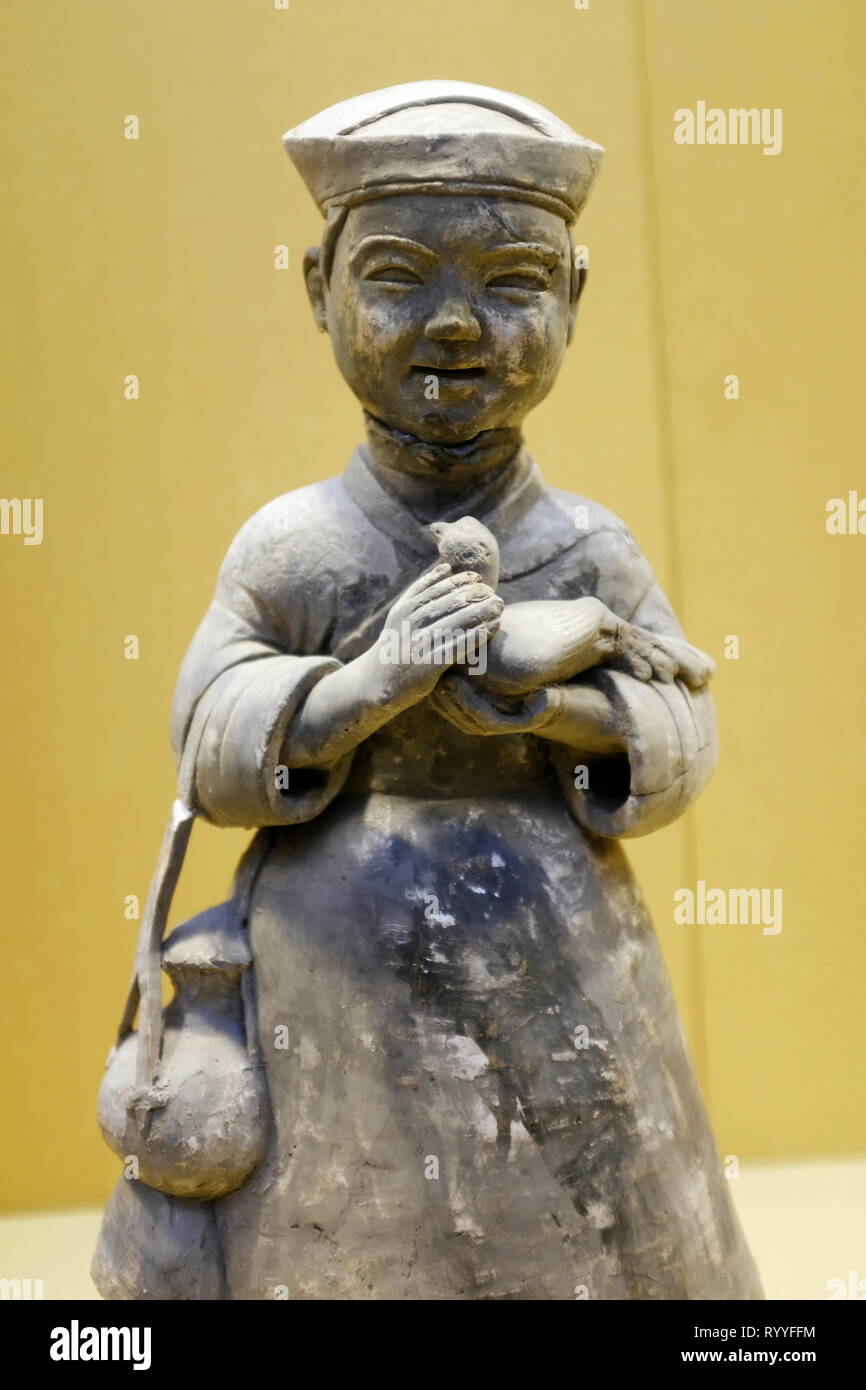 A ceramic figure of Servants with box in hands from Han Dynasty display in Suzhou Museum designed by I.M.Pei. Suzhou.Jiangsu province.China Stock Photohttps://www.alamy.com/image-license-details/?v=1https://www.alamy.com/a-ceramic-figure-of-servants-with-box-in-hands-from-han-dynasty-display-in-suzhou-museum-designed-by-impei-suzhoujiangsu-provincechina-image240935400.html
A ceramic figure of Servants with box in hands from Han Dynasty display in Suzhou Museum designed by I.M.Pei. Suzhou.Jiangsu province.China Stock Photohttps://www.alamy.com/image-license-details/?v=1https://www.alamy.com/a-ceramic-figure-of-servants-with-box-in-hands-from-han-dynasty-display-in-suzhou-museum-designed-by-impei-suzhoujiangsu-provincechina-image240935400.htmlRMRYYFFM–A ceramic figure of Servants with box in hands from Han Dynasty display in Suzhou Museum designed by I.M.Pei. Suzhou.Jiangsu province.China
 Ai Weiwei installation at the Brooklyn Museum, Brooklyn, NY. The series consists of Han dynasty vases dipped in industrial paint Stock Photohttps://www.alamy.com/image-license-details/?v=1https://www.alamy.com/stock-photo-ai-weiwei-installation-at-the-brooklyn-museum-brooklyn-ny-the-series-70990959.html
Ai Weiwei installation at the Brooklyn Museum, Brooklyn, NY. The series consists of Han dynasty vases dipped in industrial paint Stock Photohttps://www.alamy.com/image-license-details/?v=1https://www.alamy.com/stock-photo-ai-weiwei-installation-at-the-brooklyn-museum-brooklyn-ny-the-series-70990959.htmlRME3DWKB–Ai Weiwei installation at the Brooklyn Museum, Brooklyn, NY. The series consists of Han dynasty vases dipped in industrial paint
 Mirror Based on Han-Dynasty Prototype with Cosmological Design. Culture: Japan. Dimensions: Diam. 7 3/4 in. (19.7 cm); D. 1/2 in. (1.3 cm). Date: 4th-5th century. Museum: Metropolitan Museum of Art, New York, USA. Stock Photohttps://www.alamy.com/image-license-details/?v=1https://www.alamy.com/mirror-based-on-han-dynasty-prototype-with-cosmological-design-culture-japan-dimensions-diam-7-34-in-197-cm-d-12-in-13-cm-date-4th-5th-century-museum-metropolitan-museum-of-art-new-york-usa-image212870557.html
Mirror Based on Han-Dynasty Prototype with Cosmological Design. Culture: Japan. Dimensions: Diam. 7 3/4 in. (19.7 cm); D. 1/2 in. (1.3 cm). Date: 4th-5th century. Museum: Metropolitan Museum of Art, New York, USA. Stock Photohttps://www.alamy.com/image-license-details/?v=1https://www.alamy.com/mirror-based-on-han-dynasty-prototype-with-cosmological-design-culture-japan-dimensions-diam-7-34-in-197-cm-d-12-in-13-cm-date-4th-5th-century-museum-metropolitan-museum-of-art-new-york-usa-image212870557.htmlRMPA92FW–Mirror Based on Han-Dynasty Prototype with Cosmological Design. Culture: Japan. Dimensions: Diam. 7 3/4 in. (19.7 cm); D. 1/2 in. (1.3 cm). Date: 4th-5th century. Museum: Metropolitan Museum of Art, New York, USA.
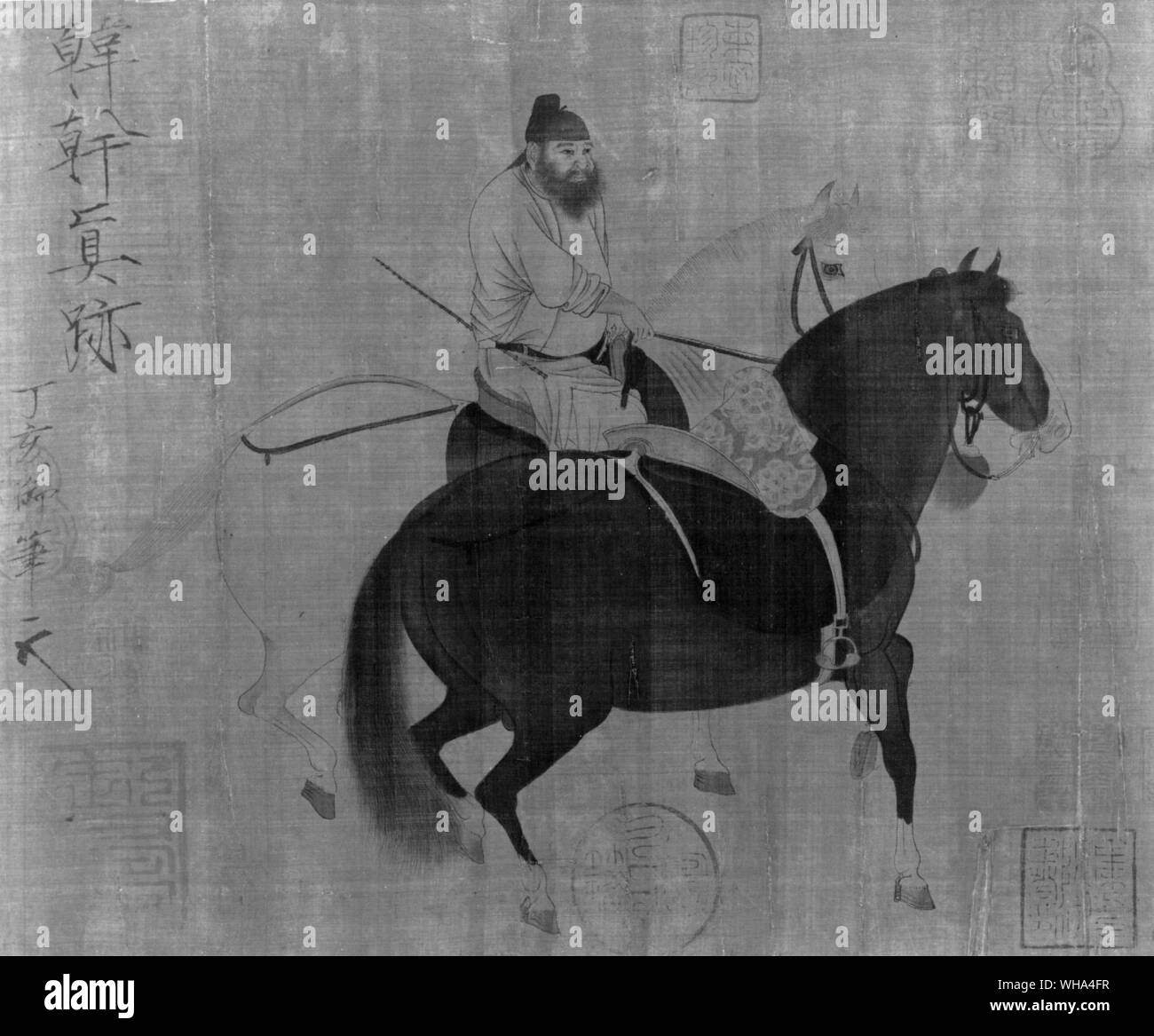 Han Kan. Tang painter 618-906. Han-Kan lived in Chang-an, the capital of the Tang dynasty (618 -907). He painted Buddhist and Taoist wall paintings but became mostly famous for his great compositions of horse paintings which represented the knightly spirit of his time. He is considered one of the greatest classical Chinese master artists of animal painting. Stock Photohttps://www.alamy.com/image-license-details/?v=1https://www.alamy.com/han-kan-tang-painter-618-906-han-kan-lived-in-chang-an-the-capital-of-the-tang-dynasty-618-907-he-painted-buddhist-and-taoist-wall-paintings-but-became-mostly-famous-for-his-great-compositions-of-horse-paintings-which-represented-the-knightly-spirit-of-his-time-he-is-considered-one-of-the-greatest-classical-chinese-master-artists-of-animal-painting-image268827771.html
Han Kan. Tang painter 618-906. Han-Kan lived in Chang-an, the capital of the Tang dynasty (618 -907). He painted Buddhist and Taoist wall paintings but became mostly famous for his great compositions of horse paintings which represented the knightly spirit of his time. He is considered one of the greatest classical Chinese master artists of animal painting. Stock Photohttps://www.alamy.com/image-license-details/?v=1https://www.alamy.com/han-kan-tang-painter-618-906-han-kan-lived-in-chang-an-the-capital-of-the-tang-dynasty-618-907-he-painted-buddhist-and-taoist-wall-paintings-but-became-mostly-famous-for-his-great-compositions-of-horse-paintings-which-represented-the-knightly-spirit-of-his-time-he-is-considered-one-of-the-greatest-classical-chinese-master-artists-of-animal-painting-image268827771.htmlRMWHA4FR–Han Kan. Tang painter 618-906. Han-Kan lived in Chang-an, the capital of the Tang dynasty (618 -907). He painted Buddhist and Taoist wall paintings but became mostly famous for his great compositions of horse paintings which represented the knightly spirit of his time. He is considered one of the greatest classical Chinese master artists of animal painting.
 Chinese terracotta horse head from the Han Dynasty 200 BC Stock Photohttps://www.alamy.com/image-license-details/?v=1https://www.alamy.com/stock-photo-chinese-terracotta-horse-head-from-the-han-dynasty-200-bc-78453212.html
Chinese terracotta horse head from the Han Dynasty 200 BC Stock Photohttps://www.alamy.com/image-license-details/?v=1https://www.alamy.com/stock-photo-chinese-terracotta-horse-head-from-the-han-dynasty-200-bc-78453212.htmlRMEFHRTC–Chinese terracotta horse head from the Han Dynasty 200 BC
 Polychrome Glazed Pottery Horse 618 - 907 AD Tang Han Dynasty ( Shanghai Museum of ancient Chinese art ) China Stock Photohttps://www.alamy.com/image-license-details/?v=1https://www.alamy.com/stock-photo-polychrome-glazed-pottery-horse-618-907-ad-tang-han-dynasty-shanghai-88429987.html
Polychrome Glazed Pottery Horse 618 - 907 AD Tang Han Dynasty ( Shanghai Museum of ancient Chinese art ) China Stock Photohttps://www.alamy.com/image-license-details/?v=1https://www.alamy.com/stock-photo-polychrome-glazed-pottery-horse-618-907-ad-tang-han-dynasty-shanghai-88429987.htmlRMF3T99R–Polychrome Glazed Pottery Horse 618 - 907 AD Tang Han Dynasty ( Shanghai Museum of ancient Chinese art ) China
 Grey pottery house with a verandah Han Dynasty 206bc 220ad Hong Kong Museum of Art Hong Kong China Stock Photohttps://www.alamy.com/image-license-details/?v=1https://www.alamy.com/stock-photo-grey-pottery-house-with-a-verandah-han-dynasty-206bc-220ad-hong-kong-16776747.html
Grey pottery house with a verandah Han Dynasty 206bc 220ad Hong Kong Museum of Art Hong Kong China Stock Photohttps://www.alamy.com/image-license-details/?v=1https://www.alamy.com/stock-photo-grey-pottery-house-with-a-verandah-han-dynasty-206bc-220ad-hong-kong-16776747.htmlRMAX9WDG–Grey pottery house with a verandah Han Dynasty 206bc 220ad Hong Kong Museum of Art Hong Kong China
 Eastern Han Dynasty, figurines of gods, Ch'en and Ssu. Ch'en is a god with the head of a dragon and a human body, Ssu is a god with the head of a snake and a human body Stock Photohttps://www.alamy.com/image-license-details/?v=1https://www.alamy.com/eastern-han-dynasty-figurines-of-gods-chen-and-ssu-chen-is-a-god-with-the-head-of-a-dragon-and-a-human-body-ssu-is-a-god-with-the-head-of-a-snake-and-a-human-body-image481969413.html
Eastern Han Dynasty, figurines of gods, Ch'en and Ssu. Ch'en is a god with the head of a dragon and a human body, Ssu is a god with the head of a snake and a human body Stock Photohttps://www.alamy.com/image-license-details/?v=1https://www.alamy.com/eastern-han-dynasty-figurines-of-gods-chen-and-ssu-chen-is-a-god-with-the-head-of-a-dragon-and-a-human-body-ssu-is-a-god-with-the-head-of-a-snake-and-a-human-body-image481969413.htmlRM2K03GW9–Eastern Han Dynasty, figurines of gods, Ch'en and Ssu. Ch'en is a god with the head of a dragon and a human body, Ssu is a god with the head of a snake and a human body
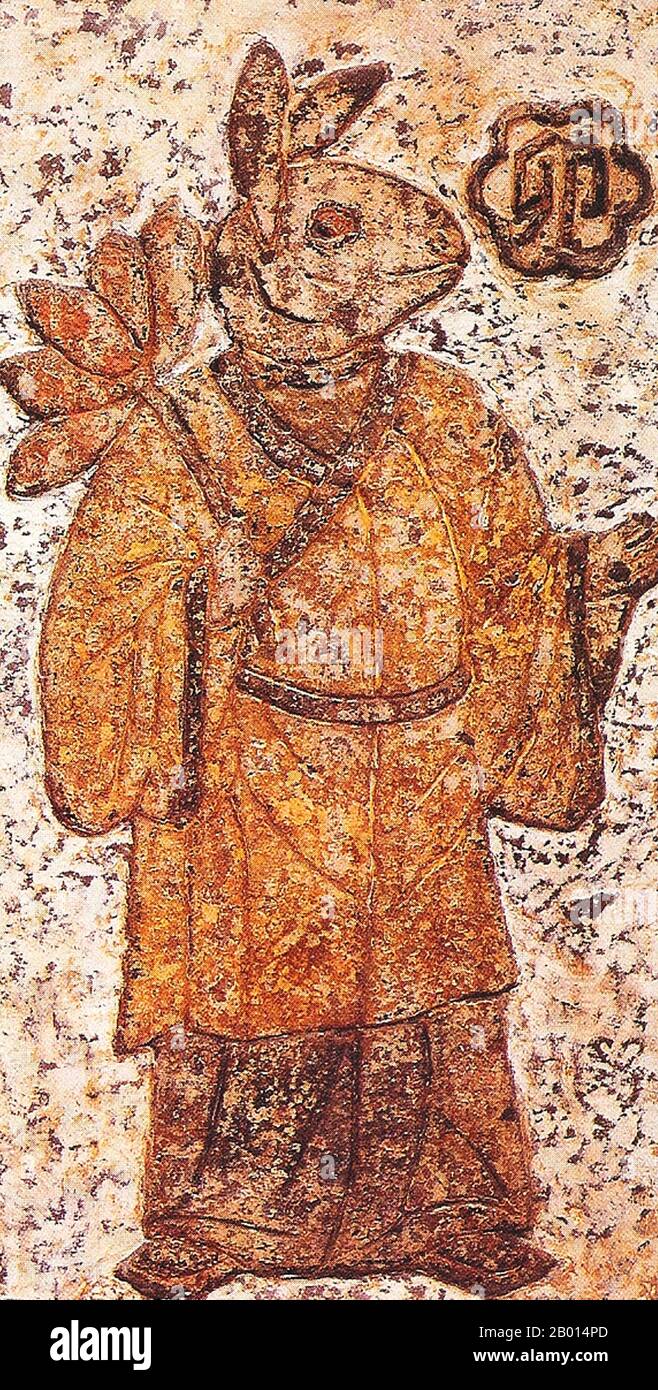 China: Guardian Deity of the Morning, ceramic tile painting, Han Dynasty (202 BCE - 220 CE). Painting on a ceramic tile from the Chinese Han Dynasty. This figure, wearing Han Dynasty robes, represents the Guardian Spirit of Dawn (from 5 to 7 am). Stock Photohttps://www.alamy.com/image-license-details/?v=1https://www.alamy.com/china-guardian-deity-of-the-morning-ceramic-tile-painting-han-dynasty-202-bce-220-ce-painting-on-a-ceramic-tile-from-the-chinese-han-dynasty-this-figure-wearing-han-dynasty-robes-represents-the-guardian-spirit-of-dawn-from-5-to-7-am-image344233077.html
China: Guardian Deity of the Morning, ceramic tile painting, Han Dynasty (202 BCE - 220 CE). Painting on a ceramic tile from the Chinese Han Dynasty. This figure, wearing Han Dynasty robes, represents the Guardian Spirit of Dawn (from 5 to 7 am). Stock Photohttps://www.alamy.com/image-license-details/?v=1https://www.alamy.com/china-guardian-deity-of-the-morning-ceramic-tile-painting-han-dynasty-202-bce-220-ce-painting-on-a-ceramic-tile-from-the-chinese-han-dynasty-this-figure-wearing-han-dynasty-robes-represents-the-guardian-spirit-of-dawn-from-5-to-7-am-image344233077.htmlRM2B014PD–China: Guardian Deity of the Morning, ceramic tile painting, Han Dynasty (202 BCE - 220 CE). Painting on a ceramic tile from the Chinese Han Dynasty. This figure, wearing Han Dynasty robes, represents the Guardian Spirit of Dawn (from 5 to 7 am).
 bronze mirror with studs and leaf pattern, Han Dynasty, Xian Museum, Xian, China Stock Photohttps://www.alamy.com/image-license-details/?v=1https://www.alamy.com/bronze-mirror-with-studs-and-leaf-pattern-han-dynasty-xian-museum-xian-china-image349075819.html
bronze mirror with studs and leaf pattern, Han Dynasty, Xian Museum, Xian, China Stock Photohttps://www.alamy.com/image-license-details/?v=1https://www.alamy.com/bronze-mirror-with-studs-and-leaf-pattern-han-dynasty-xian-museum-xian-china-image349075819.htmlRM2B7WNNF–bronze mirror with studs and leaf pattern, Han Dynasty, Xian Museum, Xian, China
 N/A. English: Landscape by Gao Fenghan (Kao Feng-han), Qing dynasty, dated 1727, ink and color on paper, Honolulu Museum of Art, accession 4083.1 . dated 1727. Gao Fenghan (Kao Feng-han) 3 'Landscape' by Gao Fenghan, 1727, Honolulu Museum of Art, 4083.1 Stock Photohttps://www.alamy.com/image-license-details/?v=1https://www.alamy.com/na-english-landscape-by-gao-fenghan-kao-feng-han-qing-dynasty-dated-1727-ink-and-color-on-paper-honolulu-museum-of-art-accession-40831-dated-1727-gao-fenghan-kao-feng-han-3-landscape-by-gao-fenghan-1727-honolulu-museum-of-art-40831-image209970705.html
N/A. English: Landscape by Gao Fenghan (Kao Feng-han), Qing dynasty, dated 1727, ink and color on paper, Honolulu Museum of Art, accession 4083.1 . dated 1727. Gao Fenghan (Kao Feng-han) 3 'Landscape' by Gao Fenghan, 1727, Honolulu Museum of Art, 4083.1 Stock Photohttps://www.alamy.com/image-license-details/?v=1https://www.alamy.com/na-english-landscape-by-gao-fenghan-kao-feng-han-qing-dynasty-dated-1727-ink-and-color-on-paper-honolulu-museum-of-art-accession-40831-dated-1727-gao-fenghan-kao-feng-han-3-landscape-by-gao-fenghan-1727-honolulu-museum-of-art-40831-image209970705.htmlRMP5GYNN–N/A. English: Landscape by Gao Fenghan (Kao Feng-han), Qing dynasty, dated 1727, ink and color on paper, Honolulu Museum of Art, accession 4083.1 . dated 1727. Gao Fenghan (Kao Feng-han) 3 'Landscape' by Gao Fenghan, 1727, Honolulu Museum of Art, 4083.1
 model of a stove, Unknown, Eastern Han dynasty, 25-220, stoneware with brown glaze, H: 8 11-3/4, Asian Art Stock Photohttps://www.alamy.com/image-license-details/?v=1https://www.alamy.com/model-of-a-stove-unknown-eastern-han-dynasty-25-220-stoneware-with-brown-glaze-h-8-11-34-asian-art-image328773103.html
model of a stove, Unknown, Eastern Han dynasty, 25-220, stoneware with brown glaze, H: 8 11-3/4, Asian Art Stock Photohttps://www.alamy.com/image-license-details/?v=1https://www.alamy.com/model-of-a-stove-unknown-eastern-han-dynasty-25-220-stoneware-with-brown-glaze-h-8-11-34-asian-art-image328773103.htmlRM2A2TWCF–model of a stove, Unknown, Eastern Han dynasty, 25-220, stoneware with brown glaze, H: 8 11-3/4, Asian Art
 British Museum - The statue of Lo Han illustration Stock Photohttps://www.alamy.com/image-license-details/?v=1https://www.alamy.com/stock-photo-british-museum-the-statue-of-lo-han-illustration-173322708.html
British Museum - The statue of Lo Han illustration Stock Photohttps://www.alamy.com/image-license-details/?v=1https://www.alamy.com/stock-photo-british-museum-the-statue-of-lo-han-illustration-173322708.htmlRMM1YETM–British Museum - The statue of Lo Han illustration
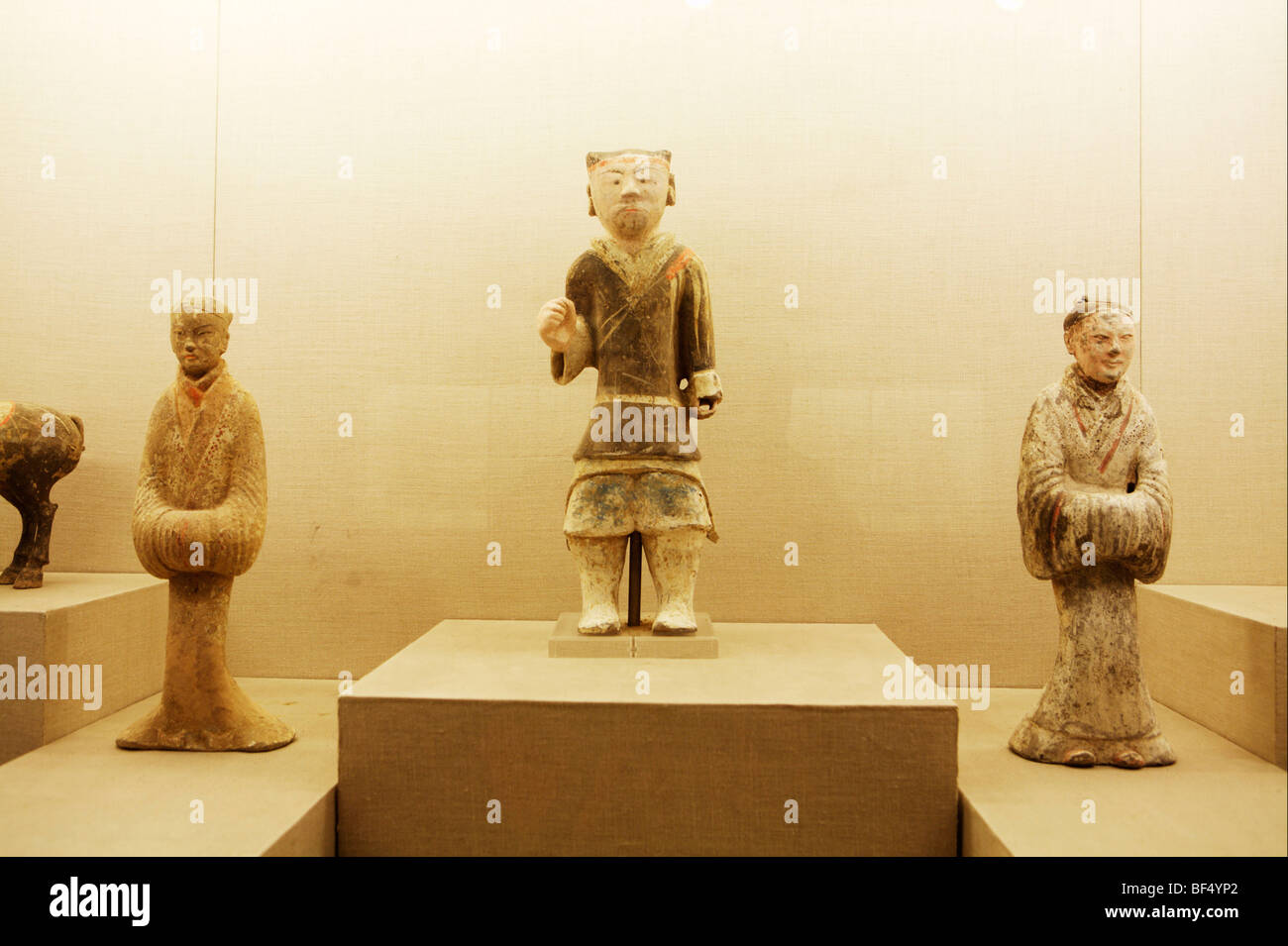 Clay figurines from Han Dynasty exhibited in Authur M. Sackler Museum of Art and Archaeology, Peking University, Beijing, China Stock Photohttps://www.alamy.com/image-license-details/?v=1https://www.alamy.com/stock-photo-clay-figurines-from-han-dynasty-exhibited-in-authur-m-sackler-museum-26539802.html
Clay figurines from Han Dynasty exhibited in Authur M. Sackler Museum of Art and Archaeology, Peking University, Beijing, China Stock Photohttps://www.alamy.com/image-license-details/?v=1https://www.alamy.com/stock-photo-clay-figurines-from-han-dynasty-exhibited-in-authur-m-sackler-museum-26539802.htmlRMBF4YP2–Clay figurines from Han Dynasty exhibited in Authur M. Sackler Museum of Art and Archaeology, Peking University, Beijing, China
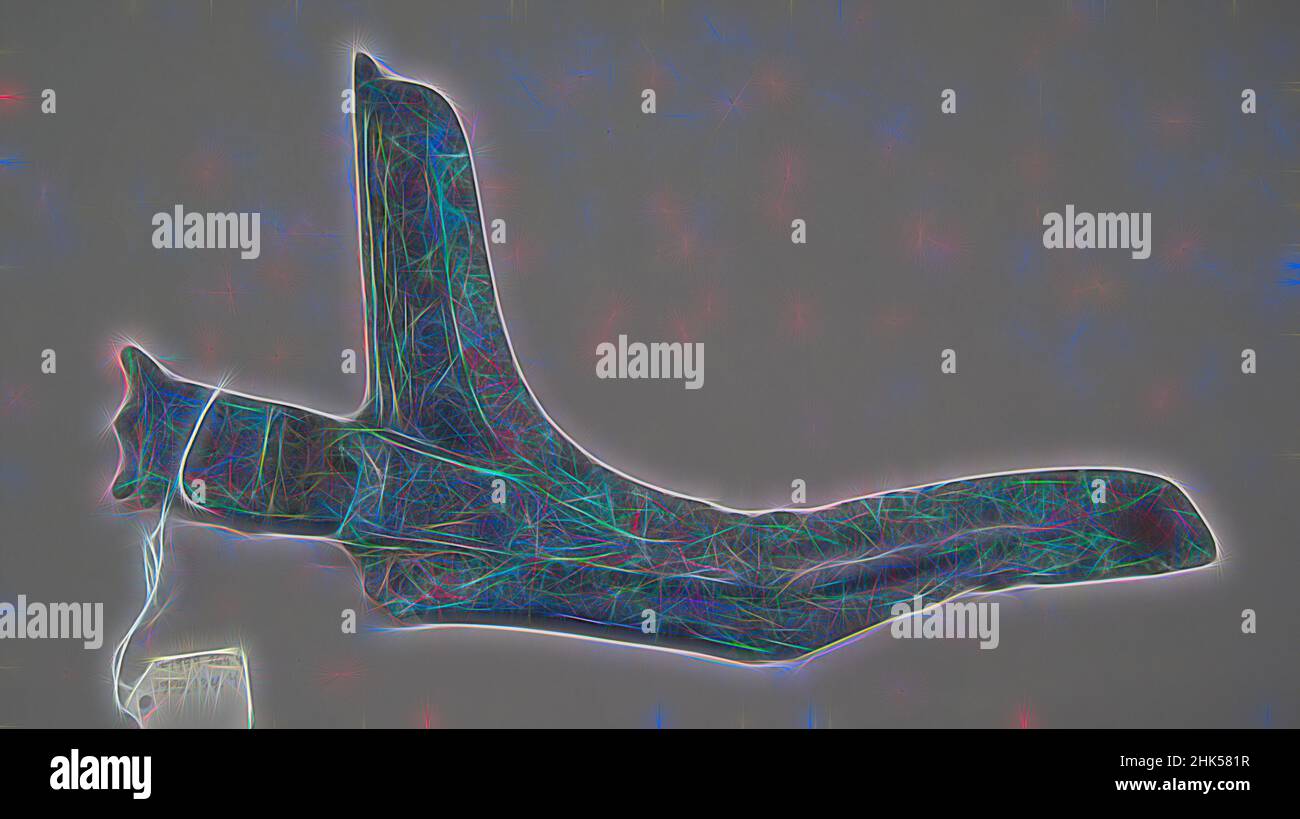 Inspired by Dagger-Axe or Halberd with Whorl Decoration, Dian, Bronze, Yunnan, China, 5th century B.C.E.-early 1st century C.E., Western Han Dynasty, Warring States Period, 12 x 6 in., 30.5 x 15.2 cm, Reimagined by Artotop. Classic art reinvented with a modern twist. Design of warm cheerful glowing of brightness and light ray radiance. Photography inspired by surrealism and futurism, embracing dynamic energy of modern technology, movement, speed and revolutionize culture Stock Photohttps://www.alamy.com/image-license-details/?v=1https://www.alamy.com/inspired-by-dagger-axe-or-halberd-with-whorl-decoration-dian-bronze-yunnan-china-5th-century-bce-early-1st-century-ce-western-han-dynasty-warring-states-period-12-x-6-in-305-x-152-cm-reimagined-by-artotop-classic-art-reinvented-with-a-modern-twist-design-of-warm-cheerful-glowing-of-brightness-and-light-ray-radiance-photography-inspired-by-surrealism-and-futurism-embracing-dynamic-energy-of-modern-technology-movement-speed-and-revolutionize-culture-image459264115.html
Inspired by Dagger-Axe or Halberd with Whorl Decoration, Dian, Bronze, Yunnan, China, 5th century B.C.E.-early 1st century C.E., Western Han Dynasty, Warring States Period, 12 x 6 in., 30.5 x 15.2 cm, Reimagined by Artotop. Classic art reinvented with a modern twist. Design of warm cheerful glowing of brightness and light ray radiance. Photography inspired by surrealism and futurism, embracing dynamic energy of modern technology, movement, speed and revolutionize culture Stock Photohttps://www.alamy.com/image-license-details/?v=1https://www.alamy.com/inspired-by-dagger-axe-or-halberd-with-whorl-decoration-dian-bronze-yunnan-china-5th-century-bce-early-1st-century-ce-western-han-dynasty-warring-states-period-12-x-6-in-305-x-152-cm-reimagined-by-artotop-classic-art-reinvented-with-a-modern-twist-design-of-warm-cheerful-glowing-of-brightness-and-light-ray-radiance-photography-inspired-by-surrealism-and-futurism-embracing-dynamic-energy-of-modern-technology-movement-speed-and-revolutionize-culture-image459264115.htmlRF2HK581R–Inspired by Dagger-Axe or Halberd with Whorl Decoration, Dian, Bronze, Yunnan, China, 5th century B.C.E.-early 1st century C.E., Western Han Dynasty, Warring States Period, 12 x 6 in., 30.5 x 15.2 cm, Reimagined by Artotop. Classic art reinvented with a modern twist. Design of warm cheerful glowing of brightness and light ray radiance. Photography inspired by surrealism and futurism, embracing dynamic energy of modern technology, movement, speed and revolutionize culture
 Imprint on brick (Eastern Han Dynasty and 3 Kingdoms period 25-280 AD), Wuhou Temple (Wuhouci), Chengdu, China Stock Photohttps://www.alamy.com/image-license-details/?v=1https://www.alamy.com/stock-photo-imprint-on-brick-eastern-han-dynasty-and-3-kingdoms-period-25-280-38449325.html
Imprint on brick (Eastern Han Dynasty and 3 Kingdoms period 25-280 AD), Wuhou Temple (Wuhouci), Chengdu, China Stock Photohttps://www.alamy.com/image-license-details/?v=1https://www.alamy.com/stock-photo-imprint-on-brick-eastern-han-dynasty-and-3-kingdoms-period-25-280-38449325.htmlRMC6FEE5–Imprint on brick (Eastern Han Dynasty and 3 Kingdoms period 25-280 AD), Wuhou Temple (Wuhouci), Chengdu, China
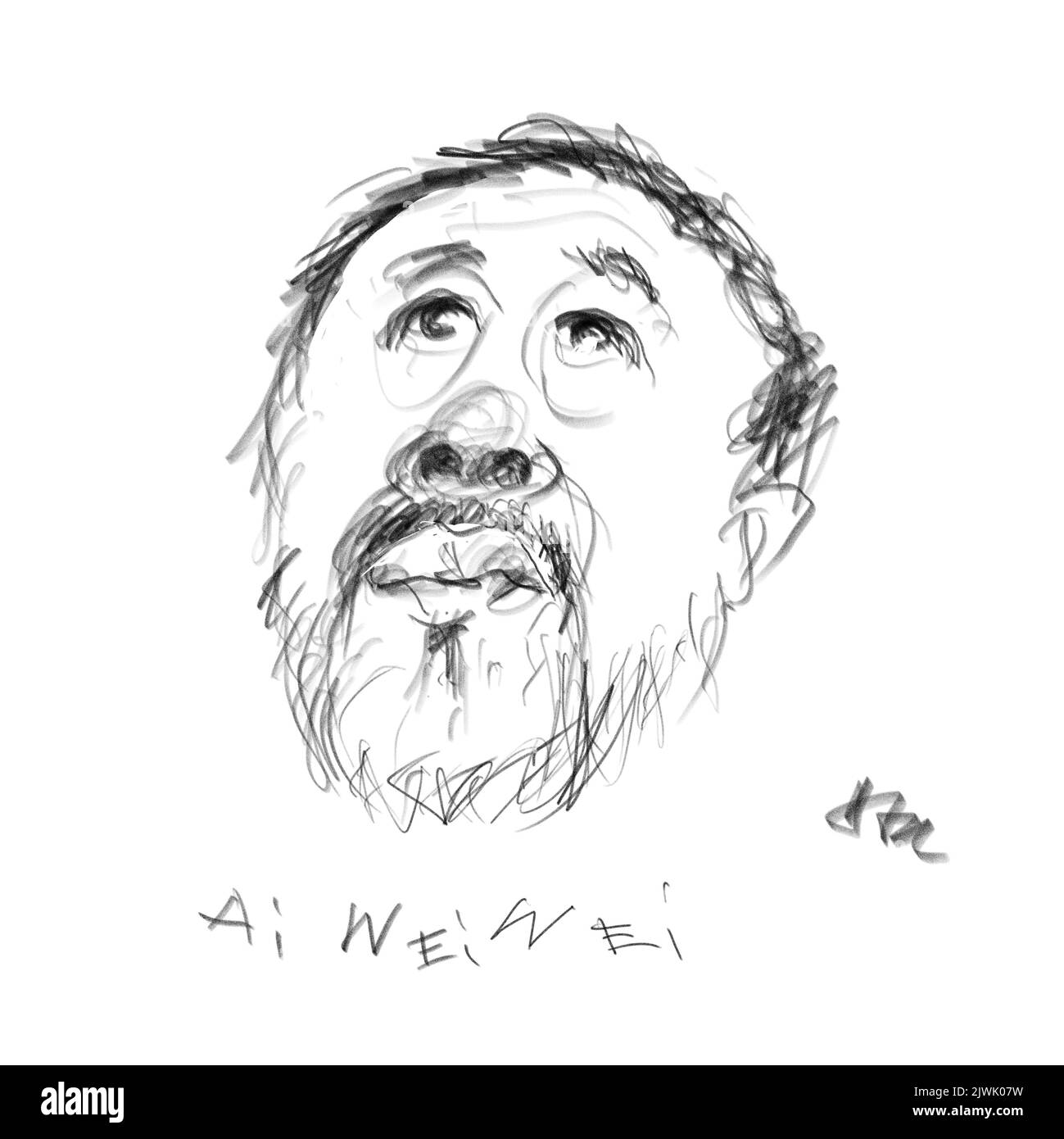 Portrait of the Artist Ai WeiWei Stock Photohttps://www.alamy.com/image-license-details/?v=1https://www.alamy.com/portrait-of-the-artist-ai-weiwei-image480463645.html
Portrait of the Artist Ai WeiWei Stock Photohttps://www.alamy.com/image-license-details/?v=1https://www.alamy.com/portrait-of-the-artist-ai-weiwei-image480463645.htmlRF2JWK07W–Portrait of the Artist Ai WeiWei
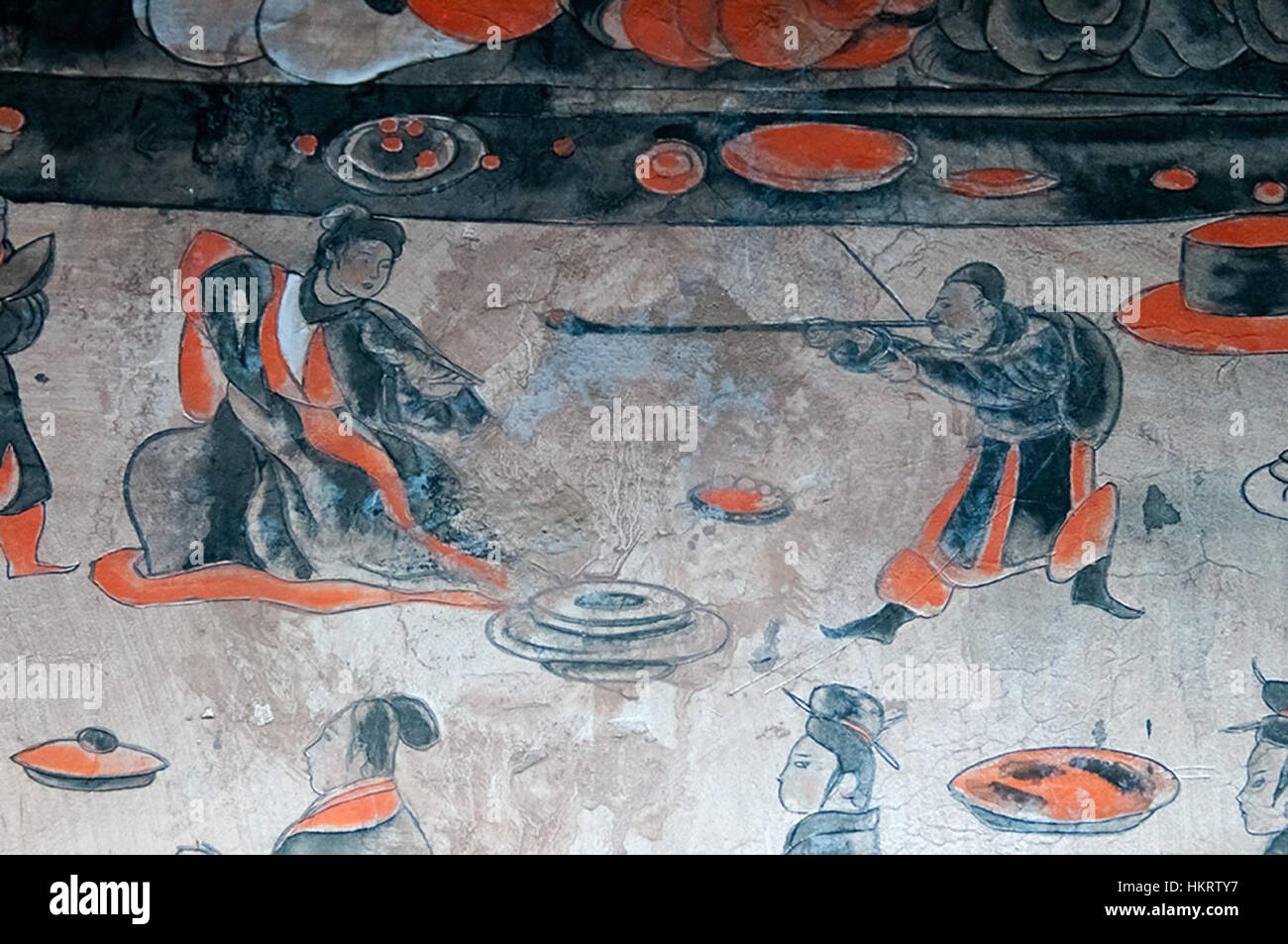 Dahuting mural detail of a dancer, Eastern Han Dynasty Stock Photohttps://www.alamy.com/image-license-details/?v=1https://www.alamy.com/stock-photo-dahuting-mural-detail-of-a-dancer-eastern-han-dynasty-132675515.html
Dahuting mural detail of a dancer, Eastern Han Dynasty Stock Photohttps://www.alamy.com/image-license-details/?v=1https://www.alamy.com/stock-photo-dahuting-mural-detail-of-a-dancer-eastern-han-dynasty-132675515.htmlRMHKRTY7–Dahuting mural detail of a dancer, Eastern Han Dynasty
 Maoling Mausoleum near Xian, Shaanxi Province, China. Ancient old stone carving of ox dates from Western Han Dynasty Stock Photohttps://www.alamy.com/image-license-details/?v=1https://www.alamy.com/stock-photo-maoling-mausoleum-near-xian-shaanxi-province-china-ancient-old-stone-11423418.html
Maoling Mausoleum near Xian, Shaanxi Province, China. Ancient old stone carving of ox dates from Western Han Dynasty Stock Photohttps://www.alamy.com/image-license-details/?v=1https://www.alamy.com/stock-photo-maoling-mausoleum-near-xian-shaanxi-province-china-ancient-old-stone-11423418.htmlRMA60TXK–Maoling Mausoleum near Xian, Shaanxi Province, China. Ancient old stone carving of ox dates from Western Han Dynasty
 Antique Chinese wedding ceremony in the style of Qin & Han Dynasties Stock Photohttps://www.alamy.com/image-license-details/?v=1https://www.alamy.com/antique-chinese-wedding-ceremony-in-the-style-of-qin-han-dynasties-image181214617.html
Antique Chinese wedding ceremony in the style of Qin & Han Dynasties Stock Photohttps://www.alamy.com/image-license-details/?v=1https://www.alamy.com/antique-chinese-wedding-ceremony-in-the-style-of-qin-han-dynasties-image181214617.htmlRFMER12H–Antique Chinese wedding ceremony in the style of Qin & Han Dynasties
 Han Dynasty vases sprayed with auto paint, part of Chinese artist Ai Wewei's 'Evidence' exhibition at the Martin Gropius-Bau, Berlin. Stock Photohttps://www.alamy.com/image-license-details/?v=1https://www.alamy.com/stock-photo-han-dynasty-vases-sprayed-with-auto-paint-part-of-chinese-artist-ai-140740660.html
Han Dynasty vases sprayed with auto paint, part of Chinese artist Ai Wewei's 'Evidence' exhibition at the Martin Gropius-Bau, Berlin. Stock Photohttps://www.alamy.com/image-license-details/?v=1https://www.alamy.com/stock-photo-han-dynasty-vases-sprayed-with-auto-paint-part-of-chinese-artist-ai-140740660.htmlRFJ4Y844–Han Dynasty vases sprayed with auto paint, part of Chinese artist Ai Wewei's 'Evidence' exhibition at the Martin Gropius-Bau, Berlin.
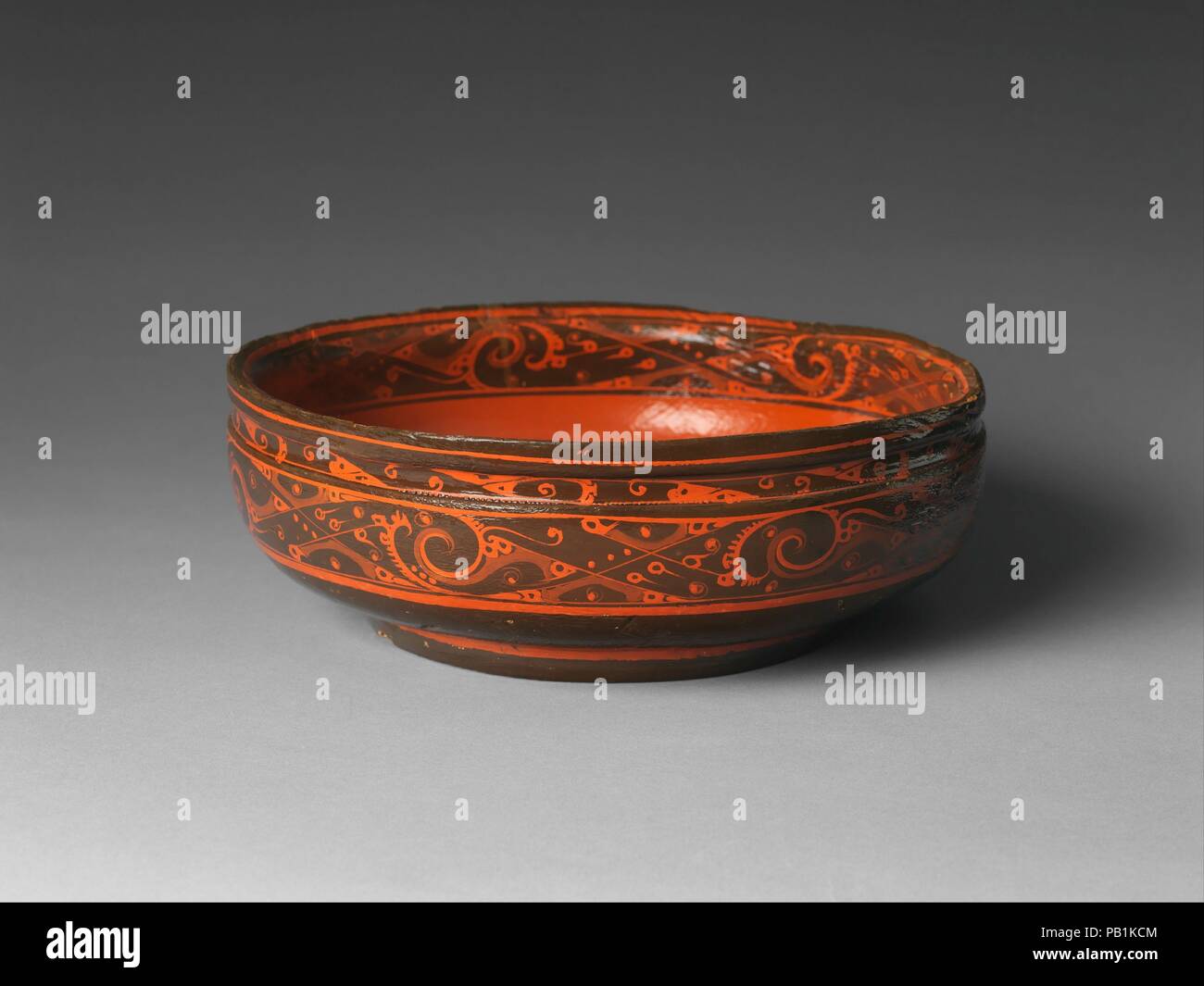 Bowl with Geometric Designs. Culture: China. Dimensions: H. 3 5/8 in. (9.2 cm); Diam. 10 7/16 in. (26.5 cm). Date: 2nd century B.C.. Likely used for serving a liquid such as wine or soup, this bowl is painted with dramatic swirling lines interlaced with small curls and other forms. Known as cloud energy, or yunqi, this design, which was pervasive during the Western Han dynasty, is understood to represent a forbidding but numinous realm inhabited by immortals. Museum: Metropolitan Museum of Art, New York, USA. Stock Photohttps://www.alamy.com/image-license-details/?v=1https://www.alamy.com/bowl-with-geometric-designs-culture-china-dimensions-h-3-58-in-92-cm-diam-10-716-in-265-cm-date-2nd-century-bc-likely-used-for-serving-a-liquid-such-as-wine-or-soup-this-bowl-is-painted-with-dramatic-swirling-lines-interlaced-with-small-curls-and-other-forms-known-as-cloud-energy-or-yunqi-this-design-which-was-pervasive-during-the-western-han-dynasty-is-understood-to-represent-a-forbidding-but-numinous-realm-inhabited-by-immortals-museum-metropolitan-museum-of-art-new-york-usa-image213322836.html
Bowl with Geometric Designs. Culture: China. Dimensions: H. 3 5/8 in. (9.2 cm); Diam. 10 7/16 in. (26.5 cm). Date: 2nd century B.C.. Likely used for serving a liquid such as wine or soup, this bowl is painted with dramatic swirling lines interlaced with small curls and other forms. Known as cloud energy, or yunqi, this design, which was pervasive during the Western Han dynasty, is understood to represent a forbidding but numinous realm inhabited by immortals. Museum: Metropolitan Museum of Art, New York, USA. Stock Photohttps://www.alamy.com/image-license-details/?v=1https://www.alamy.com/bowl-with-geometric-designs-culture-china-dimensions-h-3-58-in-92-cm-diam-10-716-in-265-cm-date-2nd-century-bc-likely-used-for-serving-a-liquid-such-as-wine-or-soup-this-bowl-is-painted-with-dramatic-swirling-lines-interlaced-with-small-curls-and-other-forms-known-as-cloud-energy-or-yunqi-this-design-which-was-pervasive-during-the-western-han-dynasty-is-understood-to-represent-a-forbidding-but-numinous-realm-inhabited-by-immortals-museum-metropolitan-museum-of-art-new-york-usa-image213322836.htmlRMPB1KCM–Bowl with Geometric Designs. Culture: China. Dimensions: H. 3 5/8 in. (9.2 cm); Diam. 10 7/16 in. (26.5 cm). Date: 2nd century B.C.. Likely used for serving a liquid such as wine or soup, this bowl is painted with dramatic swirling lines interlaced with small curls and other forms. Known as cloud energy, or yunqi, this design, which was pervasive during the Western Han dynasty, is understood to represent a forbidding but numinous realm inhabited by immortals. Museum: Metropolitan Museum of Art, New York, USA.
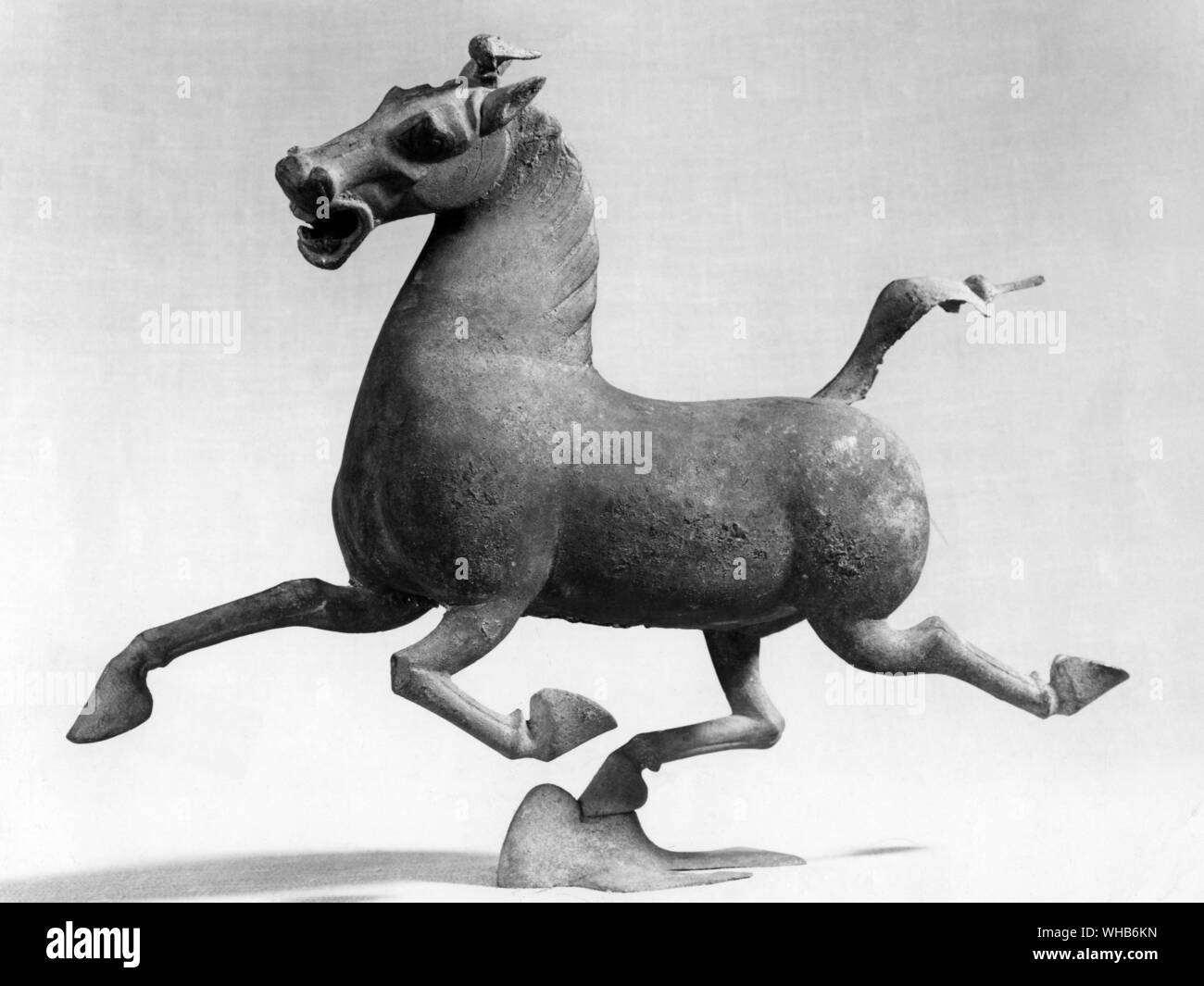 Bronze figure of a flying horse. China, VI.3 (vi) Xin to Easter Han 005202.031 -. Famous flying bronze horse and swallow from Eastern Han dynasty (206 BC to 220 AD). The original bronze piece was discovered in 1969, when villagers in the small town of Leitai, in Wuwei County, Gansu Province discovered an ancient tomb while digging foundations. Among the more than 200 relics found in the tomb, was the Flying Horse and Swallow. The horse's hoof is raised high as the startled swallow sets off the neighing, cleverly pivoting horse. In the early 1970s, replicas from Taiwan flooded the market, but Stock Photohttps://www.alamy.com/image-license-details/?v=1https://www.alamy.com/bronze-figure-of-a-flying-horse-china-vi3-vi-xin-to-easter-han-005202031-famous-flying-bronze-horse-and-swallow-from-eastern-han-dynasty-206-bc-to-220-ad-the-original-bronze-piece-was-discovered-in-1969-when-villagers-in-the-small-town-of-leitai-in-wuwei-county-gansu-province-discovered-an-ancient-tomb-while-digging-foundations-among-the-more-than-200-relics-found-in-the-tomb-was-the-flying-horse-and-swallow-the-horses-hoof-is-raised-high-as-the-startled-swallow-sets-off-the-neighing-cleverly-pivoting-horse-in-the-early-1970s-replicas-from-taiwan-flooded-the-market-but-image268851401.html
Bronze figure of a flying horse. China, VI.3 (vi) Xin to Easter Han 005202.031 -. Famous flying bronze horse and swallow from Eastern Han dynasty (206 BC to 220 AD). The original bronze piece was discovered in 1969, when villagers in the small town of Leitai, in Wuwei County, Gansu Province discovered an ancient tomb while digging foundations. Among the more than 200 relics found in the tomb, was the Flying Horse and Swallow. The horse's hoof is raised high as the startled swallow sets off the neighing, cleverly pivoting horse. In the early 1970s, replicas from Taiwan flooded the market, but Stock Photohttps://www.alamy.com/image-license-details/?v=1https://www.alamy.com/bronze-figure-of-a-flying-horse-china-vi3-vi-xin-to-easter-han-005202031-famous-flying-bronze-horse-and-swallow-from-eastern-han-dynasty-206-bc-to-220-ad-the-original-bronze-piece-was-discovered-in-1969-when-villagers-in-the-small-town-of-leitai-in-wuwei-county-gansu-province-discovered-an-ancient-tomb-while-digging-foundations-among-the-more-than-200-relics-found-in-the-tomb-was-the-flying-horse-and-swallow-the-horses-hoof-is-raised-high-as-the-startled-swallow-sets-off-the-neighing-cleverly-pivoting-horse-in-the-early-1970s-replicas-from-taiwan-flooded-the-market-but-image268851401.htmlRMWHB6KN–Bronze figure of a flying horse. China, VI.3 (vi) Xin to Easter Han 005202.031 -. Famous flying bronze horse and swallow from Eastern Han dynasty (206 BC to 220 AD). The original bronze piece was discovered in 1969, when villagers in the small town of Leitai, in Wuwei County, Gansu Province discovered an ancient tomb while digging foundations. Among the more than 200 relics found in the tomb, was the Flying Horse and Swallow. The horse's hoof is raised high as the startled swallow sets off the neighing, cleverly pivoting horse. In the early 1970s, replicas from Taiwan flooded the market, but
 The God beast lamp Nanjing museum Jiangsu China Stock Photohttps://www.alamy.com/image-license-details/?v=1https://www.alamy.com/stock-photo-the-god-beast-lamp-nanjing-museum-jiangsu-china-135873686.html
The God beast lamp Nanjing museum Jiangsu China Stock Photohttps://www.alamy.com/image-license-details/?v=1https://www.alamy.com/stock-photo-the-god-beast-lamp-nanjing-museum-jiangsu-china-135873686.htmlRFHW1G7J–The God beast lamp Nanjing museum Jiangsu China
 Polychrome Glazed Pottery Horse 618 - 907 AD Tang Han Dynasty ( Shanghai Museum of ancient Chinese art ) China Stock Photohttps://www.alamy.com/image-license-details/?v=1https://www.alamy.com/stock-photo-polychrome-glazed-pottery-horse-618-907-ad-tang-han-dynasty-shanghai-88429985.html
Polychrome Glazed Pottery Horse 618 - 907 AD Tang Han Dynasty ( Shanghai Museum of ancient Chinese art ) China Stock Photohttps://www.alamy.com/image-license-details/?v=1https://www.alamy.com/stock-photo-polychrome-glazed-pottery-horse-618-907-ad-tang-han-dynasty-shanghai-88429985.htmlRMF3T99N–Polychrome Glazed Pottery Horse 618 - 907 AD Tang Han Dynasty ( Shanghai Museum of ancient Chinese art ) China
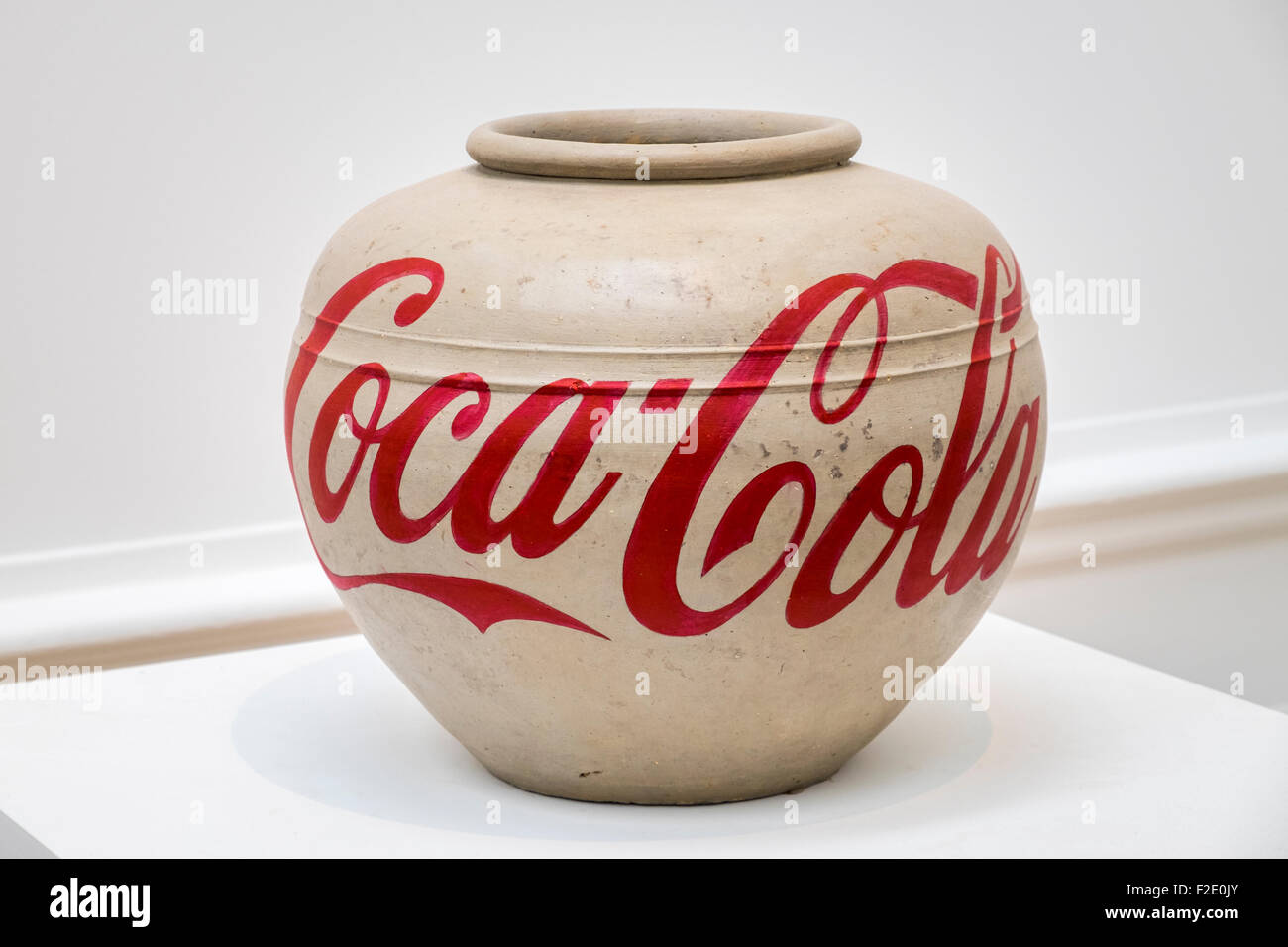 Ai Weiwei, Han Dynasty Coca-Cola Vase with paint at the Royal Academy of Arts Exhibition Stock Photohttps://www.alamy.com/image-license-details/?v=1https://www.alamy.com/stock-photo-ai-weiwei-han-dynasty-coca-cola-vase-with-paint-at-the-royal-academy-87589011.html
Ai Weiwei, Han Dynasty Coca-Cola Vase with paint at the Royal Academy of Arts Exhibition Stock Photohttps://www.alamy.com/image-license-details/?v=1https://www.alamy.com/stock-photo-ai-weiwei-han-dynasty-coca-cola-vase-with-paint-at-the-royal-academy-87589011.htmlRMF2E0JY–Ai Weiwei, Han Dynasty Coca-Cola Vase with paint at the Royal Academy of Arts Exhibition
 Eastern Han Dynasty, figurines of gods, Yin and Mao. Yin is a god with the head of a tiger and a human body, Mao is a god with the head of a rabbit and a human body. Stock Photohttps://www.alamy.com/image-license-details/?v=1https://www.alamy.com/eastern-han-dynasty-figurines-of-gods-yin-and-mao-yin-is-a-god-with-the-head-of-a-tiger-and-a-human-body-mao-is-a-god-with-the-head-of-a-rabbit-and-a-human-body-image481969416.html
Eastern Han Dynasty, figurines of gods, Yin and Mao. Yin is a god with the head of a tiger and a human body, Mao is a god with the head of a rabbit and a human body. Stock Photohttps://www.alamy.com/image-license-details/?v=1https://www.alamy.com/eastern-han-dynasty-figurines-of-gods-yin-and-mao-yin-is-a-god-with-the-head-of-a-tiger-and-a-human-body-mao-is-a-god-with-the-head-of-a-rabbit-and-a-human-body-image481969416.htmlRM2K03GWC–Eastern Han Dynasty, figurines of gods, Yin and Mao. Yin is a god with the head of a tiger and a human body, Mao is a god with the head of a rabbit and a human body.
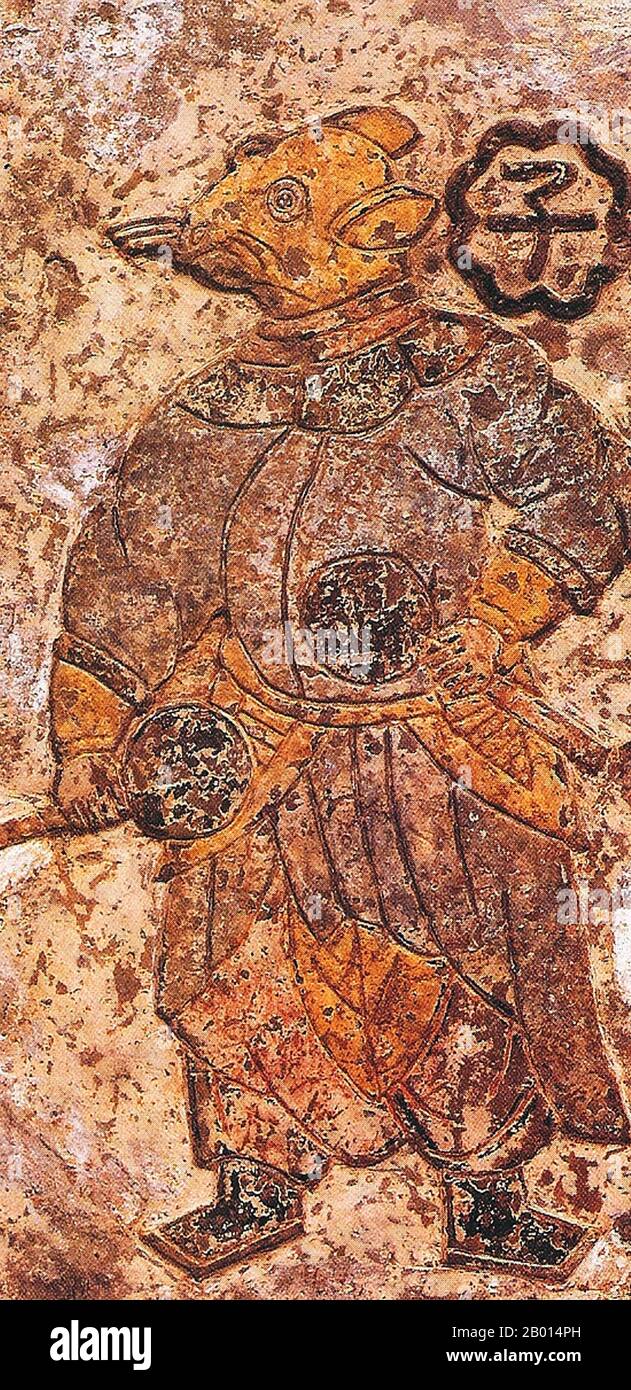 China: Guardian Deity of Midnight, ceramic tile painting, Han Dynasty (202 BCE - 220 CE). Painting on a ceramic tile from the Chinese Han Dynasty. This figure, wearing Han Dynasty robes, represents the Guardian Spirit of Midnight (from 11 pm to 1 am). Stock Photohttps://www.alamy.com/image-license-details/?v=1https://www.alamy.com/china-guardian-deity-of-midnight-ceramic-tile-painting-han-dynasty-202-bce-220-ce-painting-on-a-ceramic-tile-from-the-chinese-han-dynasty-this-figure-wearing-han-dynasty-robes-represents-the-guardian-spirit-of-midnight-from-11-pm-to-1-am-image344233081.html
China: Guardian Deity of Midnight, ceramic tile painting, Han Dynasty (202 BCE - 220 CE). Painting on a ceramic tile from the Chinese Han Dynasty. This figure, wearing Han Dynasty robes, represents the Guardian Spirit of Midnight (from 11 pm to 1 am). Stock Photohttps://www.alamy.com/image-license-details/?v=1https://www.alamy.com/china-guardian-deity-of-midnight-ceramic-tile-painting-han-dynasty-202-bce-220-ce-painting-on-a-ceramic-tile-from-the-chinese-han-dynasty-this-figure-wearing-han-dynasty-robes-represents-the-guardian-spirit-of-midnight-from-11-pm-to-1-am-image344233081.htmlRM2B014PH–China: Guardian Deity of Midnight, ceramic tile painting, Han Dynasty (202 BCE - 220 CE). Painting on a ceramic tile from the Chinese Han Dynasty. This figure, wearing Han Dynasty robes, represents the Guardian Spirit of Midnight (from 11 pm to 1 am).
 Bronze figure of a flying horse from the Eastern Han dynasty 2nd century AD 24 5 cm high 45 cm long excavated in 1969 at Wu wei Stock Photohttps://www.alamy.com/image-license-details/?v=1https://www.alamy.com/bronze-figure-of-a-flying-horse-from-the-eastern-han-dynasty-2nd-century-image99545.html
Bronze figure of a flying horse from the Eastern Han dynasty 2nd century AD 24 5 cm high 45 cm long excavated in 1969 at Wu wei Stock Photohttps://www.alamy.com/image-license-details/?v=1https://www.alamy.com/bronze-figure-of-a-flying-horse-from-the-eastern-han-dynasty-2nd-century-image99545.htmlRMA184D9–Bronze figure of a flying horse from the Eastern Han dynasty 2nd century AD 24 5 cm high 45 cm long excavated in 1969 at Wu wei